November 21 - 27, 2021: Issue 519
Pittwater Summer Houses: Gunjulla, Avalon Beach-Clareville
AVALON.
Pearling waves that cream milk-white,
Sun-drenched sands and skies of blue
Linger in my memory -
Avalon, my heart's with you!
DOROTHEA DOWLING.
AVALON. (1935, May 4). The Sydney Morning Herald (NSW : 1842 - 1954), p. 11. Retrieved from http://nla.gov.au/nla.news-article17151649
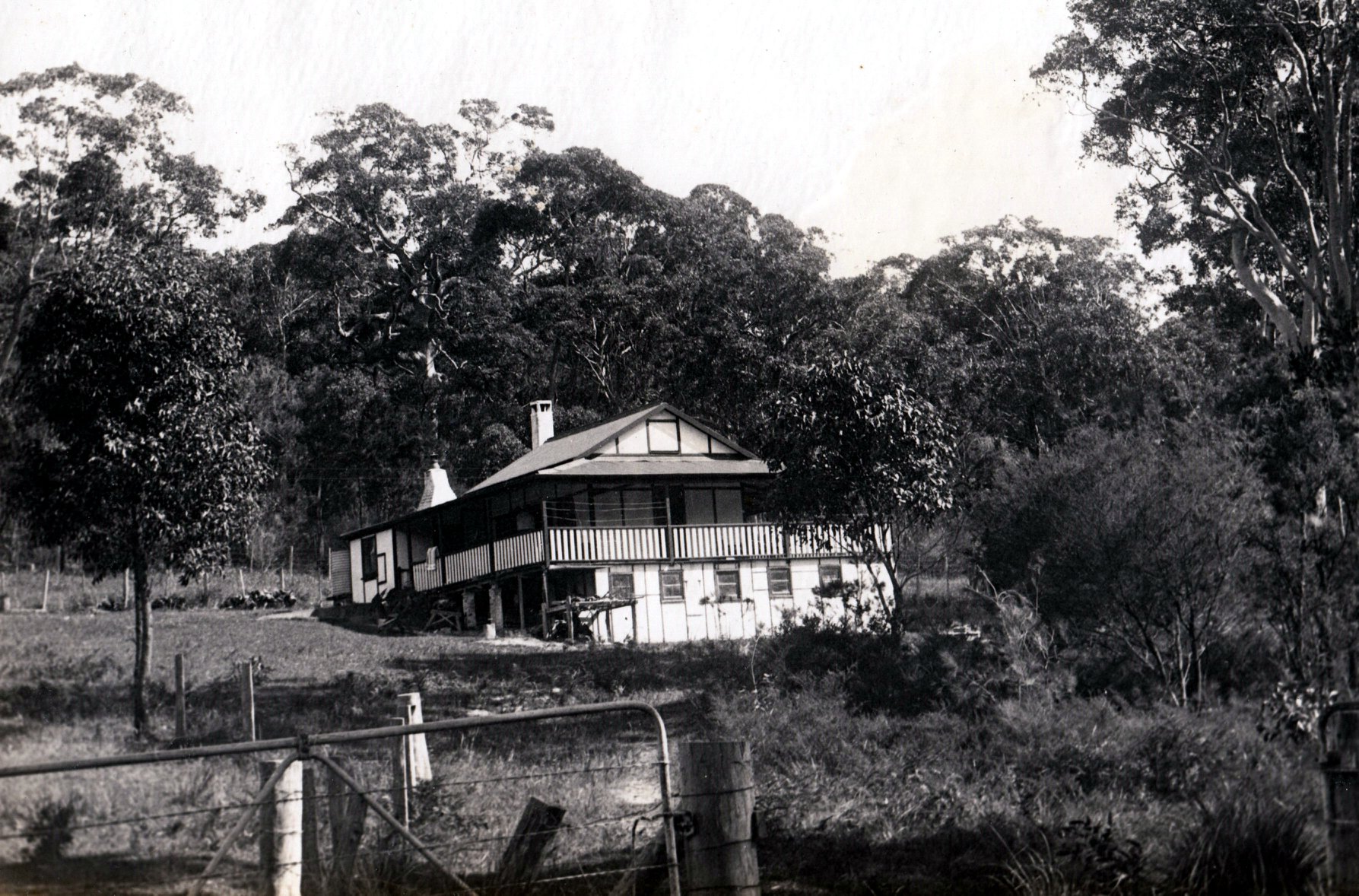
PITTWATER and CAREEL COVE.
The whole of the residue of
THE PITTWATER ESTATE.
Also,
STOKES POINT, which is now subdivided into VILLA SITES, fronting CAREEL COVE
and PITTWATER.
adjoining the Township of BRIGHTON, PITTWATER.
RICHARDSON and WRENCH have received instructions to sell by public auction, at the Rooms, Pitt-street, on MONDAY, 16th May, at 11 o'clock, The whole of the unsold lots of
THE PITTWATER ESTATE, as follows :
NORTH DIVISION.
TWO CHOICE FARMS.
No. III. Area. 128 ACRES 1 ROOD .14 PERCHES, having frontages to the PACIFIC OCEAN and the MAIN ROAD to BARRENJOEY, on which is the HOMESTEAD and, RESIDENCE now in the occupation of JOHN COLLINS, Esq.. and also the CELEBRATED CAVE.
No. IV. Area, 65 ACRES and 32 PRRCHES, adjoining the above, and which are the WELL-KNOWN SPRINGS.
SUBURBAN SITES.
Nos. 8 to 16 and 10 and 20, surrounding the TOWNSHIP OF BRIGHTON, in areas from 2 ACRES 3 ROODS 35 PERCHES to 9 ACRES 3 ROODS 10 PERCHES, having frontages to the MAIN PITTWATER ROAD and other roads and streets, all 1 chain wide.
Nos. 1A and 2A. Areas. 5 ACRES 3 ROODS 21 PERCHES and 7 ACRES 34 PERCHES respectively, overlooking PITTWATER.
SOUTH DIVISION.
Nos. IV. and V. TWO FINE FARMS, areas 97 ACRES 3 ROODS 17 PERCHES, and 91 ACRES 2 ROODS 9 PERCHES respectively.
No. VI. A FARM of 127 ACRES 3 ROODS 29 PERCHES, near SALTPAN COVE and the TOWNSHIP of NEWPORT.
Lots 5 to 8 and 5A to 8A. EIGHT CHOICE VILLA SITES in PITTWATER, fronting LONG BEACH ; areas from 4 ACRES 2 ROODS 10 PERCHES to 17 ACRES 27 PERCHES.
Lots 9 and 11. TWO SMALL FARMS in REFUGE BAY; areas. 25 ACRES 1 ROOD 6 PERCHES, and 11 ACRES 1 ROOD 24 PERCHES.
Lots 16 to 21, and 24 and 25. S GRAND BLOCKS of RICH SOIL in CABBAGE-TREE VALE, on BILGOLA BEACH : areas, from 5 ACRES 2 ROODS 36 PERCHES to 21 ACRES 1 ROOD.
Lot 26. A SMALL FARM, fronting the RECREATION RESERVE on OCEAN BEACH ; area, 12 ACRES 3 ROODS 8 PERCHES.
STOKES' POINT, PITTWATER.
ADJOINING THE TOWN OF BRIGHTON, AT THE STEAMERS WHARF.
The whole of this Magnificent Point will be submitted in lots, as per lithograph, now published, viz..
Section A. 15 VILLA SITES; areas. 3 ROODS 17 PERCHES to 2 ACRES 20 PERCHES.
Section B. 14 VILLA SITES : areas. 1 ACRE 10 PERCHES to 6 ACRES 3 ROODS 32 PERCHES
Section C. 9 VILLA SITES. CAREEL BAY ; areas. 1 ACRE 3 ROODS 34 PERCHER to 4 ACRES 21, PERCHES
Section D. WATER FRONTAGE SITES; areas. 2 ACRES to 4 ACRES 21 PERCHFS. PITTWATER HARBOUR
Section E. 10 VILLA SITES, adjoining the TOWN OF BRIGHTON : areas. 1 ACRE 11 PERCHES to 4 ACRES 1 ROOD 23 PERCHES.
This subdivision is well worthy of attention, as there is no doubt that PITTWATER will become an important and attractive resort for our BUSINESS MEN requiring CHANGE OF AIR, QUIET, and REST from the busy turmoil of the city.
The communication between the city and Pittwater is now more frequent than formerly, besides having the coaches daily from MANLY BEACH, there are now commodious fast steamers plying regularly from the city.
The NORTHERN RAILWAY will pass within 7 miles of CAREEL COVE at Pittwater.
TERMS EXCEEDINGLY LIBERAL AT SALE.
LITHOGRAPHS are now READY FOR DISTRIBUTION.
Messrs. ELLIS and MAKINSON, Elizabeth-street, are Solicitors of the vendors. Day of Sale, MONDAY NEXT. Advertising (1881, May 12). The Sydney Morning Herald (NSW : 1842 - 1954), p. 9. Retrieved from http://nla.gov.au/nla.news-article13479502
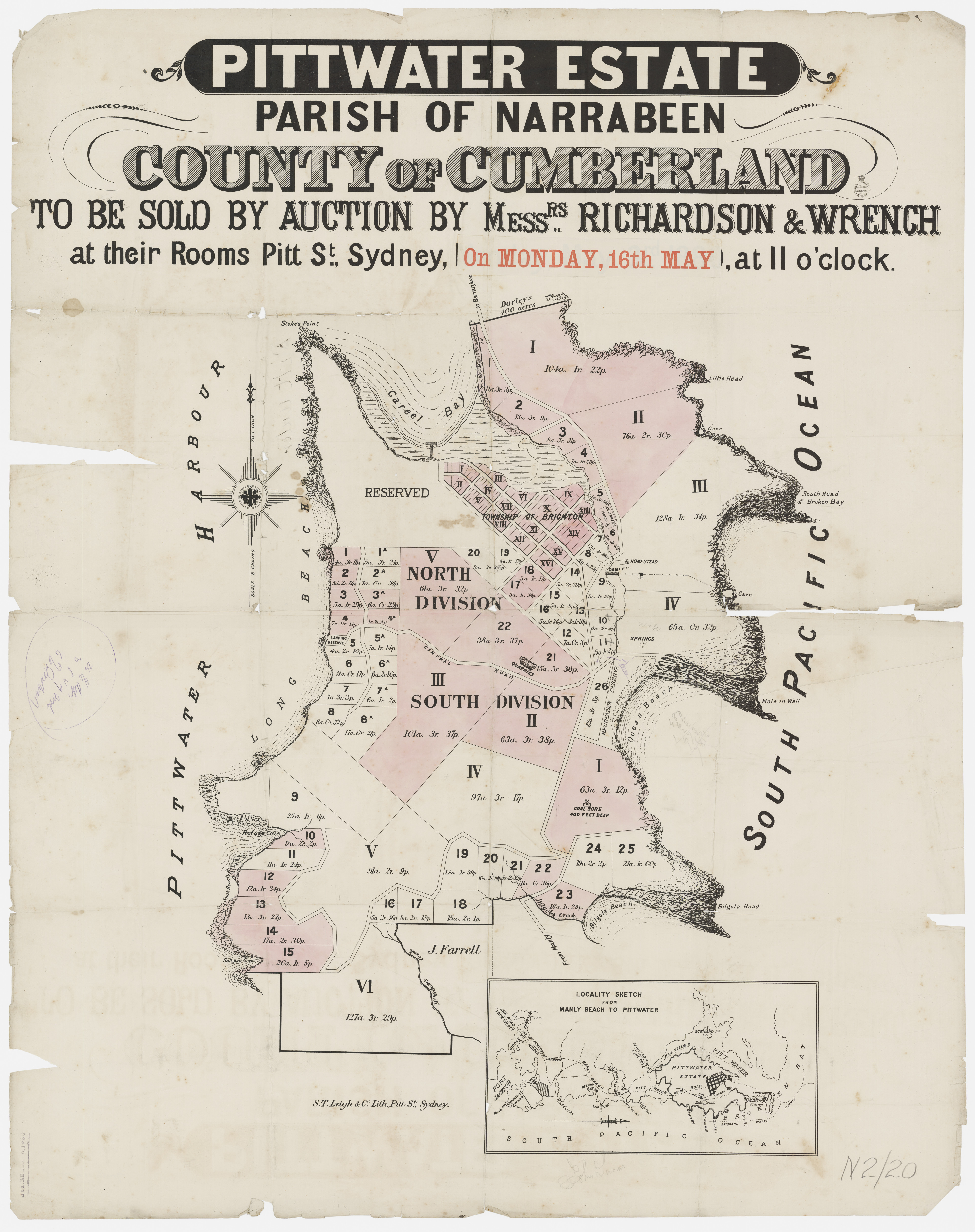
Pittwater Estate Monday May 16th, 1881 - Richardson and Wrench - Item c050370020, courtesy State Library of New South Wales.
It was unanimously decided to place the seal of the council to a document from the trustees of the late Father Terrey's Estate, dedicating to the council a 20 acre reserve, including the whole of the beach on "Priest's Flat," Barrenjoey Peninsula. This land was left for a reserve some 25 years ago, when the Pittwater Estate was being cut up, but was never dedicated, and the Registrar-General would not recognise it as such. After considerable trouble the dedication was arranged, without expense to the council, and the shire deserves congratulation on the result of their negotiations. Warringah Items. (1912, March 8). The Land (Sydney, NSW : 1911 - 1954), p. 9. Retrieved from http://nla.gov.au/nla.news-article102916271
HORNING - Suddenly (23rd instant), at Risingholme, Pittwater, Frederick Arnold, youngest surviving son of the late William Horning, of Sydney, and Mrs. Henry Allan, Kelvin, Ridge street, North Sydney. Family Notices (1912, January 26). The Sydney Morning Herald(NSW : 1842 - 1954), , p. 6. Retrieved from http://nla.gov.au/nla.news-article15305288
PITTWATER.
By Order of the Trustees in the Deceased Estate of Frederick Arnold Horning on the Property known as Risingholme Clareville via Newport
SATURDAY 3rd FEBRUARY AT 2.3O SHARP
Motor Launch will leave Newport day of Sale at ...
UNRESERVED SALE
Of all Stock Plant, and Building Material on the Property Comprising -
Powerful heavy Grey Heavy Draught horse 7 years Tip Dray and Harness Hogskin Saddle and Bridle 2 well bred Jersey Cows in full milk Roan Bull (selected for breeding and soundness)
Plough Scantier Harness Sundry Farming Implements about 2 tons Lucerne Hay Quantity of
Bran Chaff and Pollard.
Full Set Carpenter's Tools.
Highest Grade Building Material for a 4-roomed cottage (just landed for erection) comprising Galvanised Iron Hardwood flooring and Weatherboards Fibro Cement Sheets Doors and Window Sashes Bolts, Nails, and Screws 2 G L Tanks 800 and 1000 gallons *
Sundry Household Furniture and Kitchen Utensils Incubator Grindstone Fodder Cases tin lined etc.
DJ MCINTYRE and CO Auctioneers, 20 Castlereagh street, city have been instructed by the
Trustees of the Estate of Frederick Arnold Horning (deceased) to hold an Unreserved Auction
Sale of the whole of the Personal Estate on the Property
AS ABOVE. TERMS CASH
The auctioneers can personally vouch for the absolutely genuine character of this Sale the Plant, Holding Materials Tools etc. having only been purchased a month or two and must be cleared off the land
The Property known as "Risingholme " Clareville via Newport comprising 101 acres, the pick of the whole district for soil and beauty- of situation will also be offered by Auction on the Ground prior to Sale of Effects.
See Property Auction Advts.
THE KOHINOOR* OF PITTWATER.
Practically "The Gem of the Pacific Ocean.
On the Property known as "RISINGHOLME” Clareville, via Newport
SATURDAY 3rd FEBRUARY, at 2.30 sharp. Motor Launch will leave Newport day of Sale at 1.45 pm. ,
101 ACRES THE PICK of the whole district for soil and beauty of situation. An old identity states that nothing in the district can be compared with it for subdivision purposes or as an ideal
MARINE HOME
DJ M INTYRE and CO Auctioneers ...have been instructed by the Trustees of Frederick Arnold Horning deceased to
hold an Auction Sale on the Ground of the above described Valuable Property. Advertising (1912, January 26). The Sydney Morning Herald (NSW : 1842 - 1954), , p. 11. Retrieved from http://nla.gov.au/nla.news-article15305262
Geoff provides:
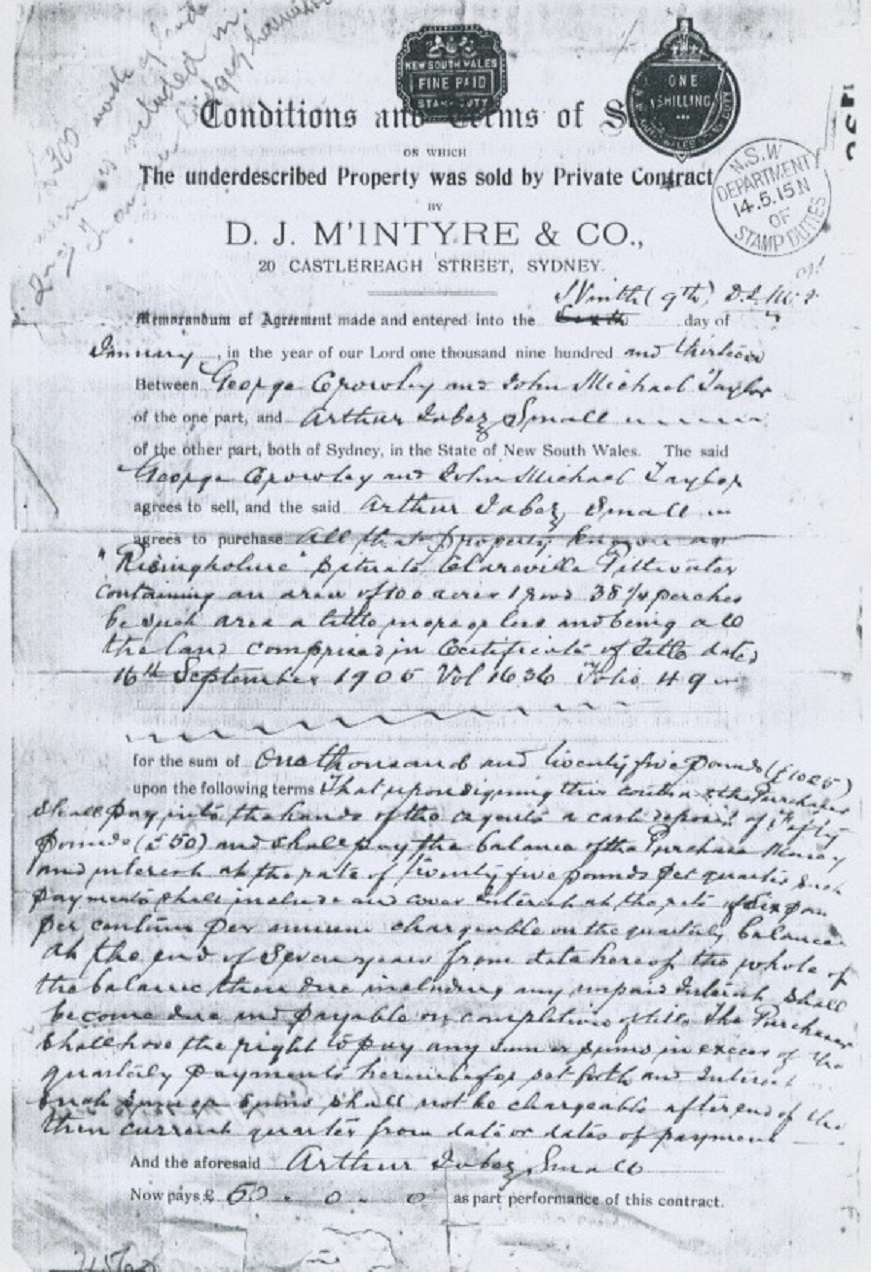
This holding had been brought under the Real Property Act by a Margaret Allan prior to her selling it in 1912 to George Crowley
No. 13,259. County of Cumberland, parish of Narrabeen, 101 acres 1 rood 381 perches, situated on Clareville Wharf Road, Clareville,—is Block No. 3, South Subdivision, Pittwater Estate, and is part of 1,200 acres (portion No. 20 of parish) granted to John Joseph Therry; adjoining the properties of F. Burne, J. Robertson, S. Smith, and G. A. Smith, Trustees of Mrs. Evans, or J. G. Cousins, G. Holland, The London Bank of Australia, and J. H. Parry. – Applicant: Margaret Allan, Mosman. Day until which Caveats may be lodged: 17th February, 1905. NOTICE UNDER REAL PROPERTY ACT. (1904, December 30). Government Gazette of the State of New South Wales (Sydney, NSW : 1901 - 2001), p. 9437. Retrieved from http://nla.gov.au/nla.news-article226488010
From HRLV:
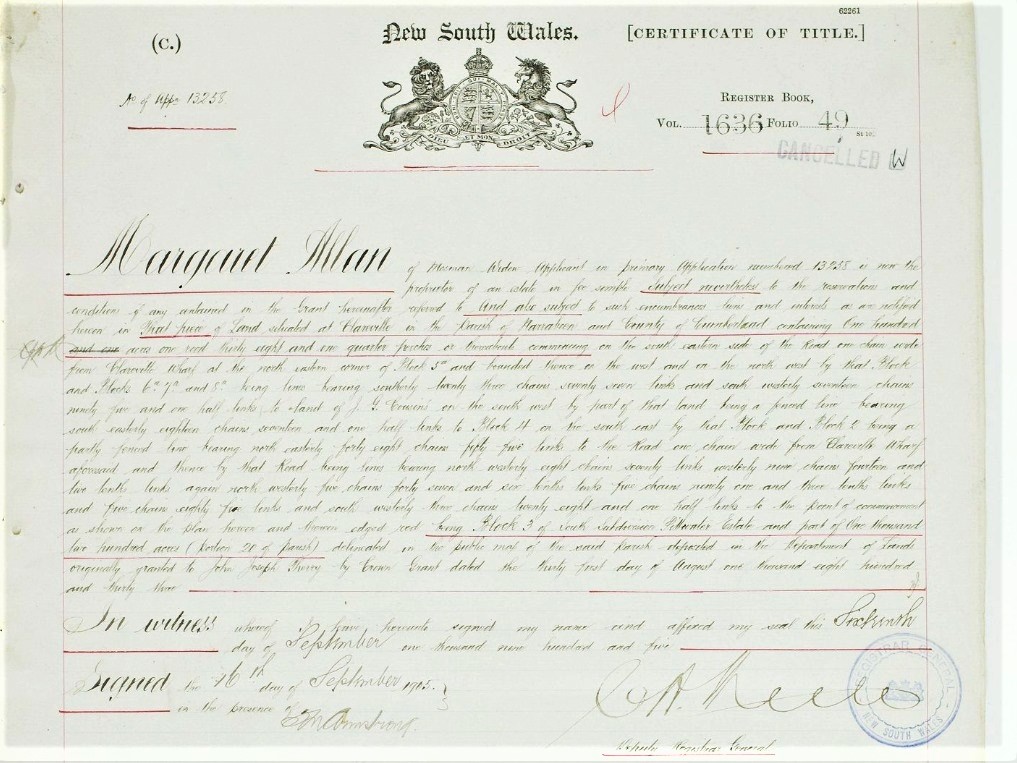
%20Margaret%20Allan%20to%20George%20Crowley.jpg?timestamp=1637204160585)
George Crowley put some of this land up for sale in September 1912 (Block III, Portion 20) and then onsold what was left to Arthur Jabez Small in 1915 - the State Library of NSW Avalon subdivisions folder and the HRLV provides
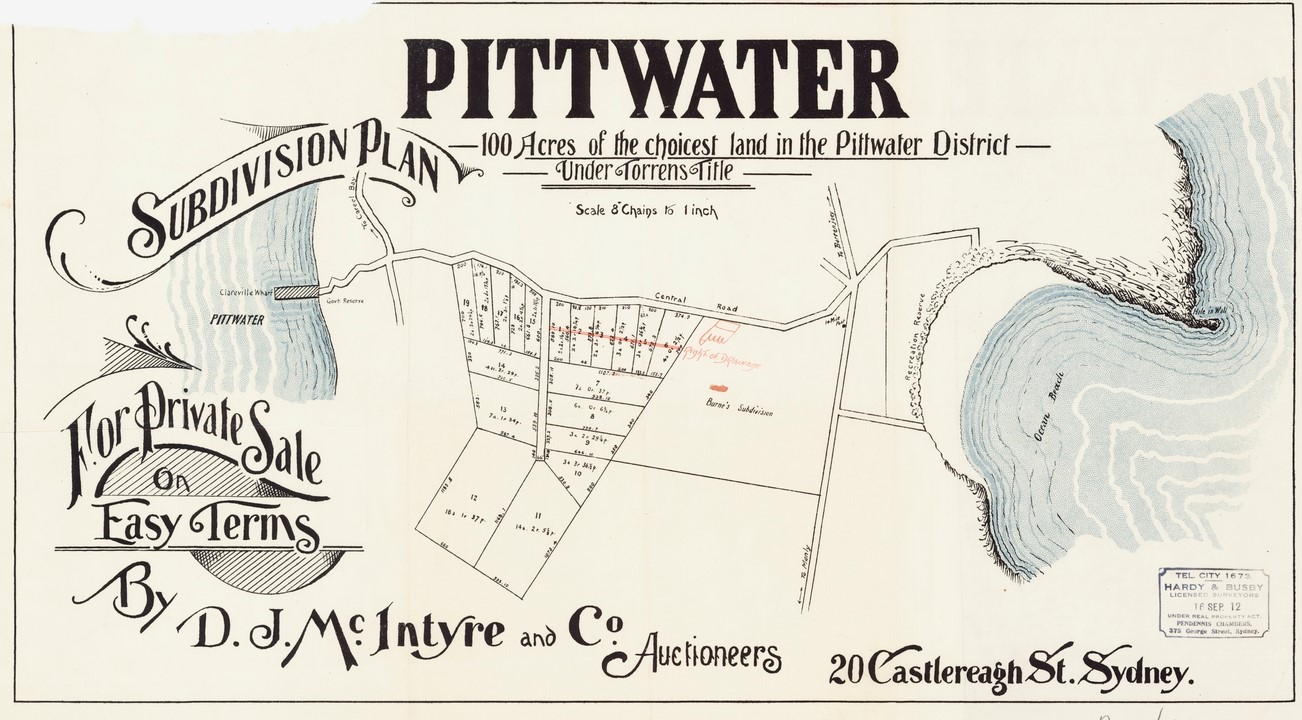
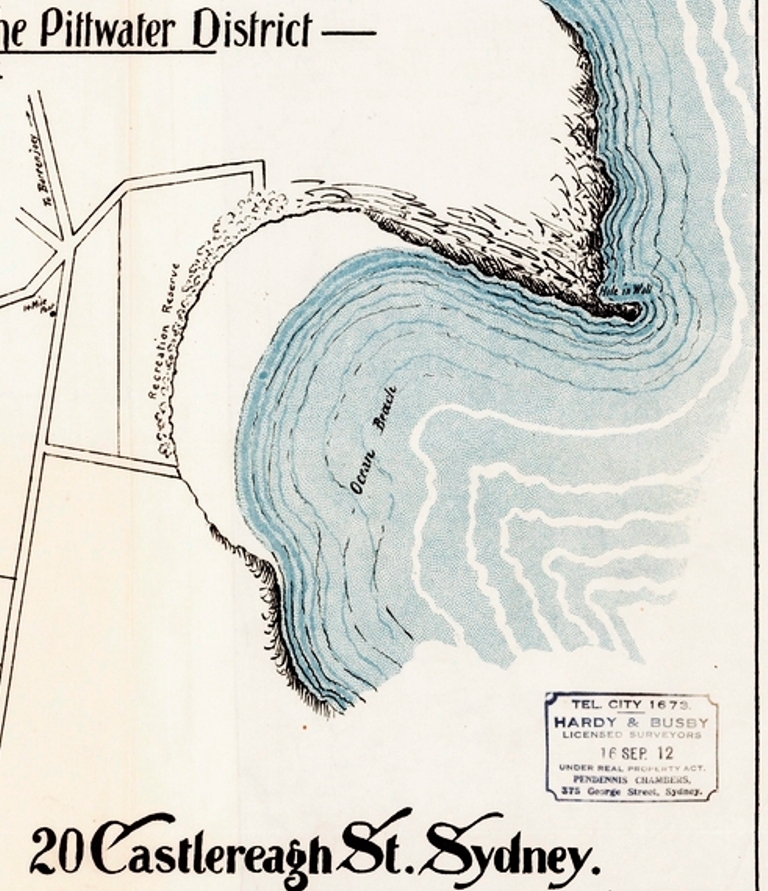
Avalon subdivision plans, September 16, 1912. Image No.: c027560011h, courtesy State Library of New South Wales
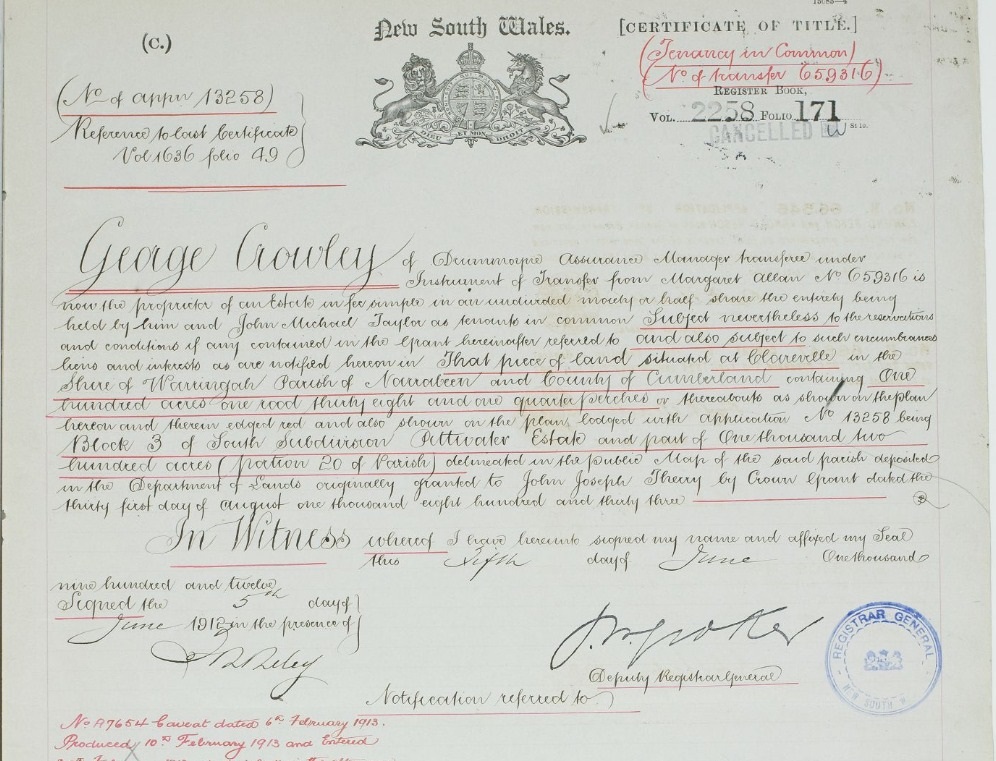
%20George%20Crowley%20Block%20III%20portion%2020.jpg?timestamp=1637204683245)
Arthur Jabez Small began selling blocks of land in 1915, with the first one sold on October 15, 1915 to Frederick William Tyrer - HRLV provides those who these blocks sold to between 1915 and 1920, showing that some people came back and bought more blocks - many of these were acreage size:
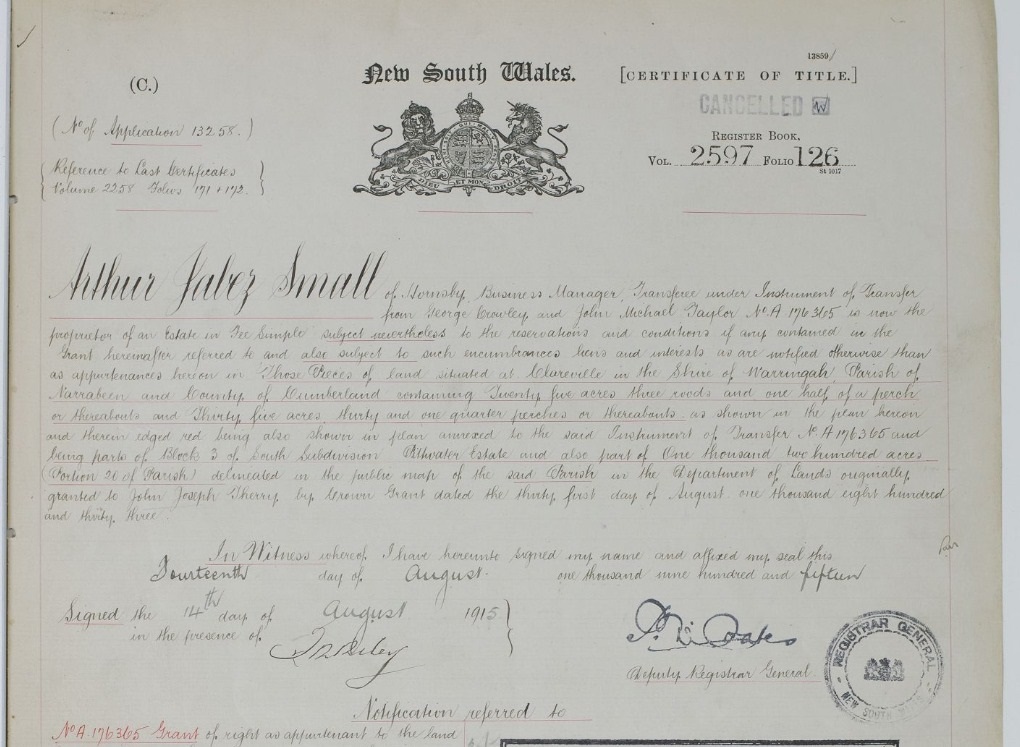
%20A%20J%20Small%20Allan%20Land.jpg?timestamp=1637206268557)
%20A%20J%20Small%20Allan%20Land.jpg?timestamp=1637206371845)
%20A%20J%20Small%20Allan%20Land.jpg?timestamp=1637206408257)
%20A%20J%20Small%20Allan%20Land.jpg?timestamp=1637206443734)
%20A%20J%20Small%20Allan%20Land.jpg?timestamp=1637206480596)
%20A%20J%20Small%20Allan%20Land.jpg?timestamp=1637206509443)
%20A%20J%20Small%20Allan%20Land.jpg?timestamp=1637206544915)
%20A%20J%20Small%20Allan%20Land.jpg?timestamp=1637206580111)
One of the earlier land sales advertised by Arthur Jabez Small of the land acquired precedes the name of 'Avalon' itself.
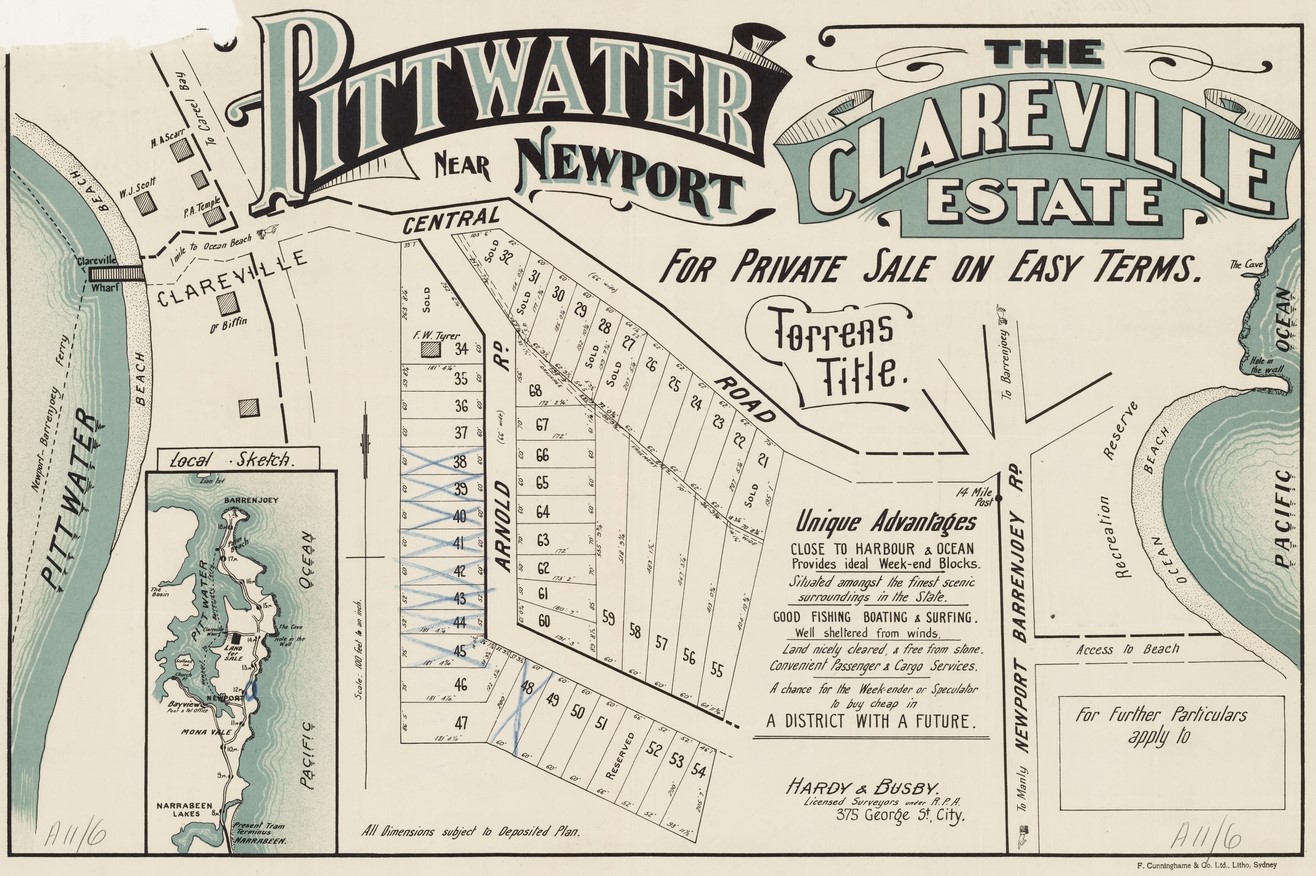
Avalon Subdivisions - Clareville Estate Pittwater - Arnold Road, Central Road, Item No.: c027560007h, courtesy State Library of N.S.W. - Arnold Road was possibly named for the owner Frederick ARNOLD Horning.
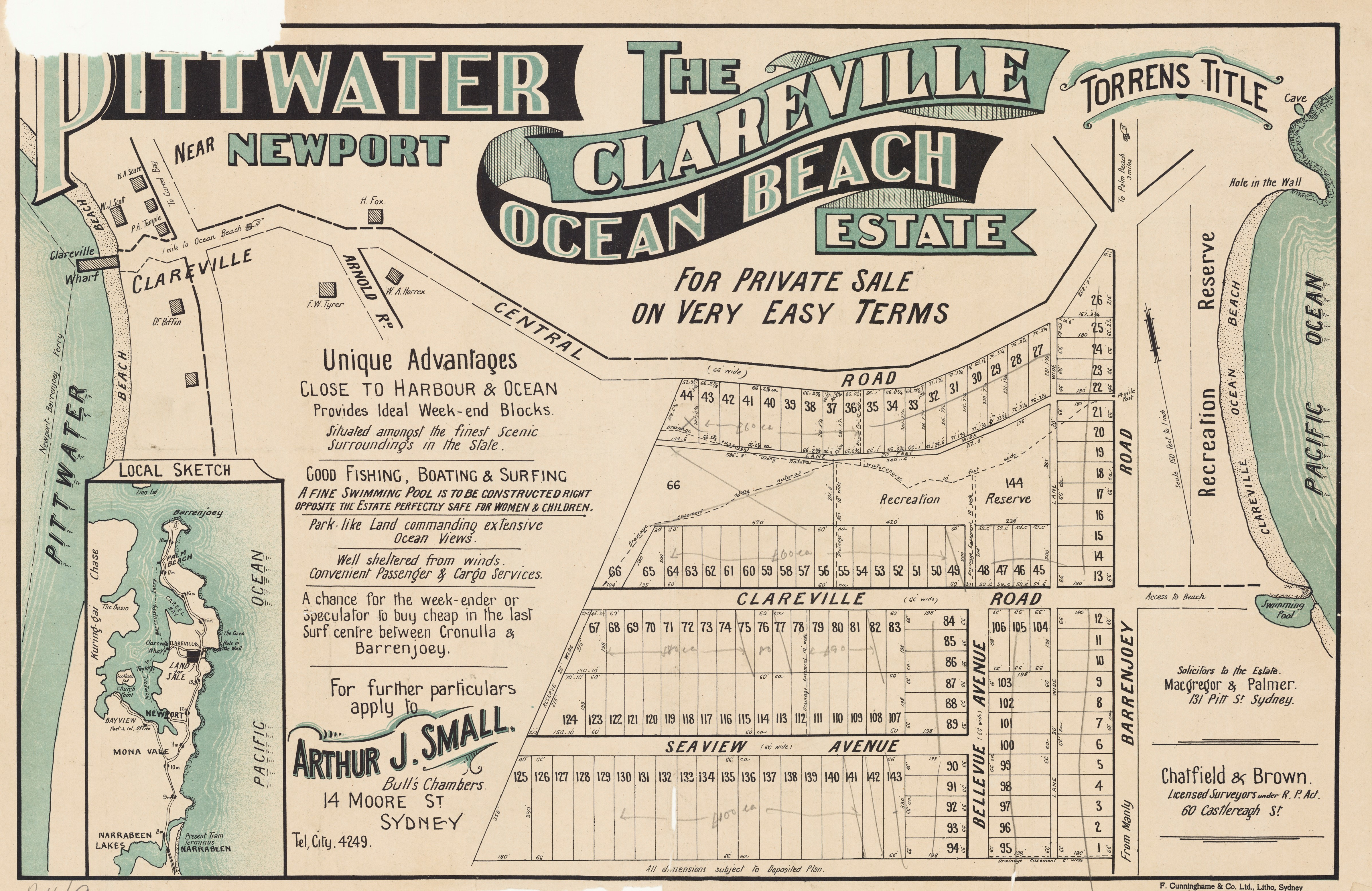
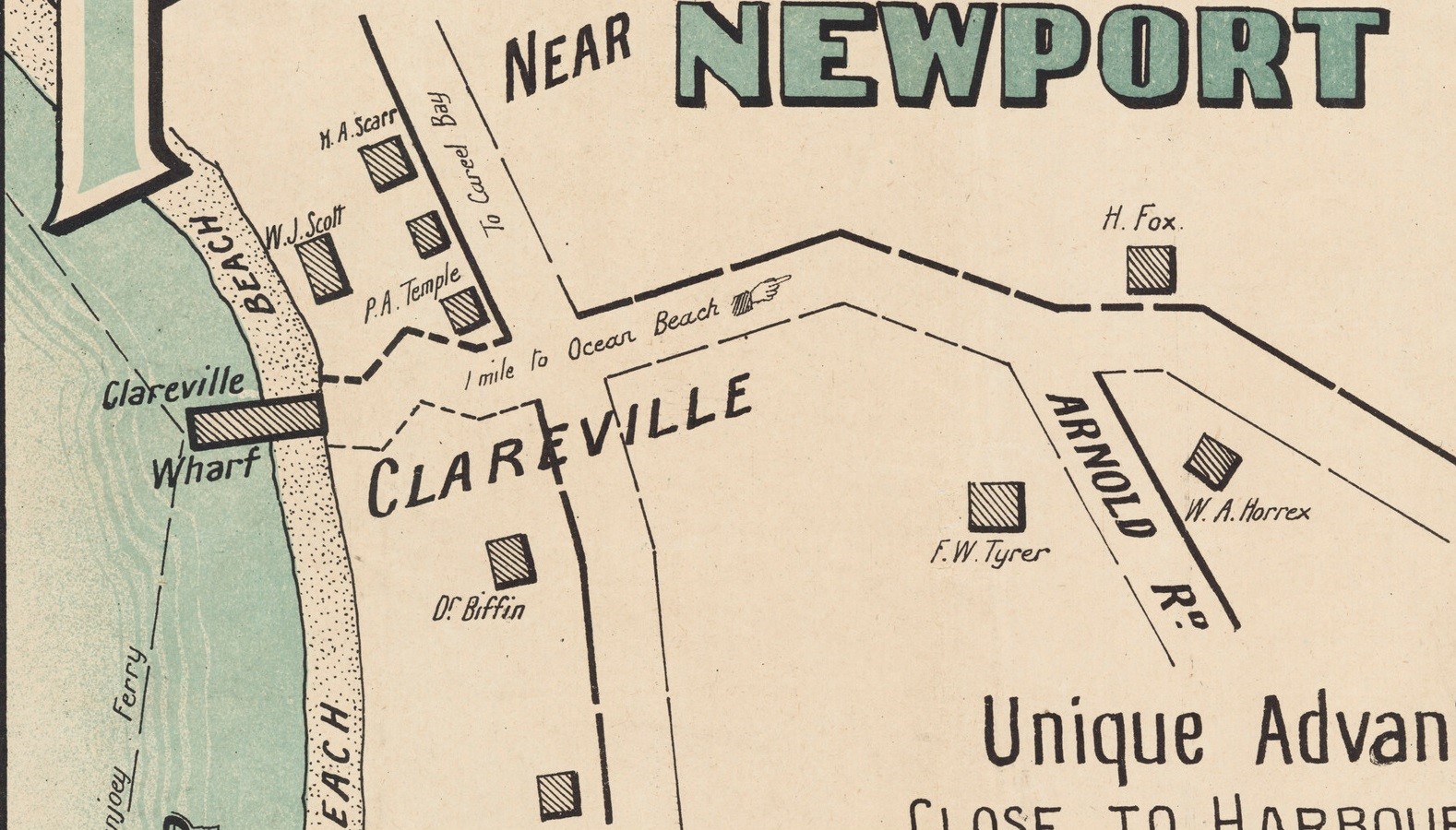
%20for%20Clareville%20page%20showing%20name%20for%20ocean%20beach.jpg?timestamp=1554254107807)
Pittwater Clareville Ocean Beach Estate - Central Rd, Seaview Avenue, Clareville Road, Bellevue Avenue, Barrenjoey road - A J Small. Item No.: c027560009 [Avalon subdivision plans] - courtesy State Library of New South Wales. And sections from to show residences and name for Avalon Beach.
The above is interesting as it shows what we now call 'Avalon Parade' was originally called 'Clareville Road' - as in the road to Clareville and that the name 'Seaview' has been changed too and was changed to 'Elouera', an aboriginal word meaning 'a pleasant place' in 1939. The name swap from 'Seaview' to something more in keeping with the original custodians wasn't the only Seaview to go in 1939 - Elimatta is an Aboriginal word meaning 'my home'.
This is also worth noting:
Mr. Arthur J. Small, of Royston Park, Asquith, takes exception to the statement last week that Palm Beach Estate, Barrenjoey where land brought £4 per foot, ls Inaccessible to the public, and practically can only be reached as a residential area by persons owning their own car. He draws attention to the fact that there is an hourly service of motor cars from the present tram terminus at Narrabeen to Newport, and a regular ferry service thence to Clareville and Palm Beach of two trips each way daily. This service was Inaugurated by the Palm Beach Co. when they first opened up the estate some five or six years ago. REAL ESTATE. NOTES OF THE WEEK. (1917, March 31). The Sydney Morning Herald (NSW : 1842 - 1954), p. 11. Retrieved from http://nla.gov.au/nla.news-article28101228
The Canty lands - courtesy of the NSW Historical Land Records Viewer (HRLV):
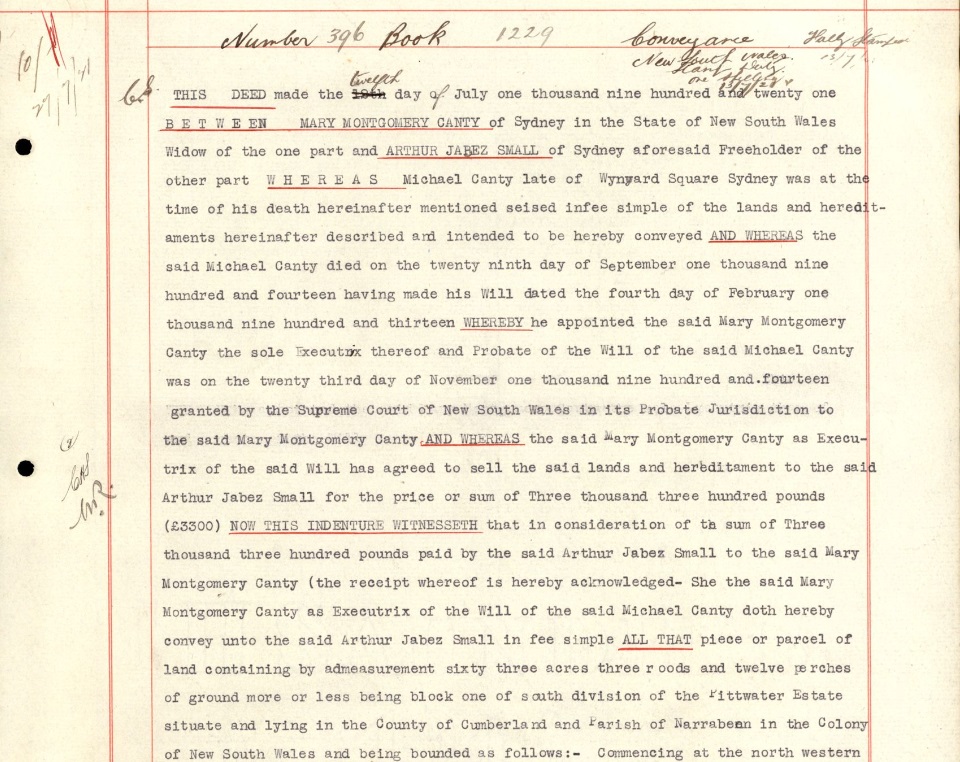
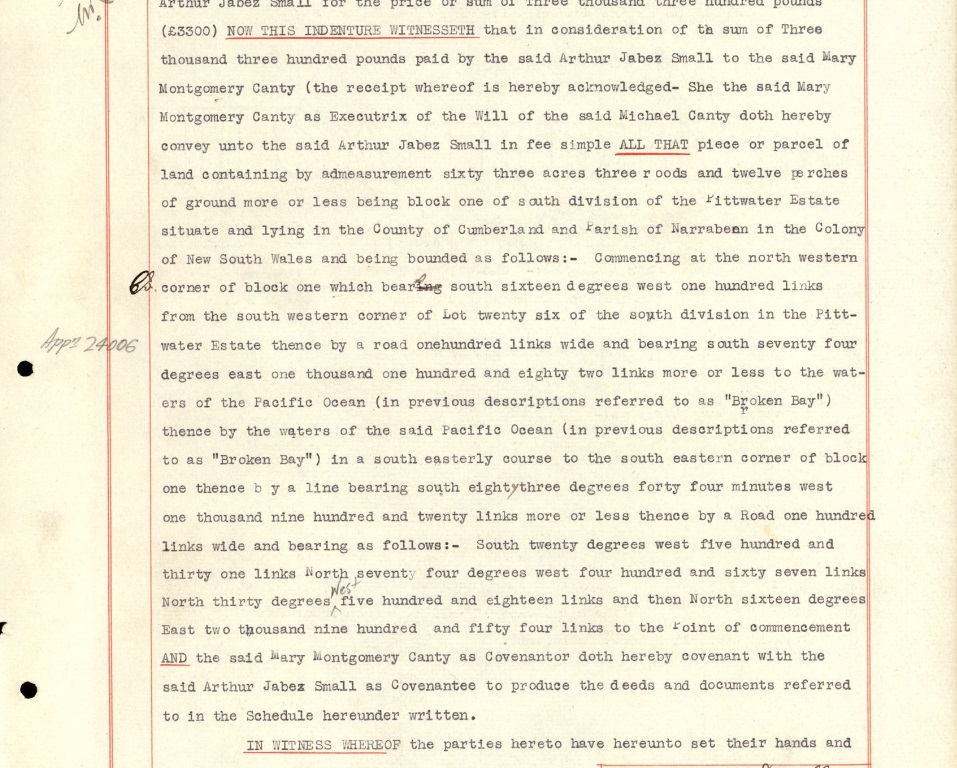
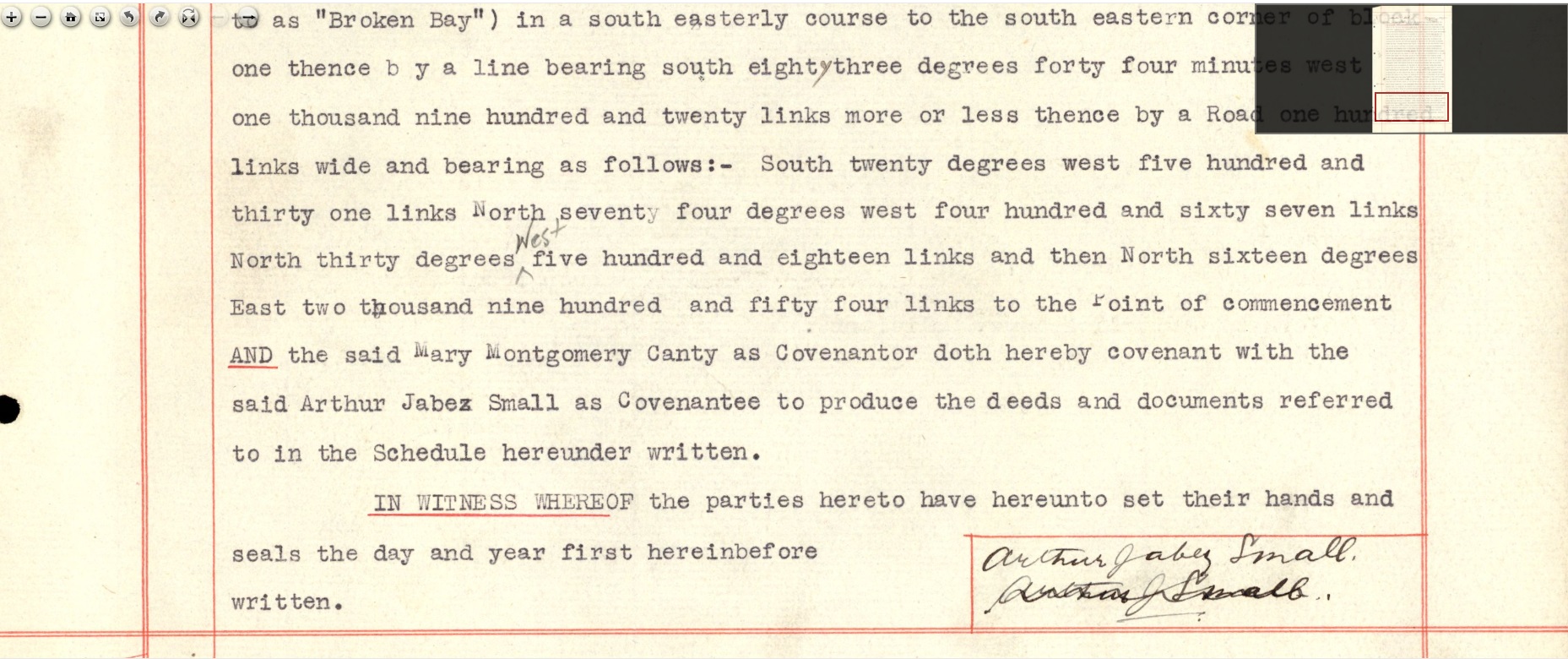
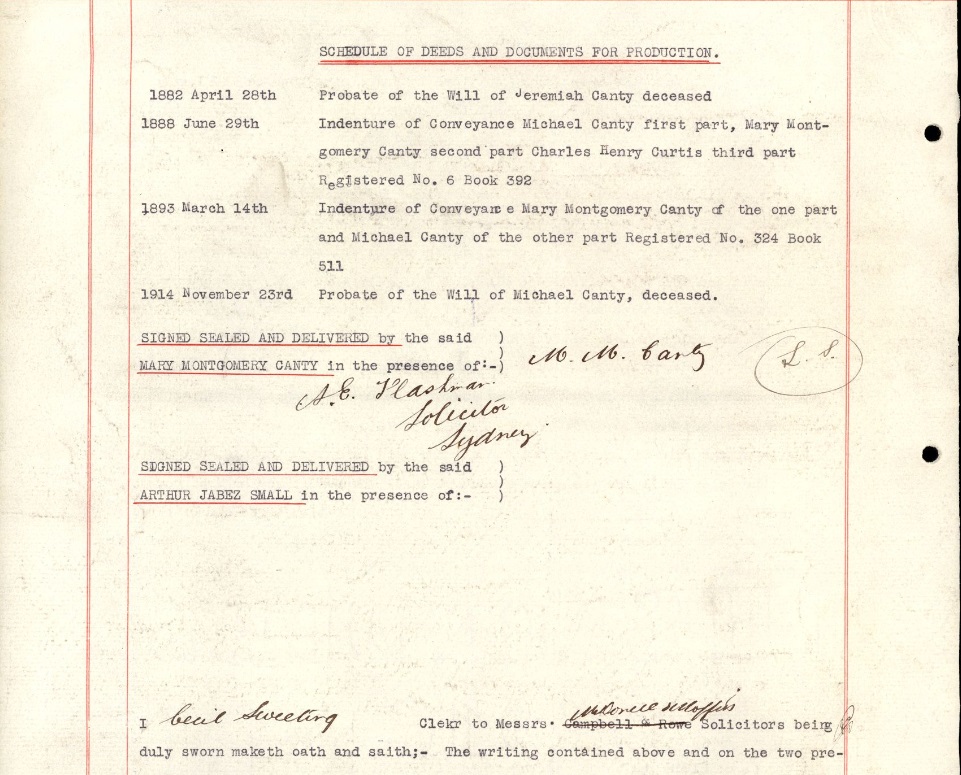
In December 1921 the first subdivisions of land at 'Avalon Beach' were offered for sale. These were presented as a 'weekend spot' rather than to be a suburban choice initially.
Geoff Searl OAM again provides:
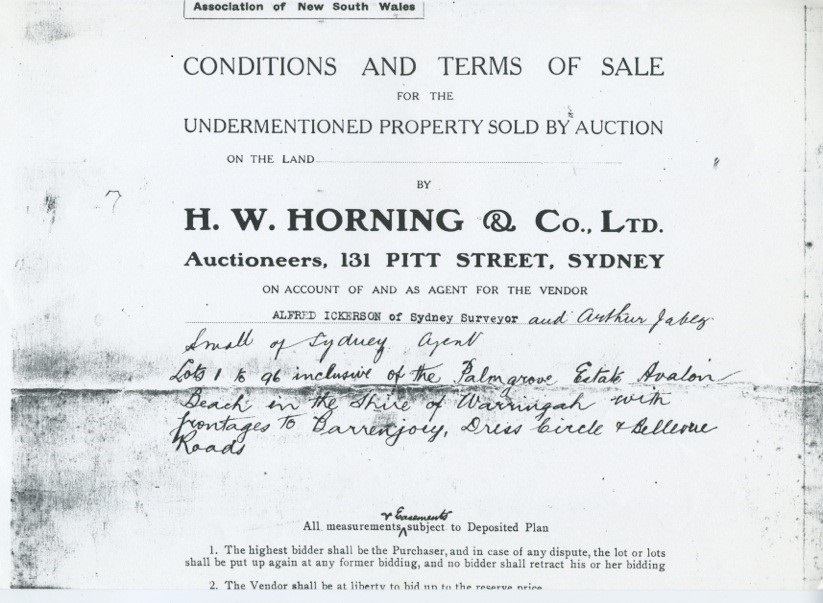
Cronulla was, Palm Beach is, and Avalon Beach will be. This is the catch slogan which has been adopted by the vendor of the Palmgrove Estate at Avalon, which is to be sold by Messrs. H. W. Horning and Co., on Boxing Day. Judging by the beautiful panoramic views which appear in an attractive booklet, and which also occupy a conspicuous position in Messrs. Horning and Co.'s windows, Martin-place, the scenery surrounding the estate must be exceptionally beautiful. Avalon is the new seaside resort between Newport and Palm Beach. The Palmgrove Estate is on the main Barrenjoey-road, and is right at the beach.
The owner has evidently had the public good in mind, as the estate has been well planted with Ornamental shade trees, while a section of it known as the Palm Grove, has been presented as a park. This is a remarkable beauty spot, with a wealth of graceful palms, maidenhair, burrawang, and other ferns. The estate is in every respect a most attractive proposition to those looking for week-end and holiday sites. REAL ESTATE NEWS (1921, December 11). Sunday Times (Sydney, NSW : 1895 - 1930), p. 10. Retrieved from http://nla.gov.au/nla.news-article123241058
Last week we published a photograph of the remarkable .bit of scenery on the Palmgrpve estate' at Avalon Beach, suggesting more a scene on one of the South Sea Islands than part of one of Sydney's outer suburbs. This particular section of the Palmgrove estate has been ' donated by the vendors as a public park, and will be a particular attraction to that locality. To-morrow the estate is to be offered for public auction, and a most interesting sale is expected. Those who know Avalon Beach will agree- that it is a particularly charming seaside resort. Special arrangements have been made for the convenience of the many who are expected to attend the sale tomorrow, and to thus combine business with pleasure. Cars and motor buses will meet trams at the Narrabeen tram terminus, while a limited . number of passengers will be taken from Manly, returning to Narrabeen after, the sale. Messrs. H. W. Horning and Co., have prepared this subdivision in a manner, which does credit to their high reputation in this direction.
On New Year's Day Messrs. H. W. Horning and Co., Ltd., have two more attractive watering places to offer. One of these . is the Sunrip estate, consisting of 25 allotments at Woy Woy. .The land is close to the .Rip, and may be reached either by the regular line of motors or the ferry service. On the: same day this firm will offer the Great Mackerel Beach estate at Pittwater. This subdivision includes a bungalow residence standing in a large area of ground, and also some attractive lots .facing: Ross Smith-parade right at the wharf, and also fronting Diggers-crescent and Monash-avenue. For boating, swimming and fishing, this is one of the mostifavored resorts around Sydney. CLOSING SALES OF THE YEAR IN REAL ESTATE (1921, December 25). Sunday Times (Sydney, NSW : 1895 - 1930), p. 10. Retrieved from http://nla.gov.au/nla.news-article123234425
That booklet - and enlarged sections from to show the details - also includes why 'Avalon' became the name, for sales purposes and because Mr. Small was obviously finding this place as such:

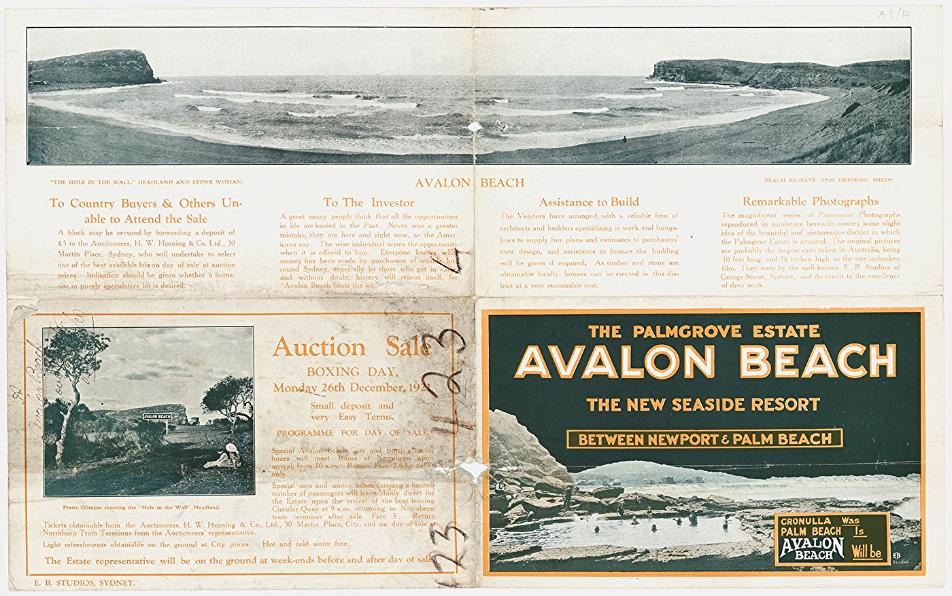
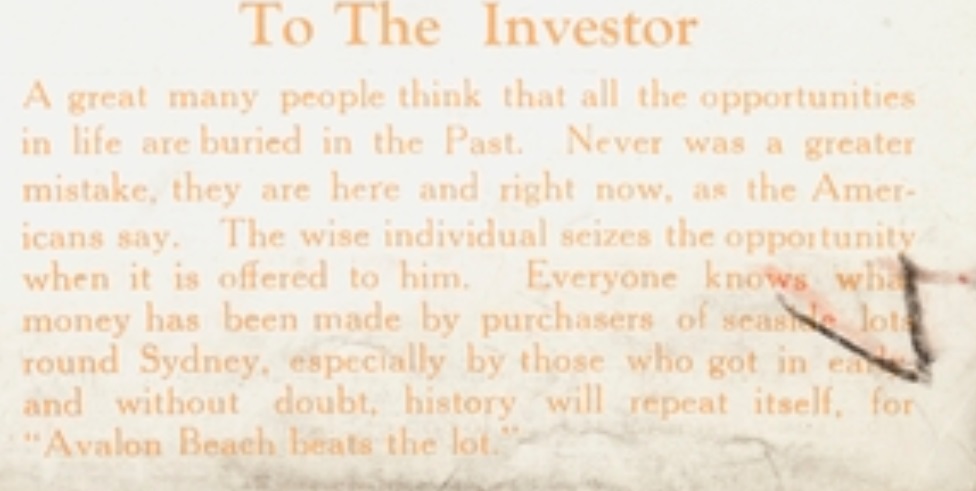
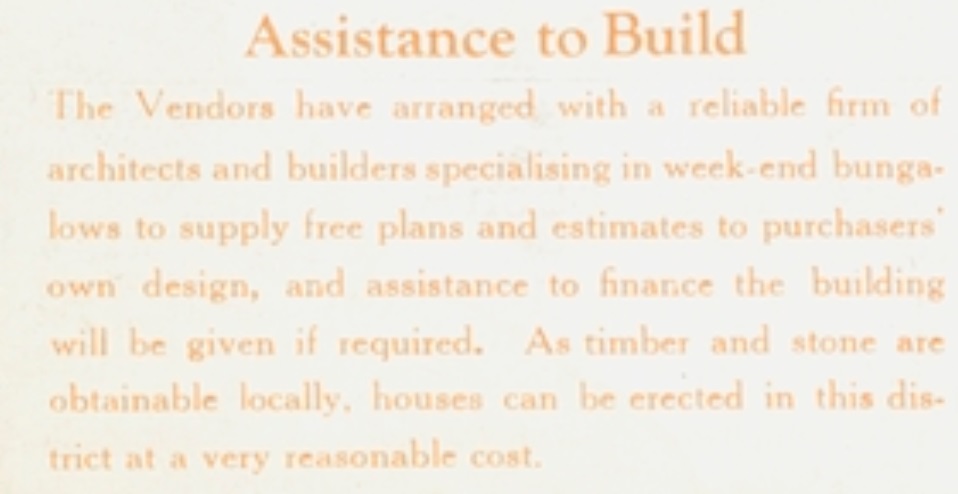
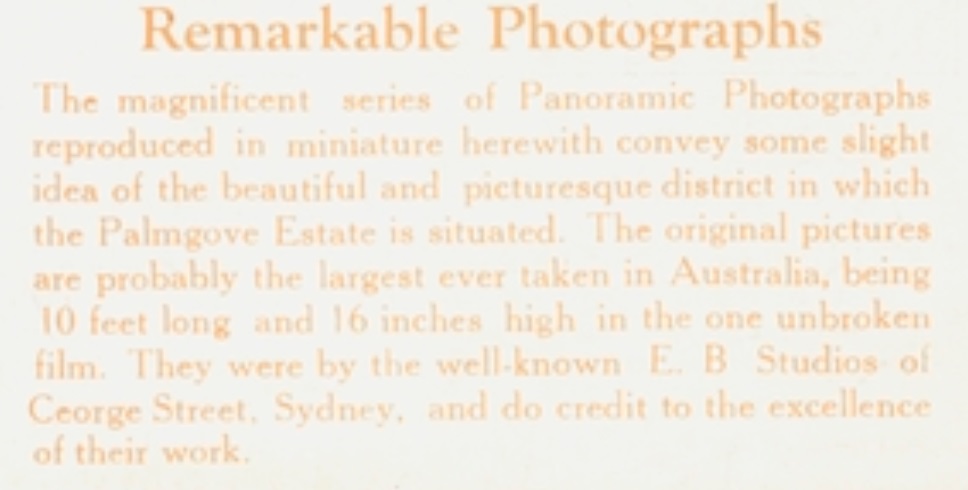
1921 Brochure - Palmgrove Estate, Avalon Beach, new seaside resort between Newport & Palm Beach Newport Beach, Palm BeachImage No.: c027560016 and Avalon Beach first subdivision. Image No.: c027560017 and Palmgrove Estate, Avalon Beach. No boundaries shown. Image No.: c027560018 - from Avalon Subdivision Maps, courtesy State Library of NSW
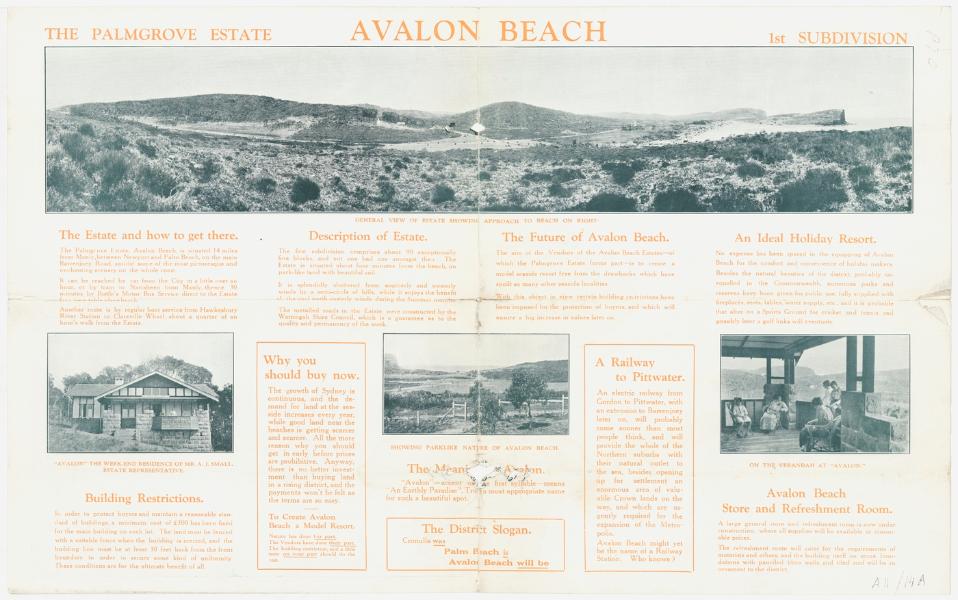
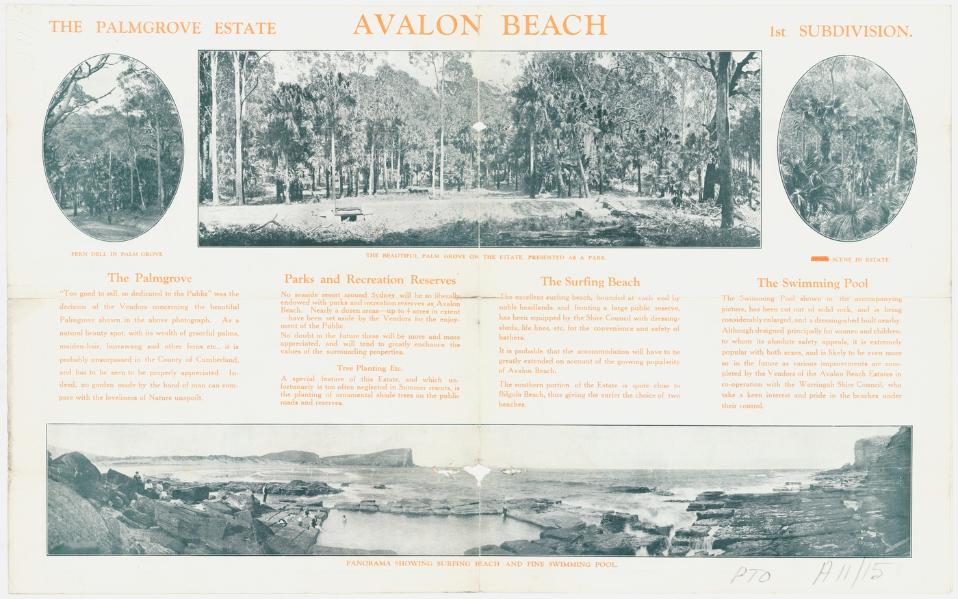
.jpg?timestamp=1557955604412)
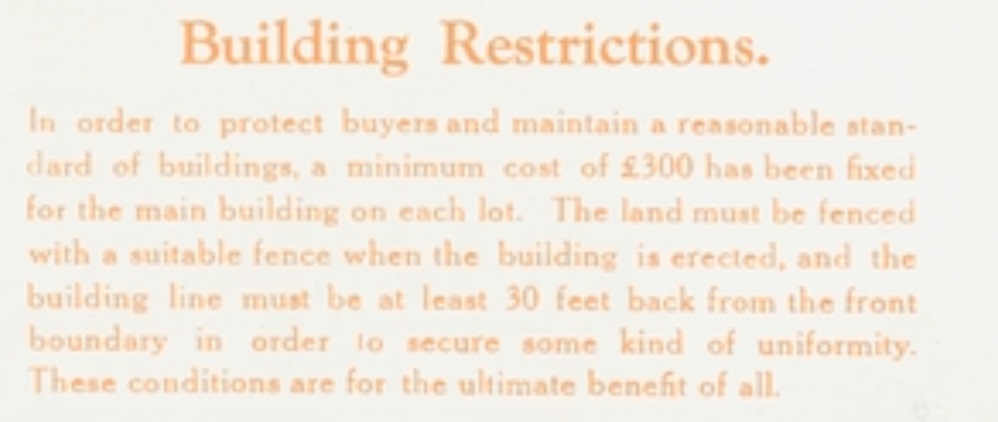
.jpg?timestamp=1557955637497)
.jpg?timestamp=1557955677491)
.jpg?timestamp=1557955709490)
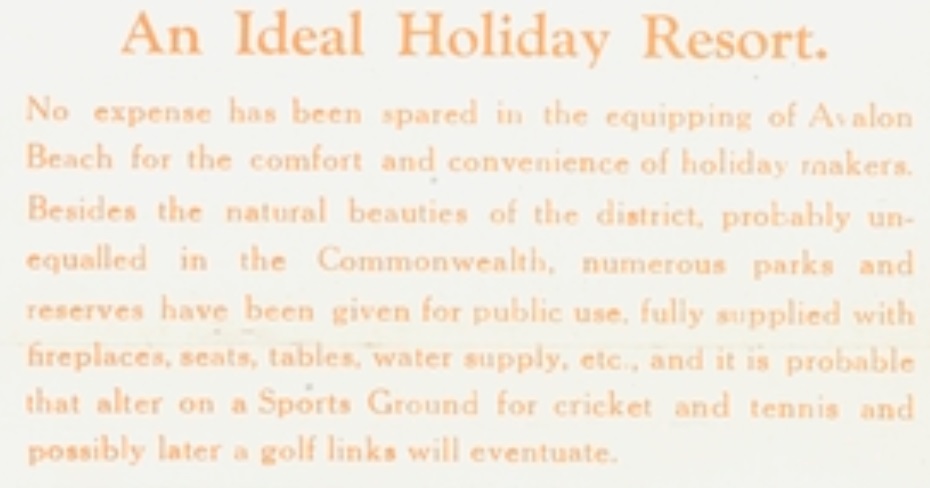


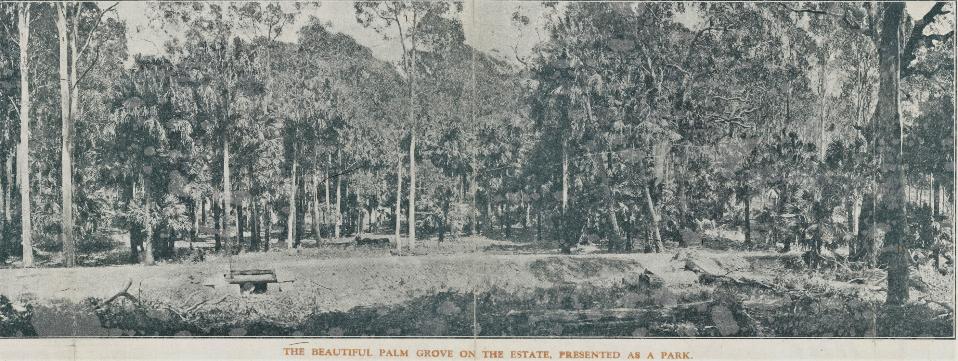
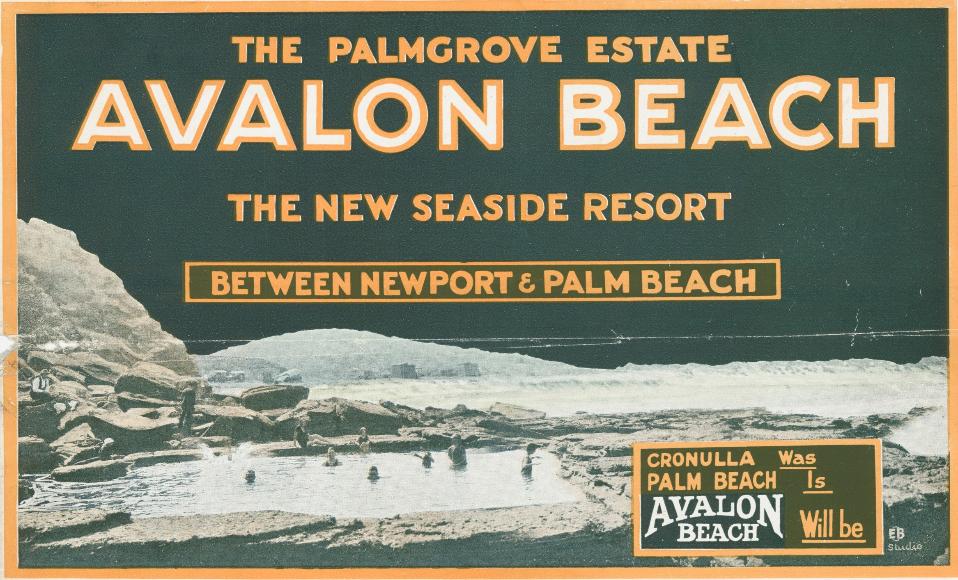
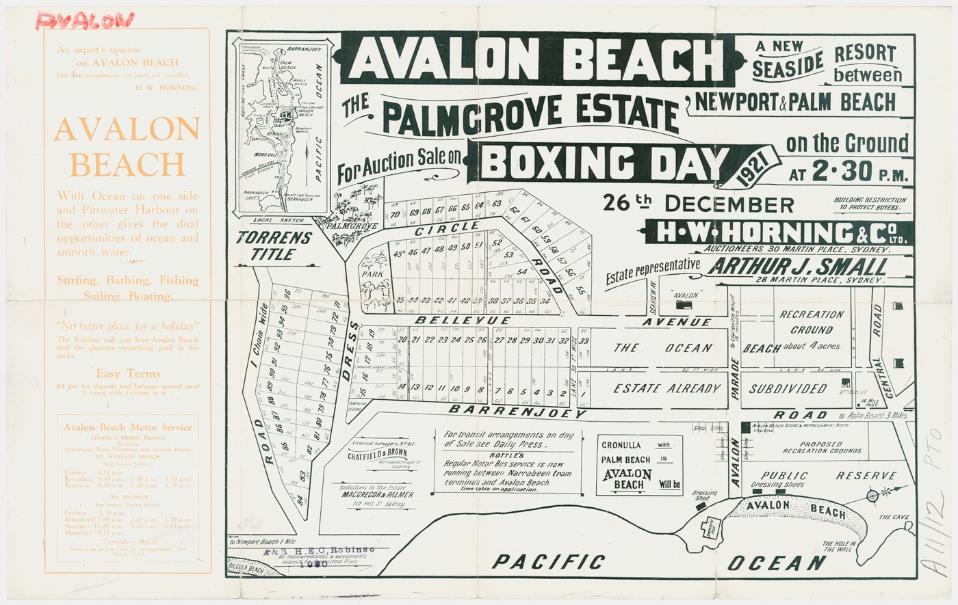
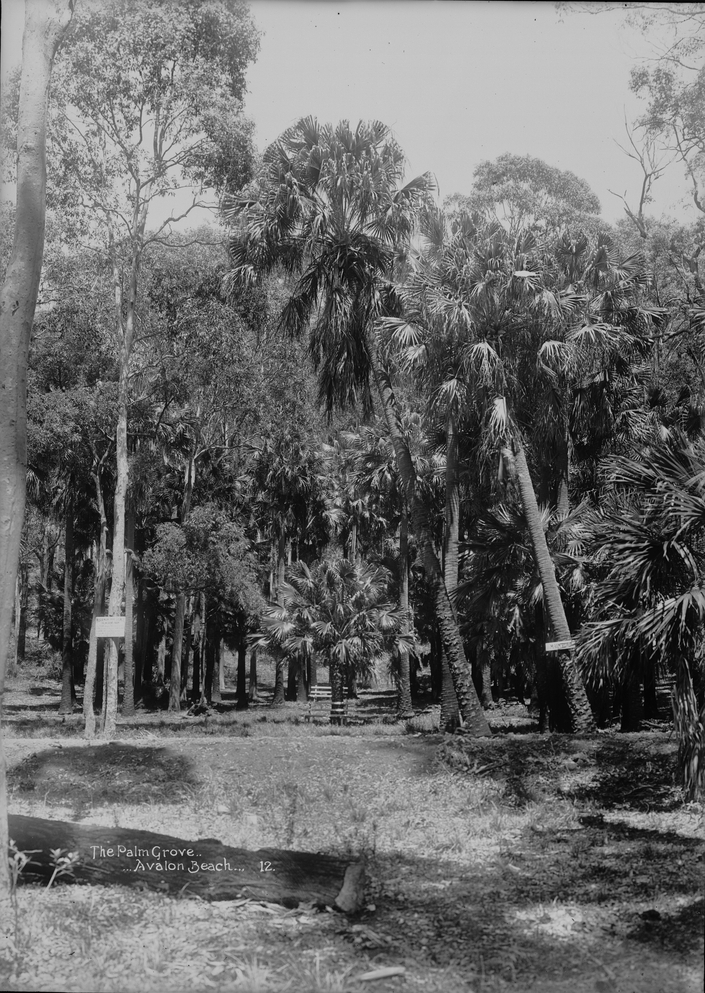
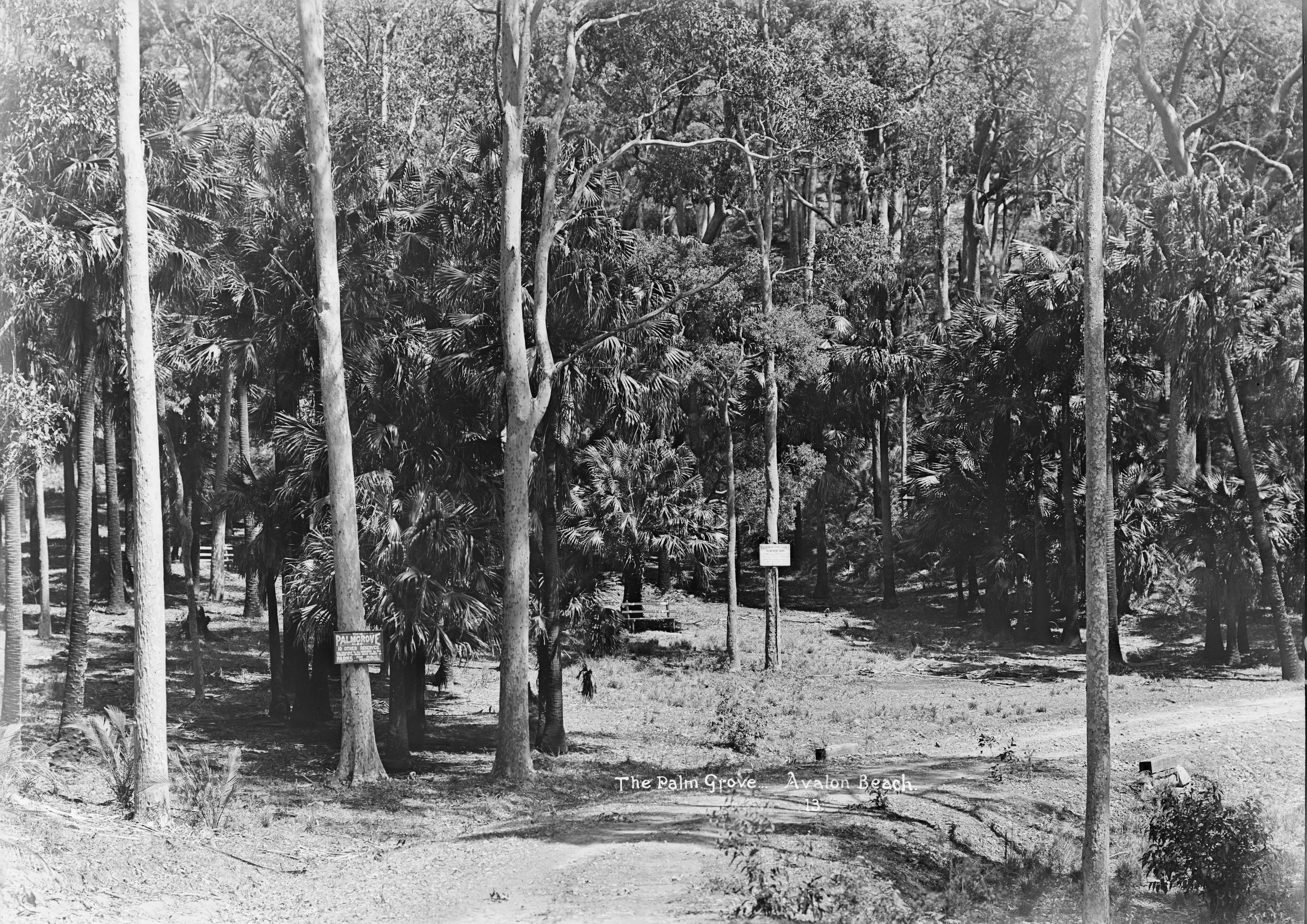
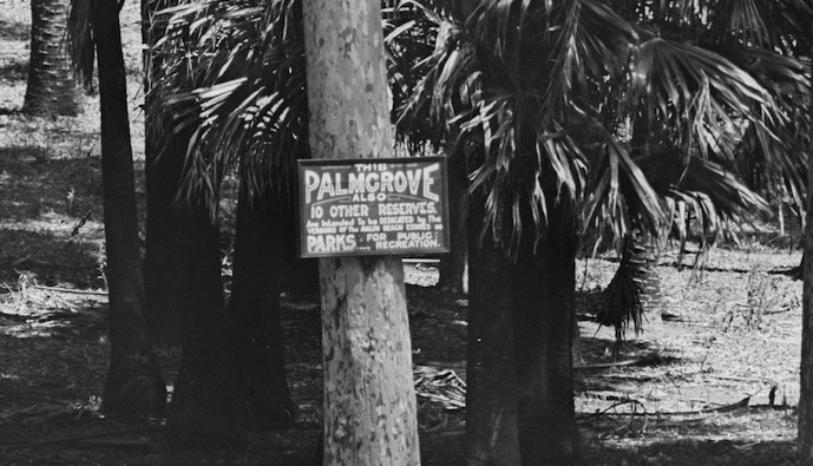
PARKS AND PLAYGROUNDS.
Aims of Movement.
"That every child shall have a chance to play and every citizen the opportunity for recreation" was adopted as a chief aim in the constitution of the New South Wales Parks and Playgrounds Movement, which held its first annual meeting at the New South Wales Cricket Association's Chambers on Wednesday. "The normal expansion of Sydneys playing fields should be, at a minimum, from 100to 120 acres of level land every year," says the report of the movement. A report on the whole matter by the Surveyor-General, who was being assisted by a committee of the movement, was expected shortly. "In the meantime, the executive of the movement has taken up (as an Immediate measure) the question of pressing for 'Five More Moore Parks."
The meeting, which was a full one, delegates from 30 bodies being present, was concerned largely with the elimination by the Legislative Council of the parks clauses of the Greater Sydney Bill. 'This meant', said Dr. C. E. W. Bean, honorary secretary of the movement, 'that, although the Greater Sydney authority, if established, could plan parks and playgrounds, It would not be able to acquire them, or even to accept them if given to it-powers which were possessed by greater-city authorities all over the world. '
On the motion of the chairman, Mr. A. J.Small, seconded by Mr. D. G. Stead, the meeting expressed its unanimous disapproval of the elimination of these powers from the bill. The liability of all State school playgrounds to taxation while many private school grounds were exempt was also strongly criticised in the report, a case being cited in which public land lying Idle was heavily rated as soon as it was permitted to be used as a play-ground for State schoolchildren. On the motion of the chairman, seconded by Mr. R.A. Bennett, it was resolved to urge that, in the bill projected by the Government, exemption should be extended to all school play-grounds. A committee was appointed "to co-operate with the city authorities in their task of re-organising the playground system of Sydney," And It was also resolved, on the motion of Mr. Burrows and Mrs. Wyatt, to urge the preservation by some means of the Pymble State forest. Mr. A. J. Small (president of the Town Planning Association) was elected as first president of the Parks and Playgrounds Movement. PARKS AND PLAYGROUNDS. (1931, September 25). The Sydney Morning Herald (NSW : 1842 - 1954), p. 10. Retrieved from http://nla.gov.au/nla.news-article16818070
Report on the Palmgrove sales:
Messrs. H. W. Horning and Co. who made a special feature of the Palmgrove Estate, Avalon Beach, realised £3280 on the ground. HOLIDAY SUBDIVISIONS (1921, December 31). The Daily Telegraph (Sydney, NSW : 1883 - 1930), p. 15. Retrieved from http://nla.gov.au/nla.news-article239709939
A few months later:
IMPROVING AVALON. ROADSIDE TREES PLANTED
Since the sale of Avalon Beach Estate at Christmas additions and improvements have been effected on the estate.
The rock pool baths at the southern end of the beach have been extended 18ft., and are now 57ft. long, with a smooth bottom. Ladies' dressing sheds have been erected immediately at the rear, on a spot once occupied by a jumble of rocks, and a general store and refreshment room of original design has been built close to the beach.
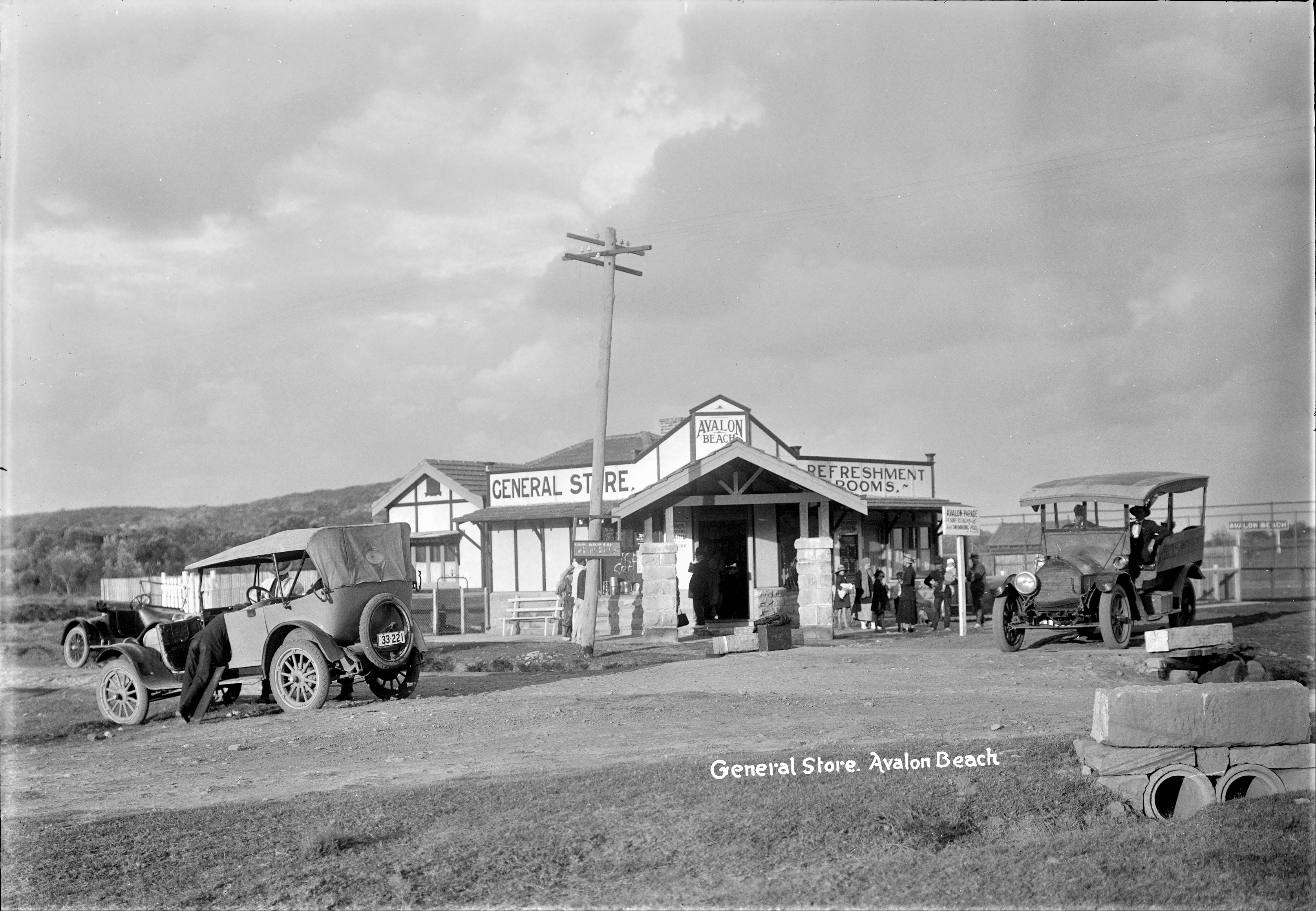
General Store, Avalon Beach - ON 165/925 Item c07771_0002_c - photo by Rex Hazlewood, Image Courtesy The Mitchell Library, State Library of NSW, circa January - February 1922
Several landowners are already building homes on their lots. A new, wide road has been constructed, giving the land direct access to the beach, and at the side of all the roads, trees, of eight different varieties, chosen as specially suitable for the land and atmosphere, have been planted. One of these is the Illawarra Flame Tree, which carries blooms of fire color. IMPROVING AVALON (1922, March 22). The Sun (Sydney, NSW : 1910 - 1954), p. 10 (FINAL RACING). Retrieved from http://nla.gov.au/nla.news-article225222882

%20Albert%20Henry%20Grace%20top.jpg?timestamp=1637206963583)
%20Albert%20Henry%20Grace%20Base%2011%20acres.jpg?timestamp=1637206992870)
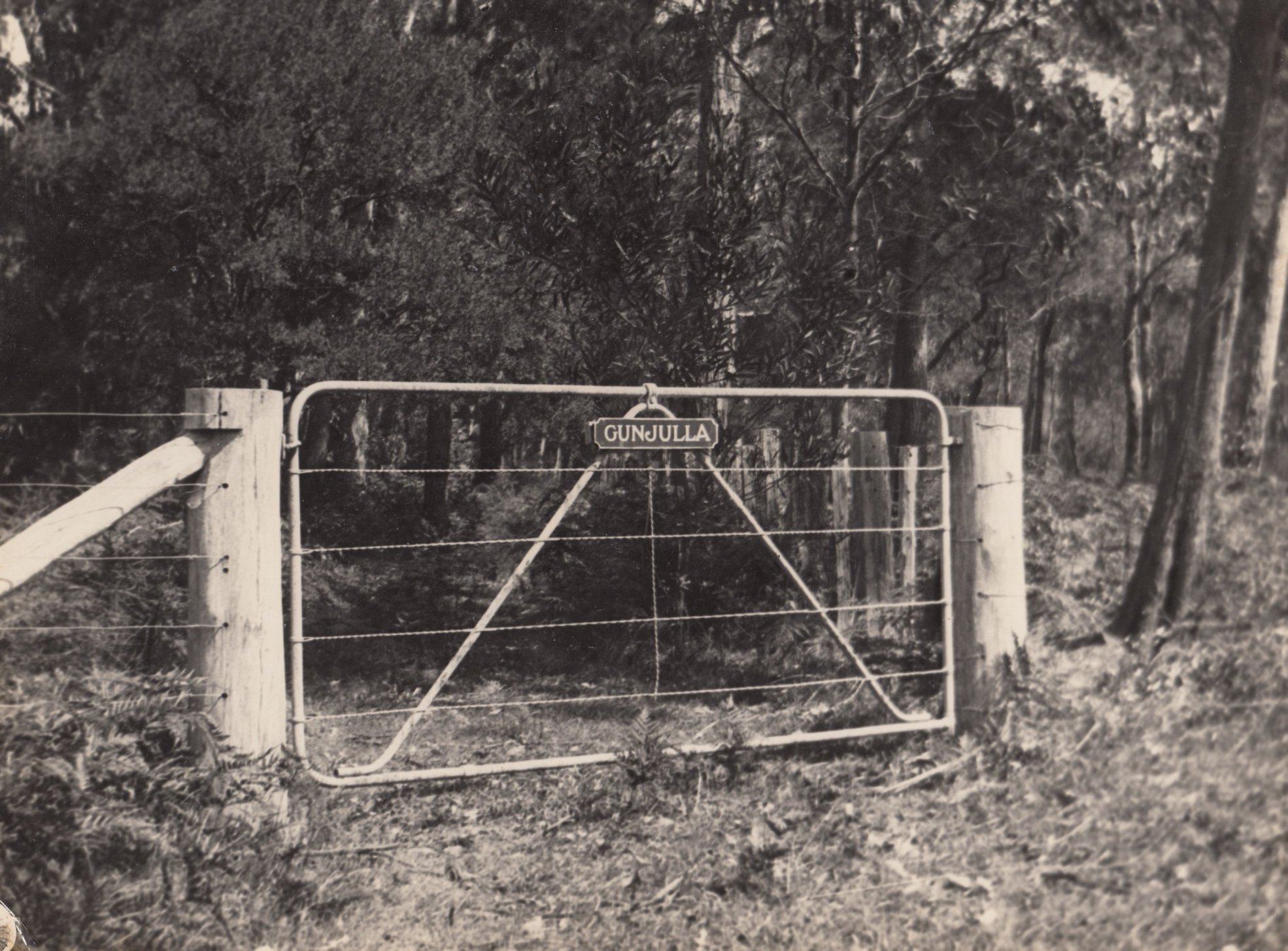
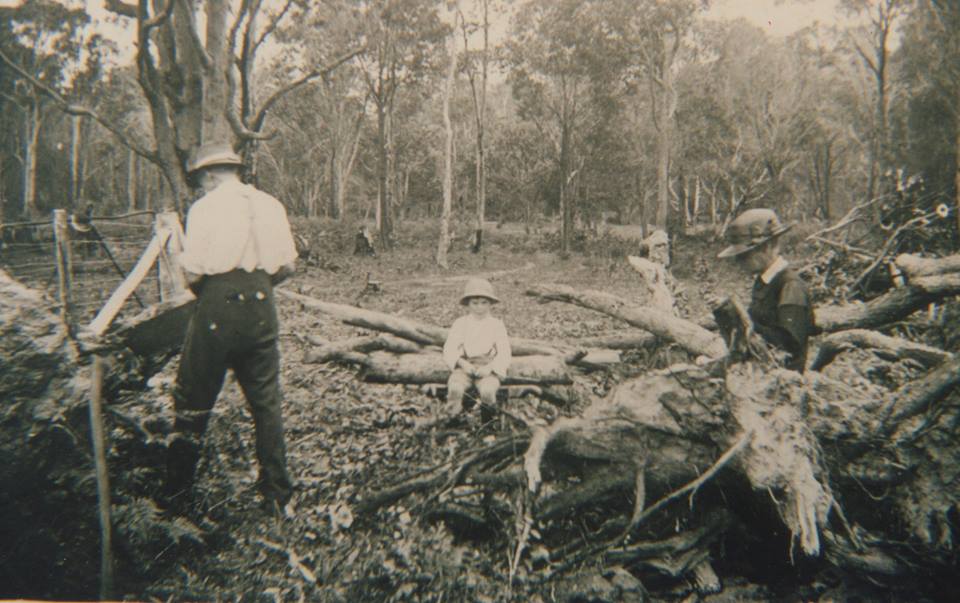
My great grandparents clearing the land at Gunjulla Pittwater. Now called Gunjulla Road. 1919 Their grandson Geoffrey aged 4 is keen to lend a hand. - photo and information courtesy Helen Grant
Below - view towards Gunjulla 1919/1920:
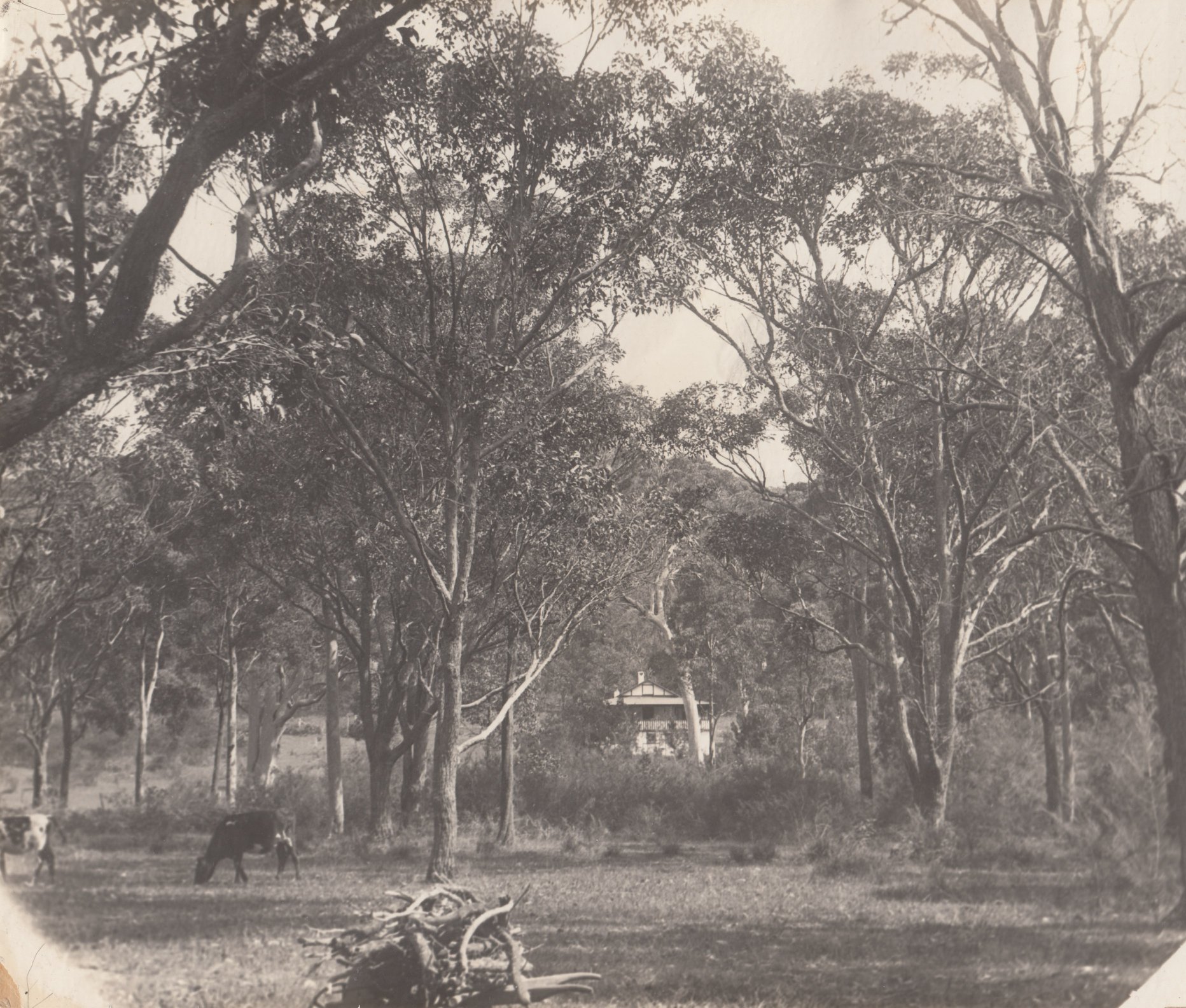
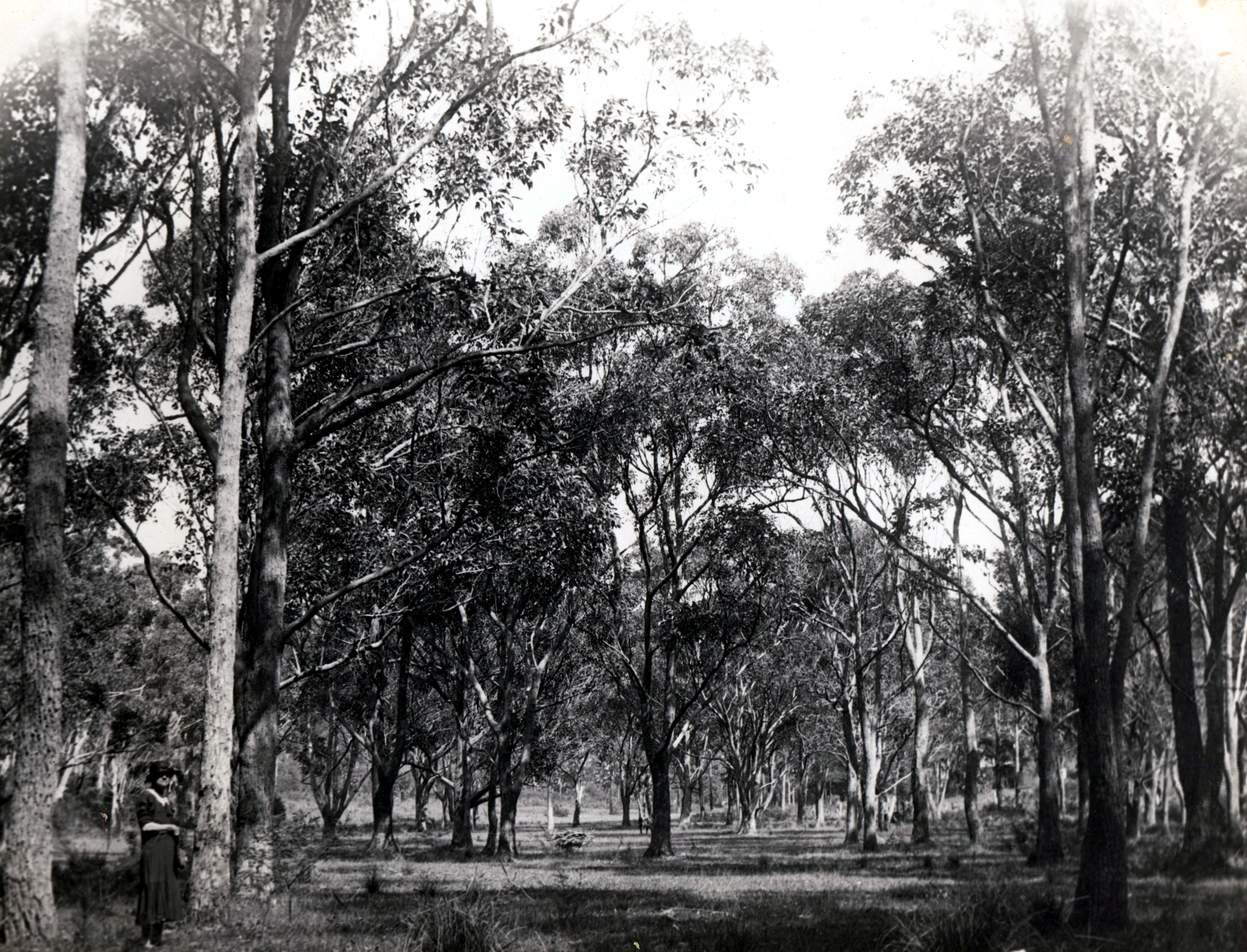
Gunjulla view, circa 1919, Catherine at left of photo
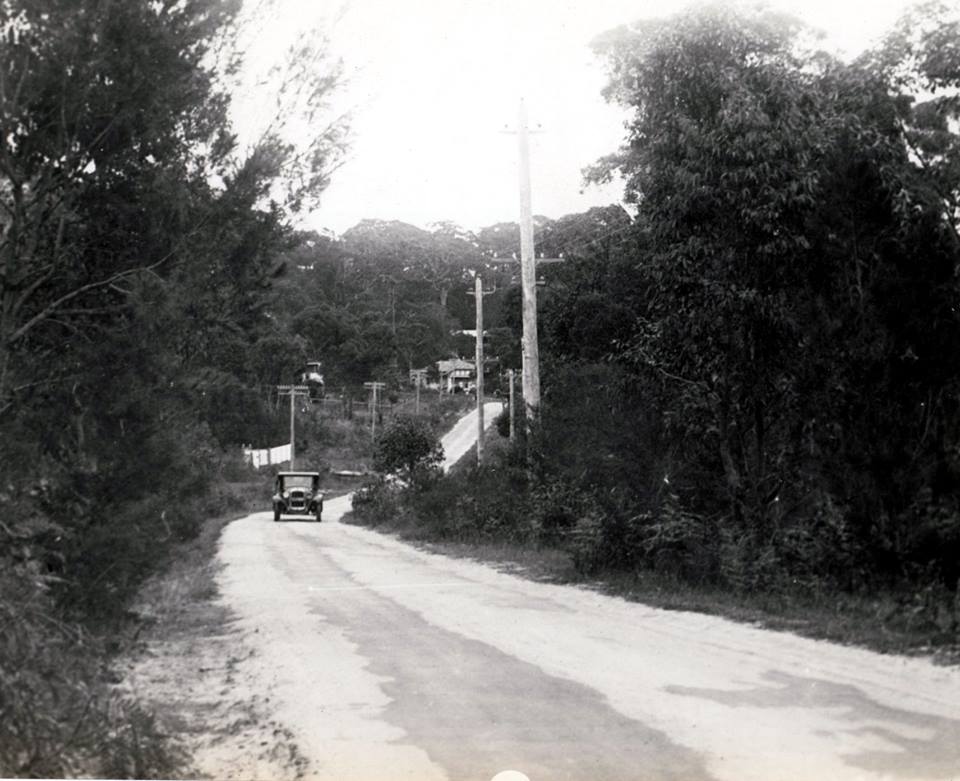
'Clareville Road', Pittwater between 1922/1925 and 1930'. My great grandfather's photo Albert Henry Grace. Image courtesy Helen Grant.
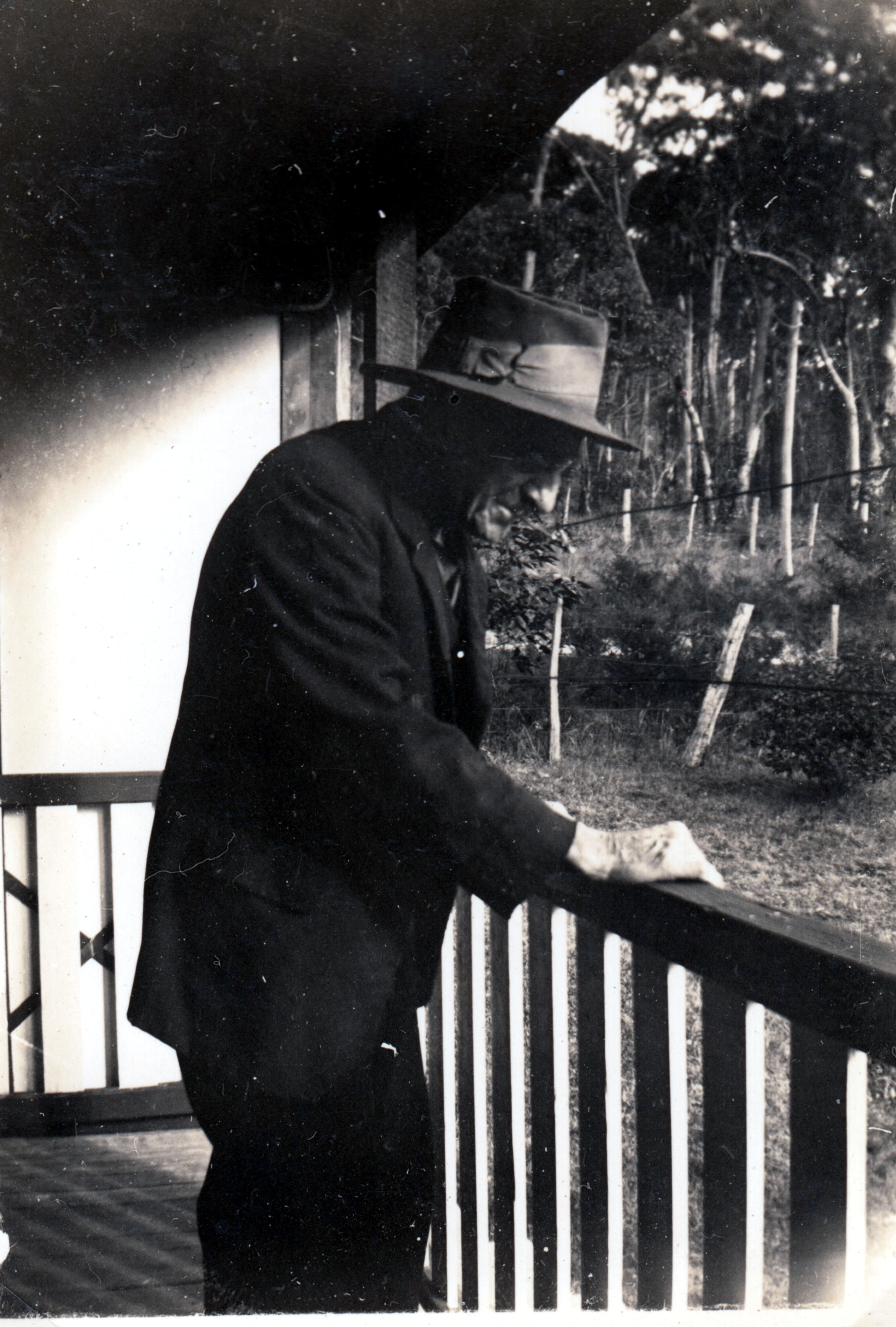
Albert Henry Grace at Gunjulla in 1920
Pittwater Online News recently spoke to Helen Grant, whose mum Deborah, was the youngest child of Henry Albert and Deborah Grace.
''From what I know, my grandparents purchase of the land of Gunjulla occurred in or around 1919 – they were clearing the block in 1919. The family were well off and had land in Wollongong and Willoughby (as well as at Surry Hills).
Albert Henry Grace and his wife Catherine cleared the land. His son, Henry Albert Grace and his young family loved going there; Millicent, Gwendolyn, Geoffrey, Myra, and Deborah (my mother).
Mum, Deborah, was the last kid to be born in 1926 to Henry Albert Grace and Deborah Watling Grace. The other children were much old or in their teens. My mum's memory of the place is very good, however, the time spent there was just following the older sibling around or keeping away from their antics.
Your first question was how much land was attached to the property. Mum can’t tell you that as she never knew. The primary use of the property was a place to get away from the city and be with their grandparents.
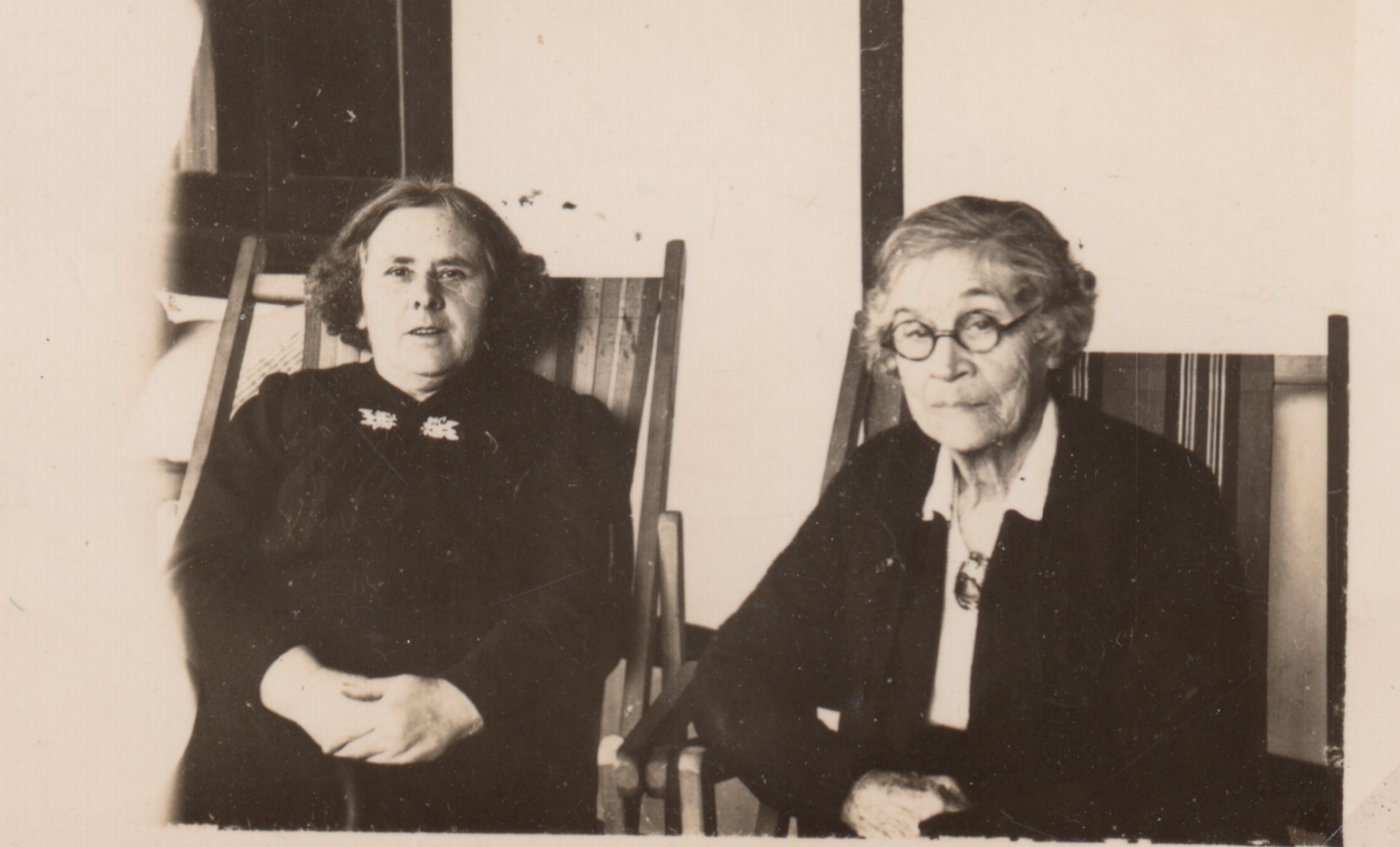
Deborah Grace Snr. and Catherine Grace 1940
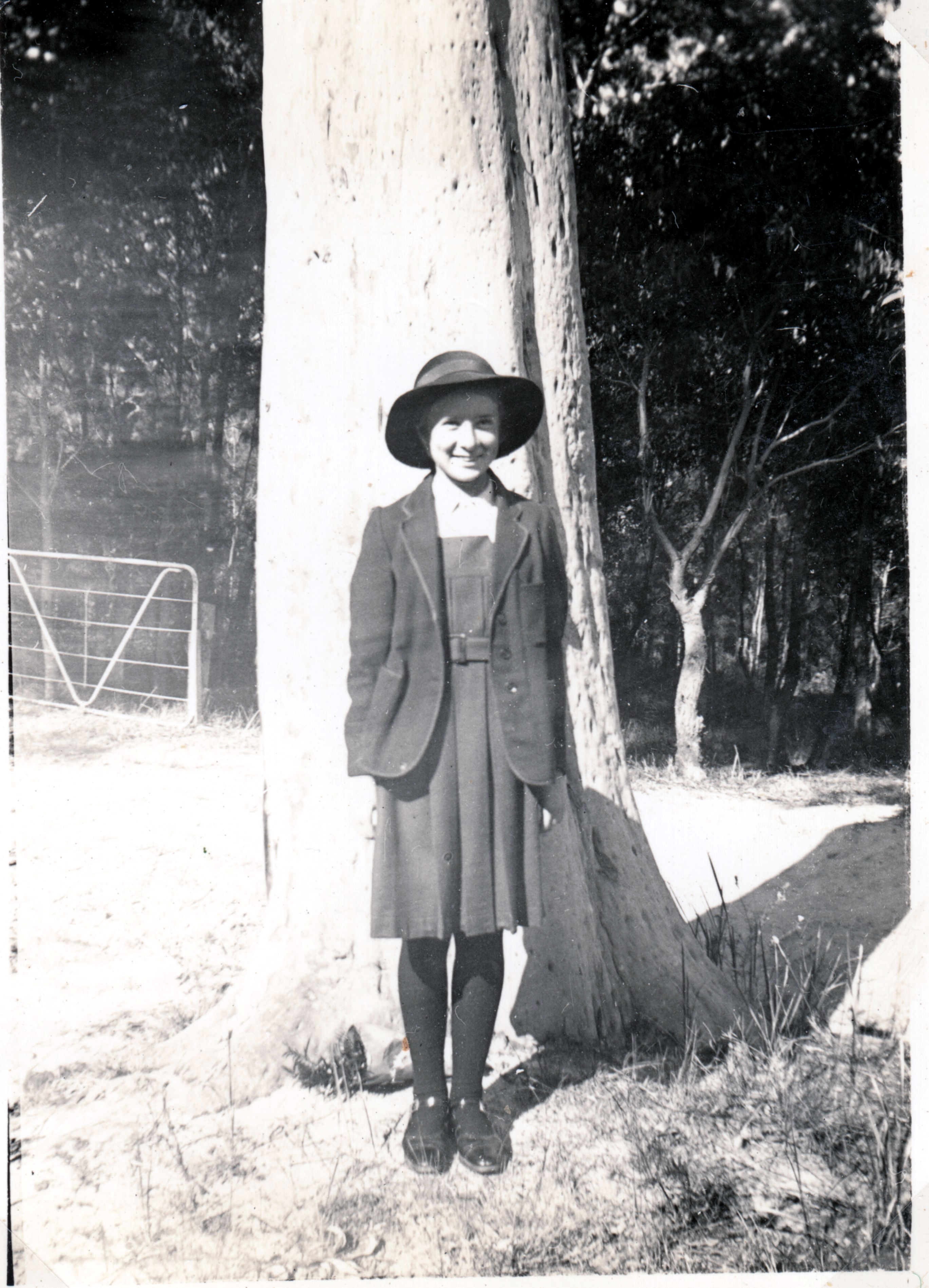
Gunjulla: Deborah Grace Jnr. by The Tree 1940
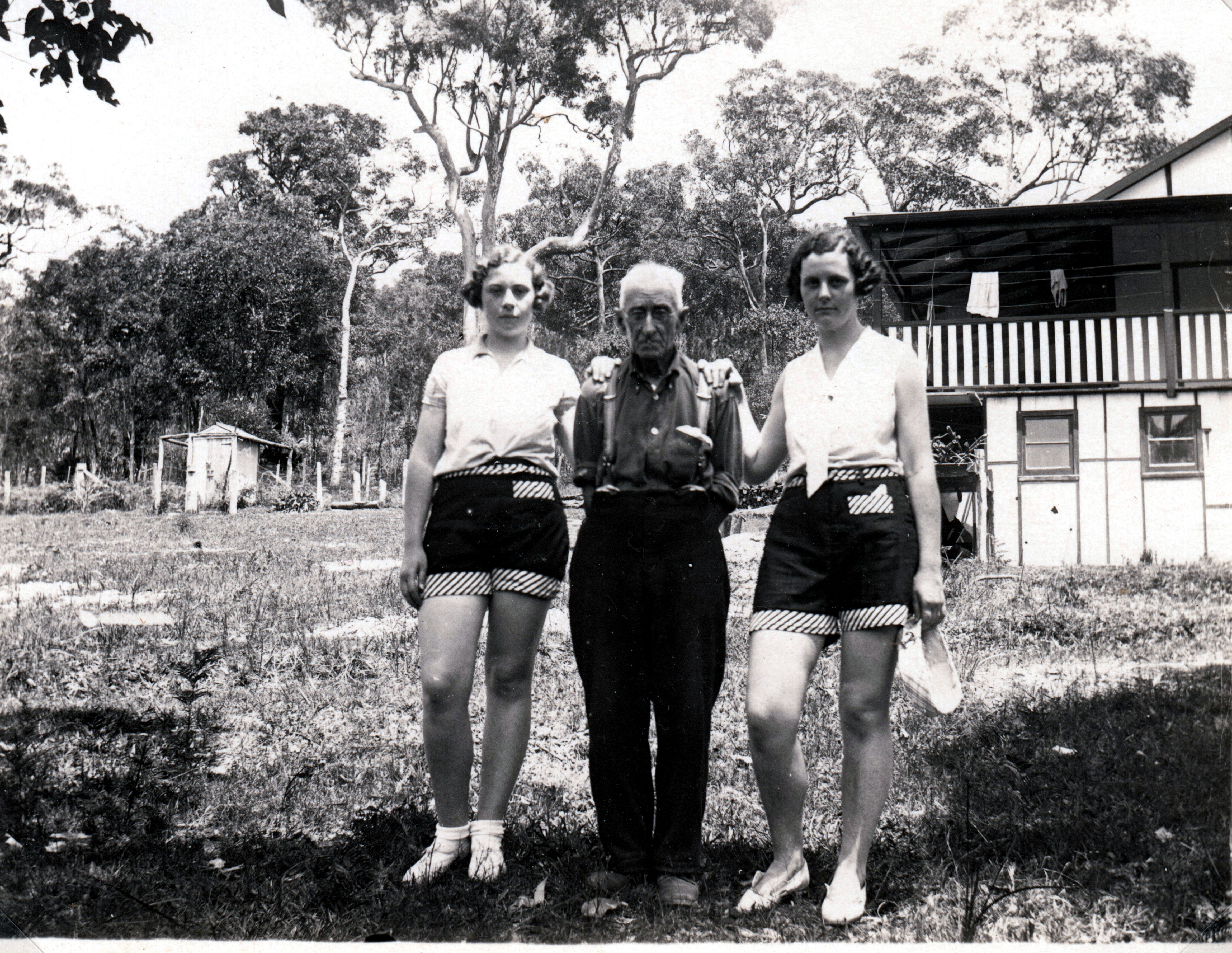
Gunjulla: Albert Grace with Gwendolyn and Millicent, 1940
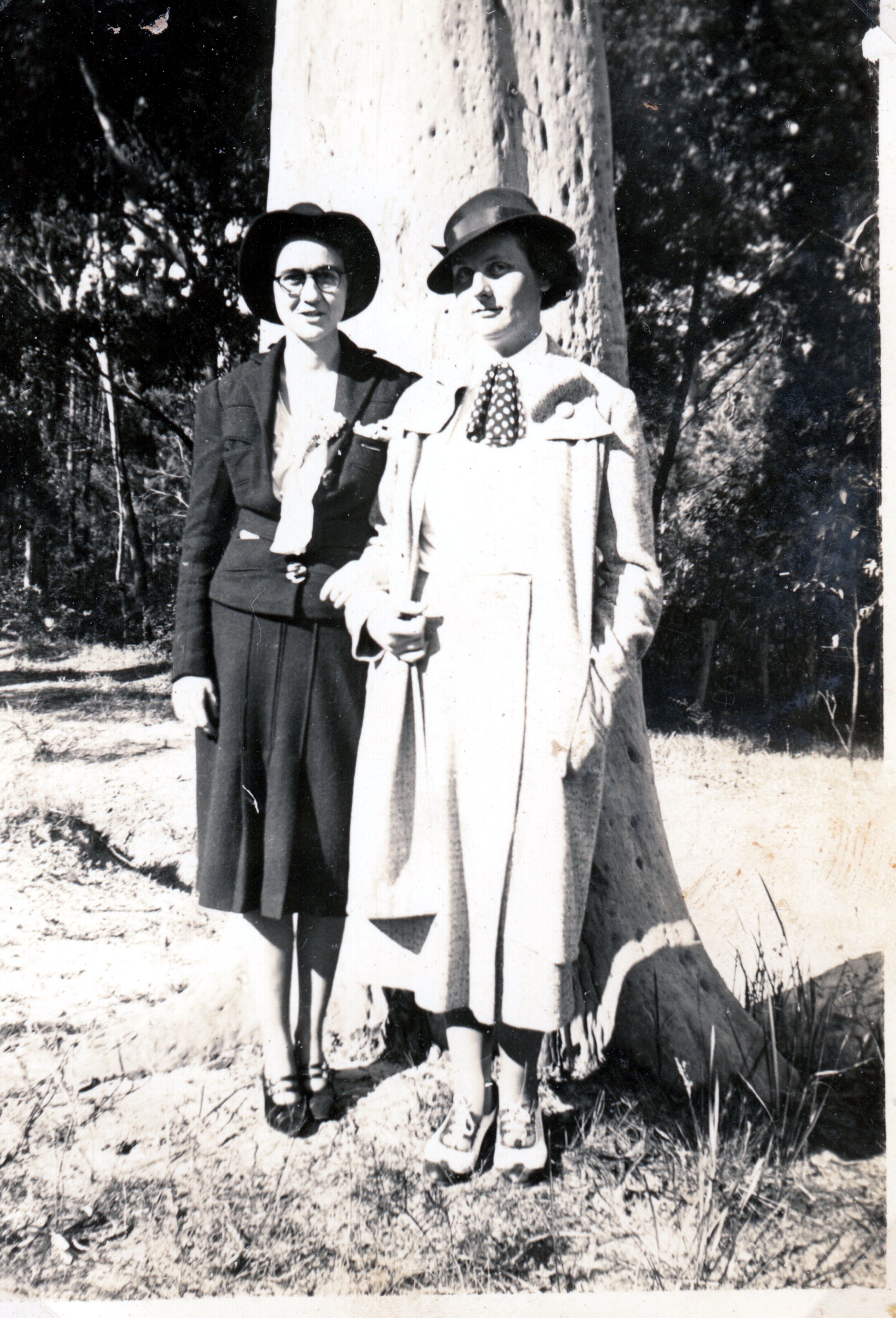
Gunjulla: Joyce and Millicent Grace by The Tree, 1940
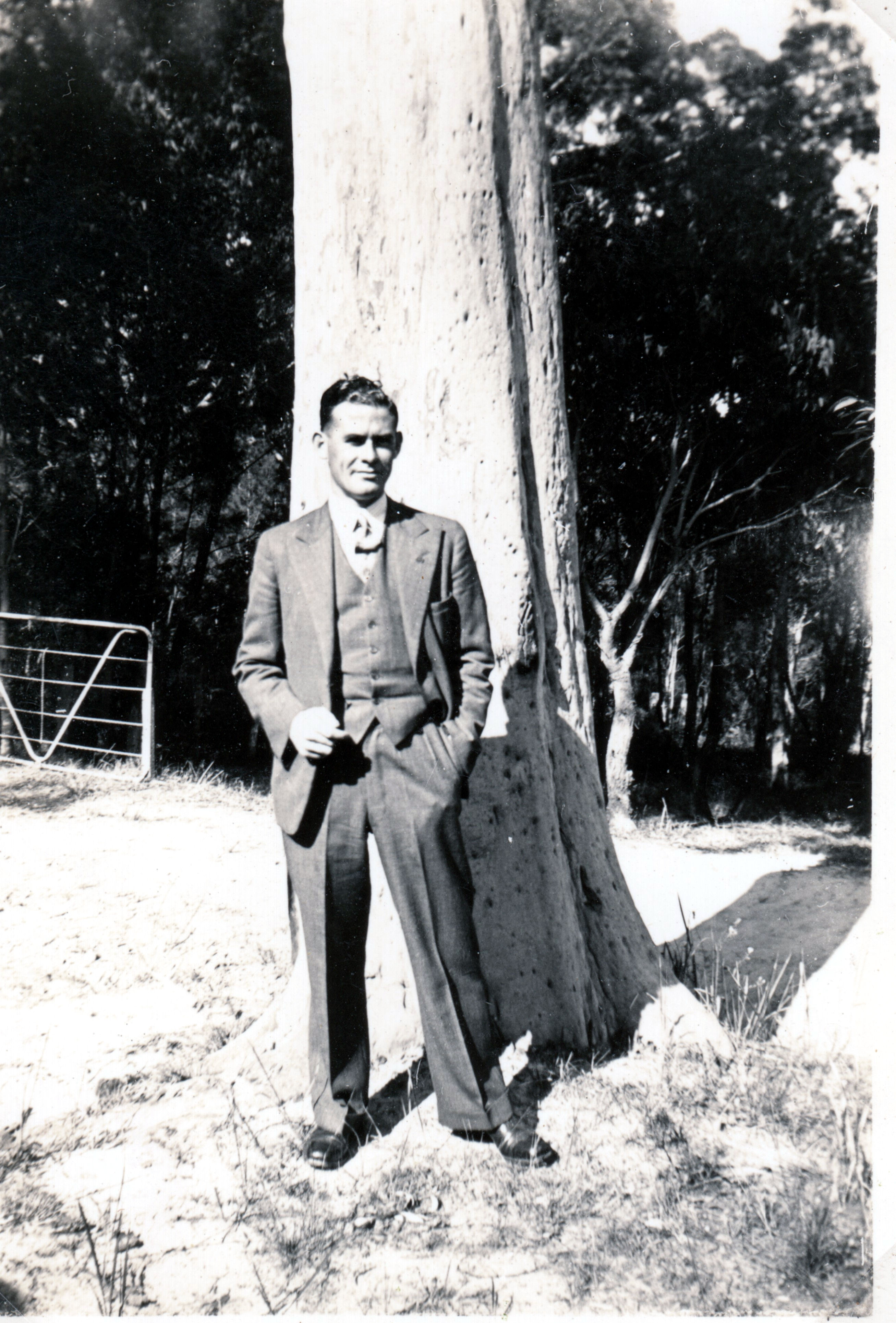
Gunjulla: Geoffrey Grace by The Tree, 1940
Albert Henry Grace and his wife Catherine Ruth Grace were well off. Catherine was originally from Moree and Albert worked as a solicitor there. He moved his family to Wollongong, then to Willoughby, 9 Chiltern Road Willoughby. I have photos of the house there. They owned a Dort car. Quite an expensive car which was imported from America. This is the car in the photos.
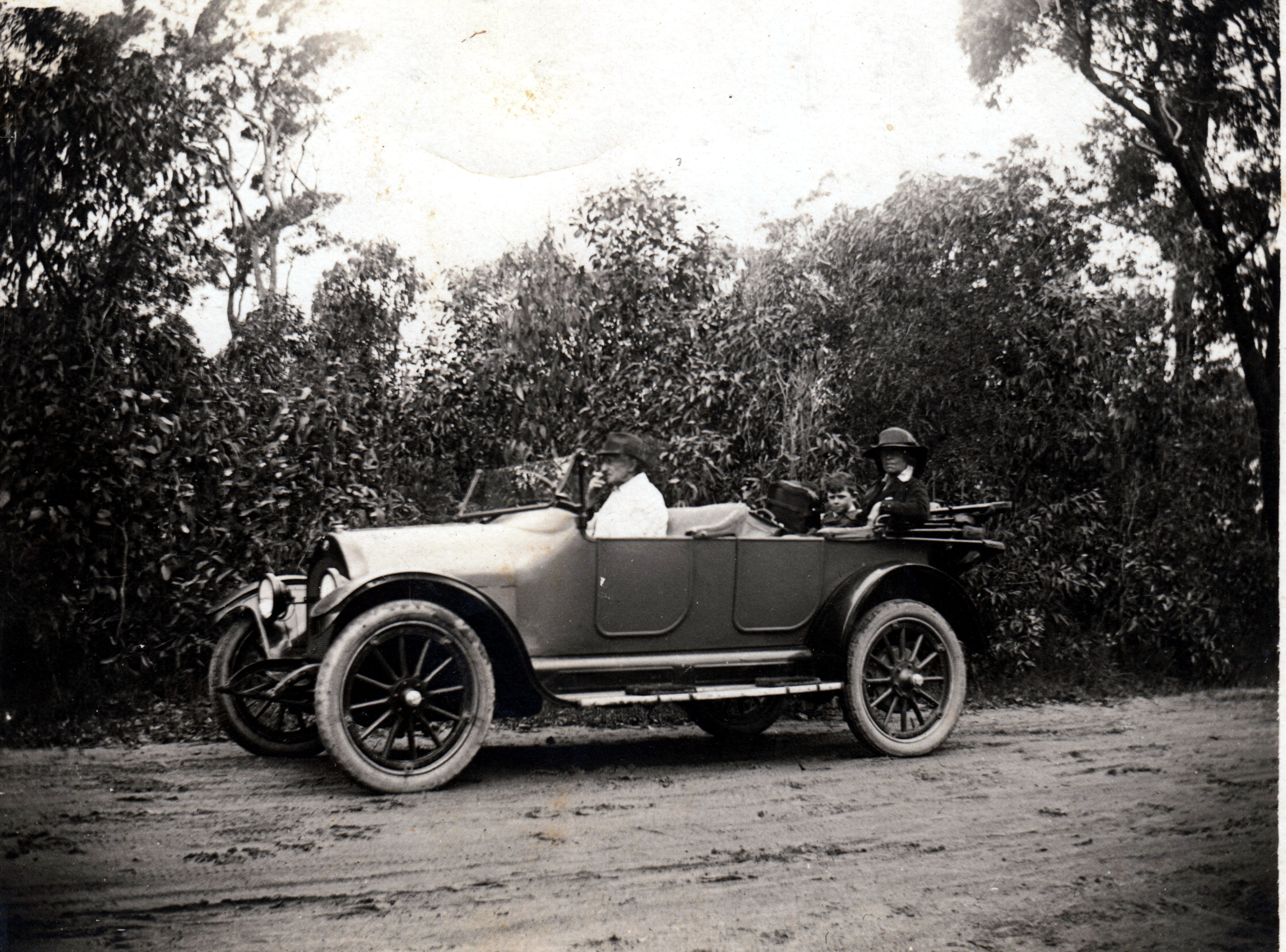
At Gunjulla: Henry and Catherine Grace with young Geoffrey Grace in the Dort - 1922
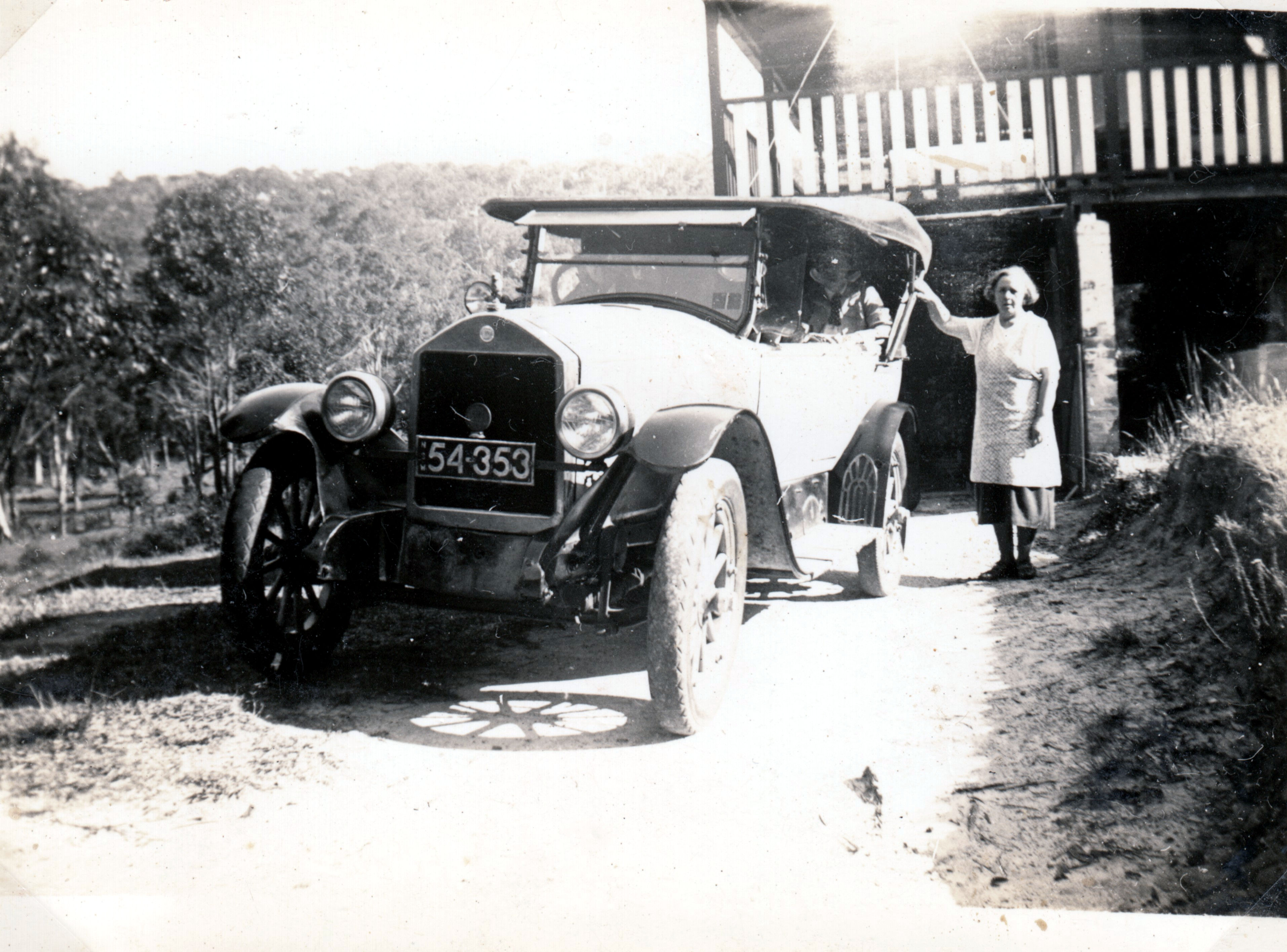
At Gunjulla: Deborah Grace with the Dort
Albert and Catherine purchased the land and called it Gunjulla, which is Aboriginal for a “peaceful place”.
My great grandparents drove from Willoughby to Pittwater. There was only one road into the property called 'Clareville Road'. I think it has been changed now. My grandparents and their children lived at South Hurstville. They used public transport to get to Pittwater. They caught the train to Wynyard then a bus to the “corner store”. Mum says there was only one corner store and from there they walked to the property.
The house had 2 bedrooms a kitchen and a large dining area. There was no bathroom, however, there were washing facilities under the house and an outhouse “dunny”. The older people had the bedrooms while everyone else slept on the large veranda on old army beds. The house had no electricity. Kerosene lamps were used.
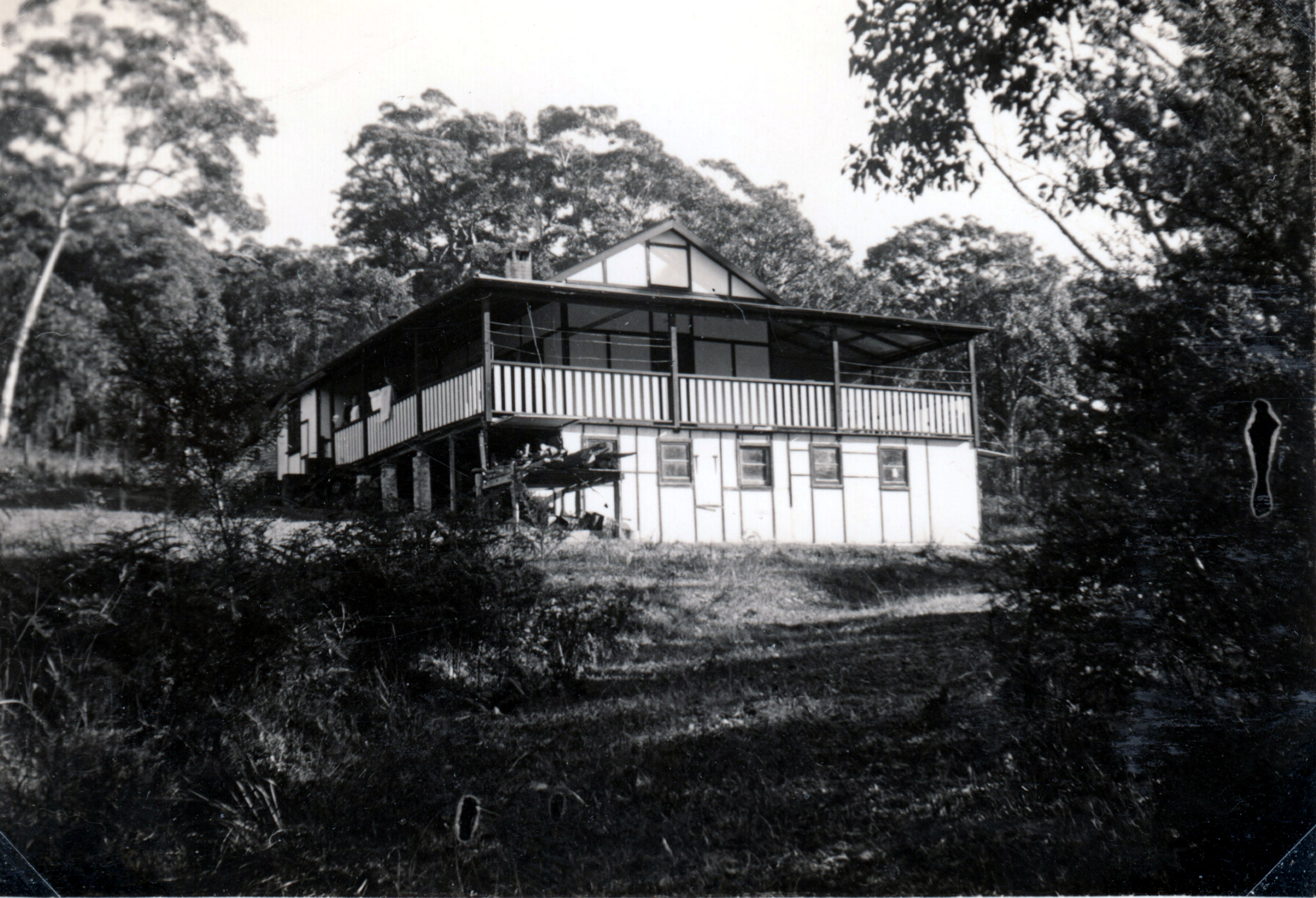
Gunjulla - 1920
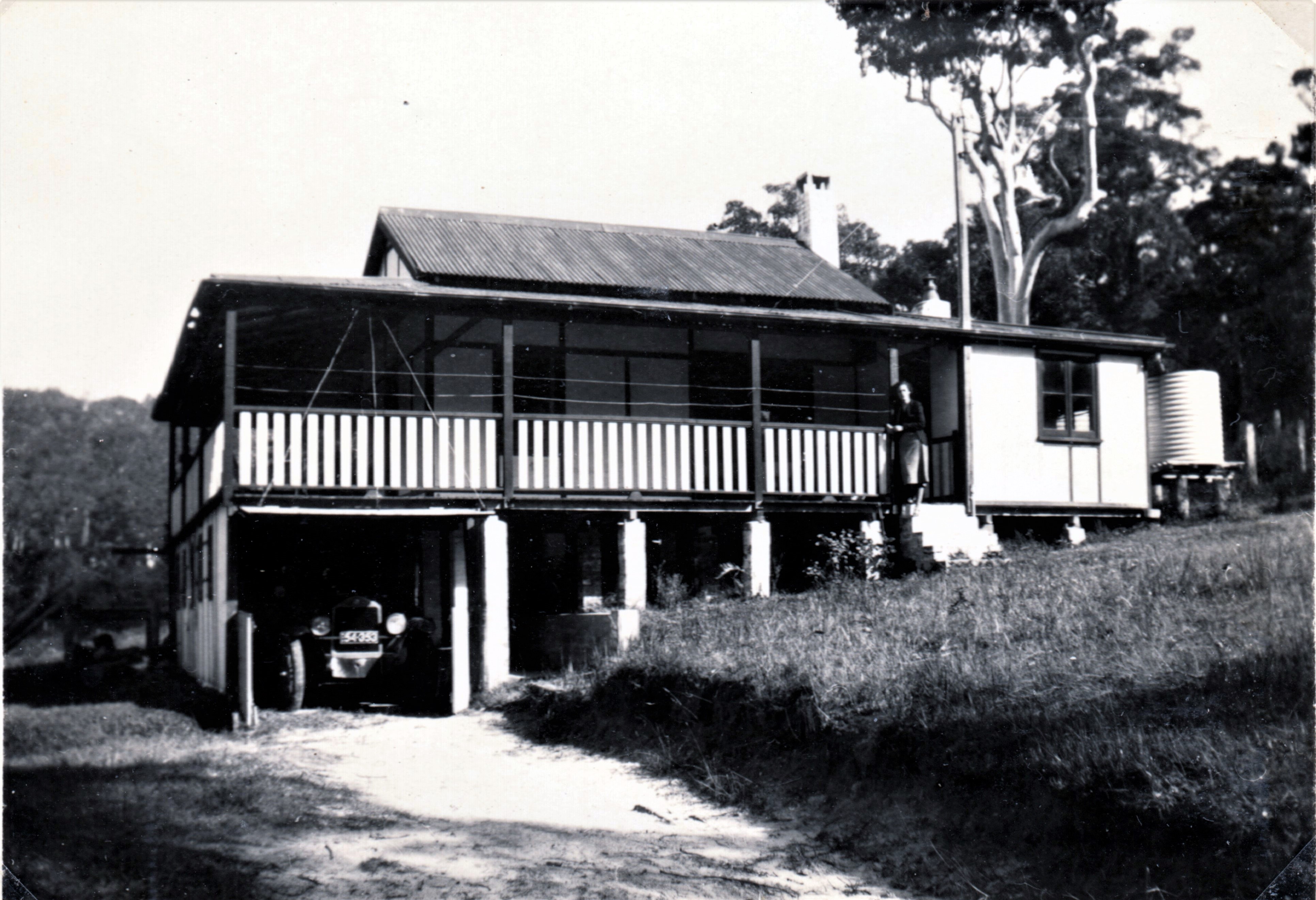
Gunjulla - 1920
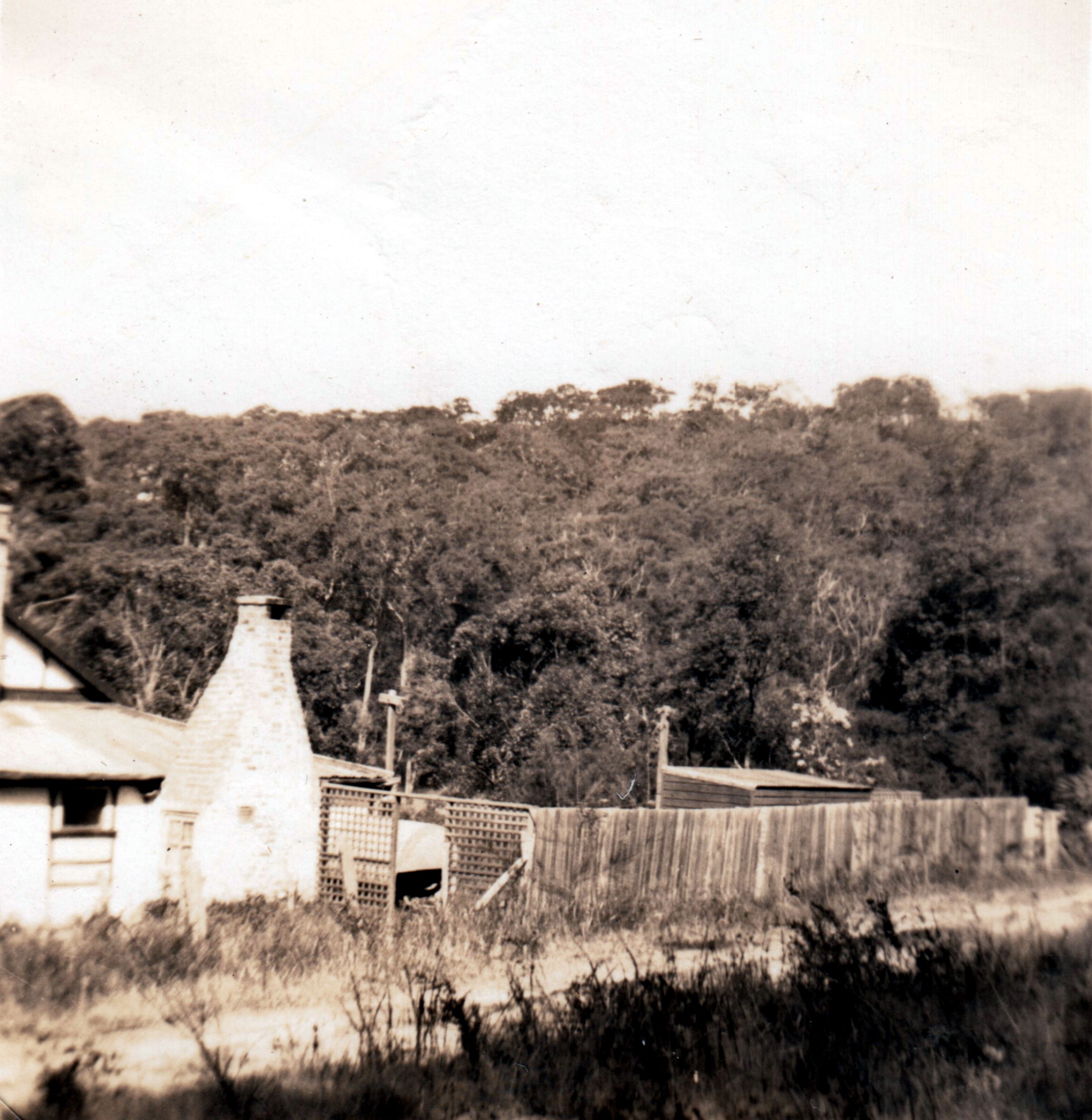
Gunjulla - 1920
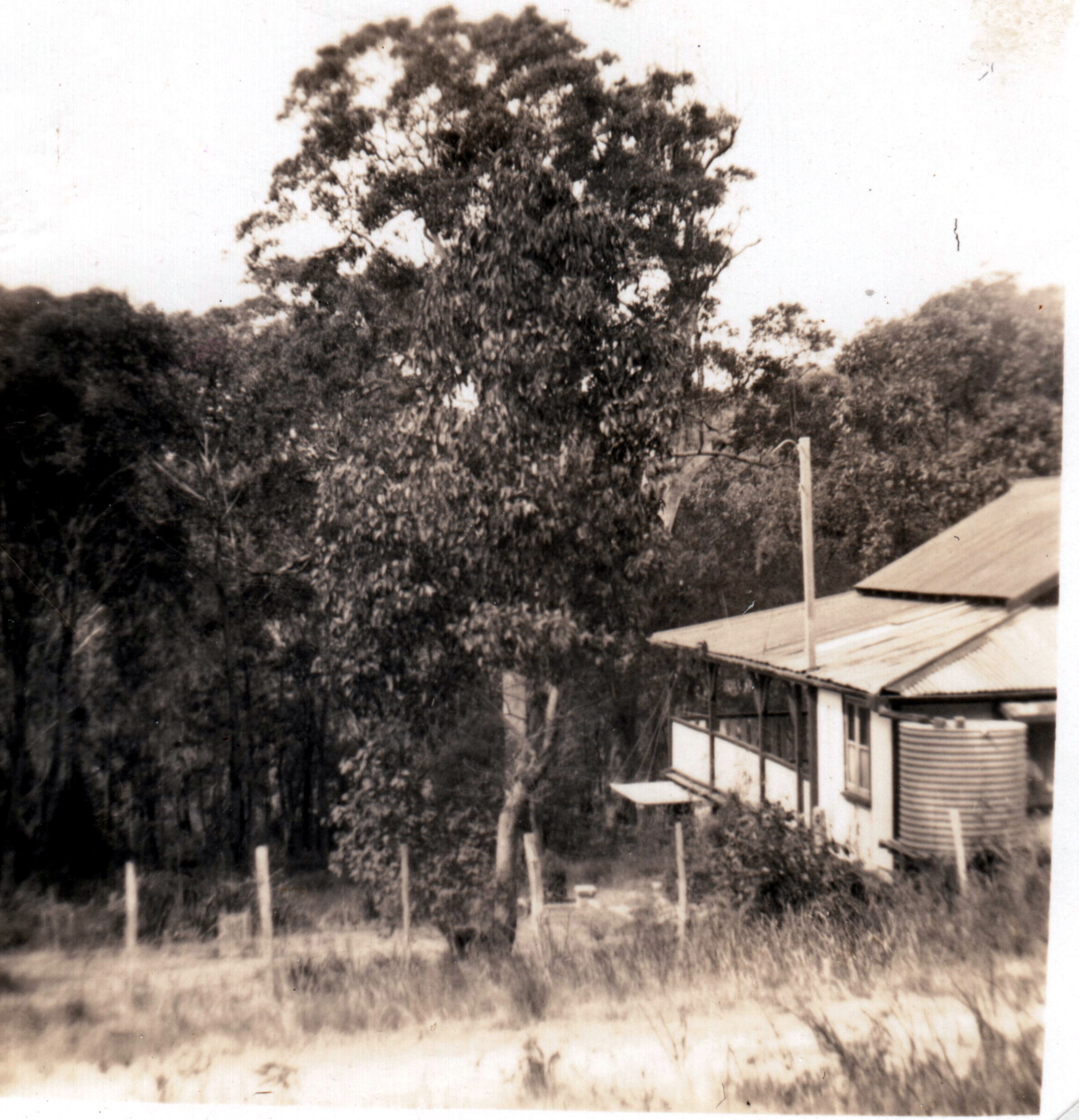
Gunjulla - 1920
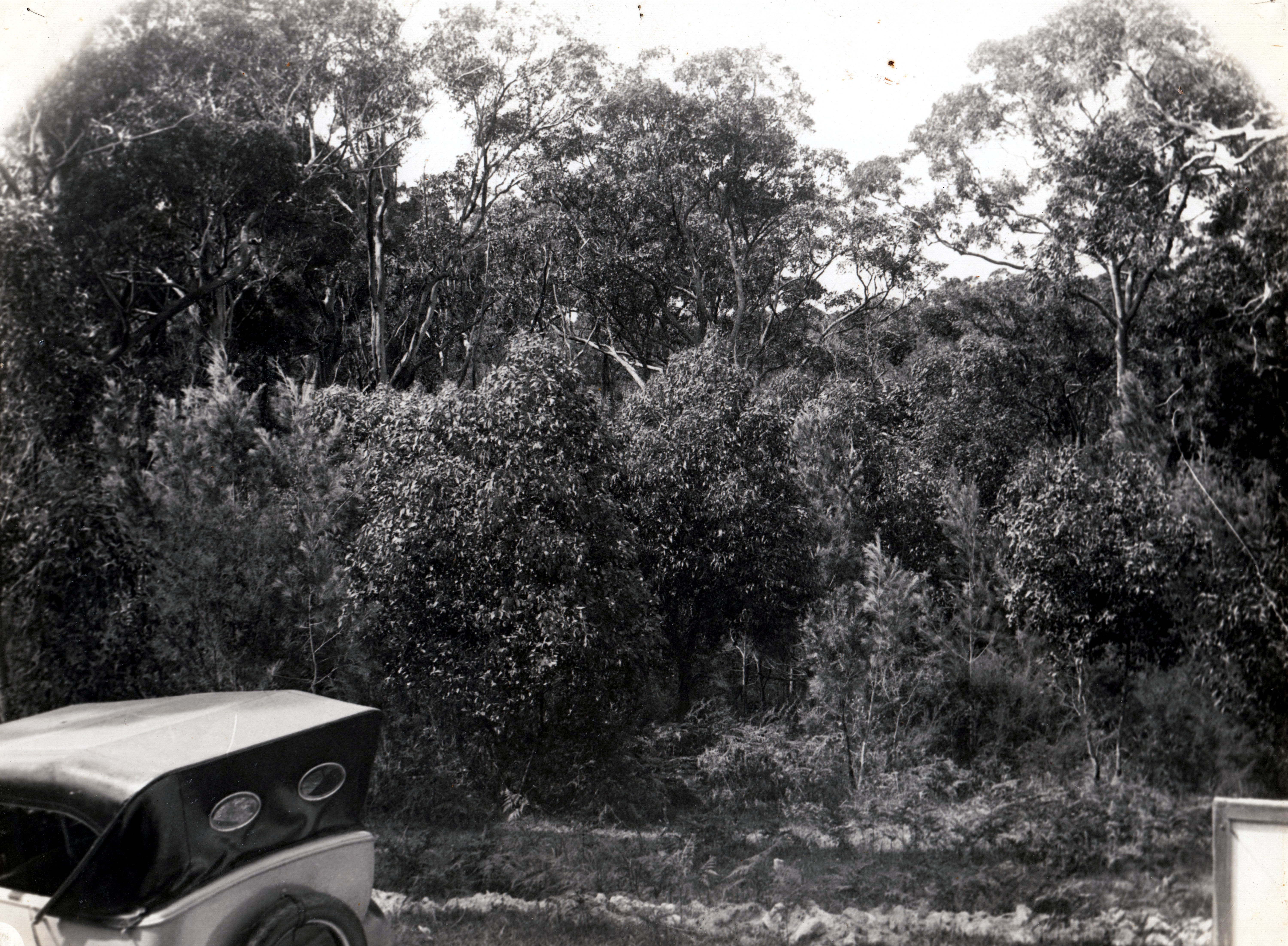
Gunjulla driveway
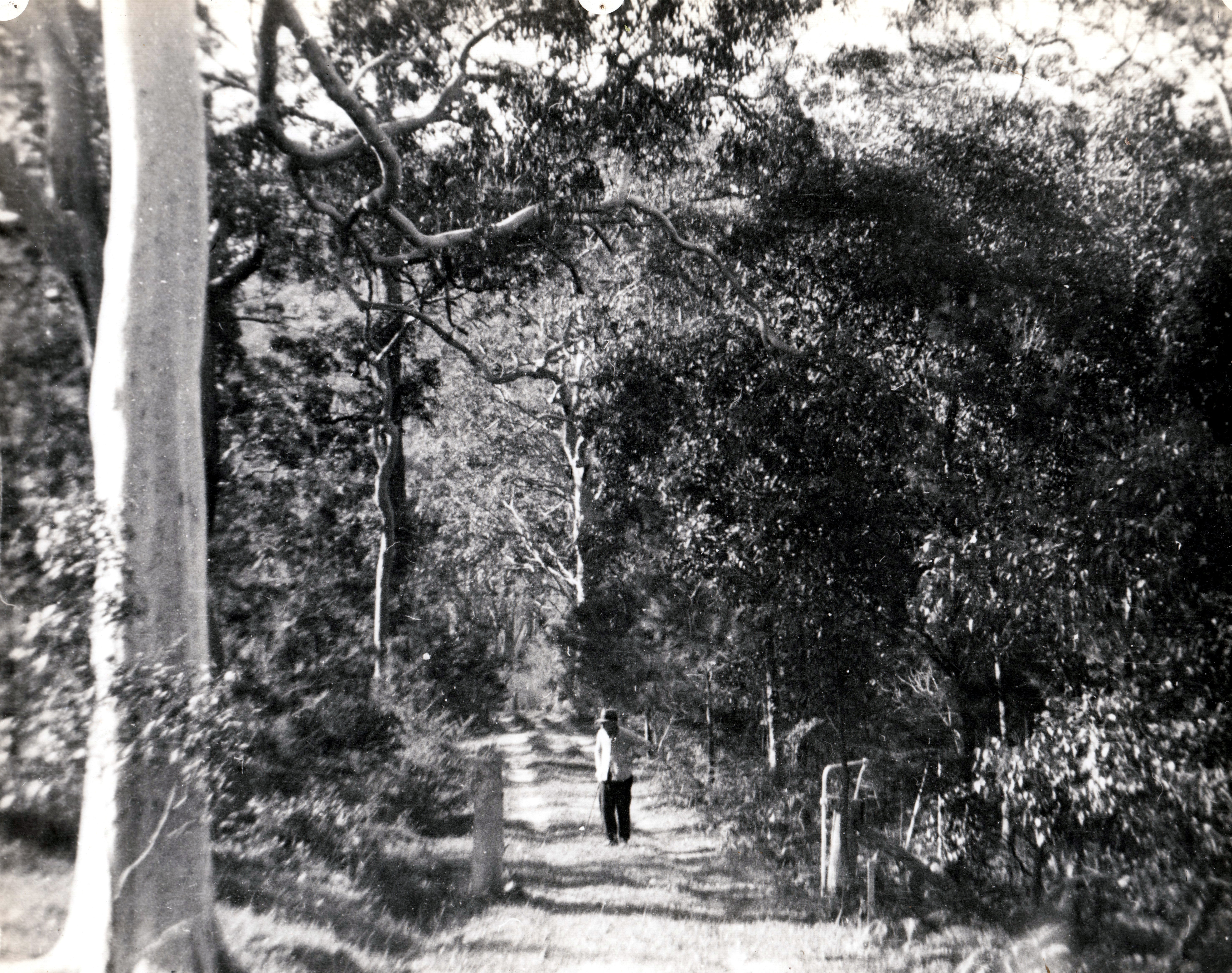
Gunjulla driveway
Upon arrival, Great grandfather would light the cast iron stove and it would stay lit until the last day. Mum said that as soon as the smoke came out of the chimney, the birds would come. Great grandfather Albert had a meat chopping board nailed to the veranda post. He would feed the kookaburras and butcherbirds. There was a large basin in the kitchen and mum was bathed in it as a baby.
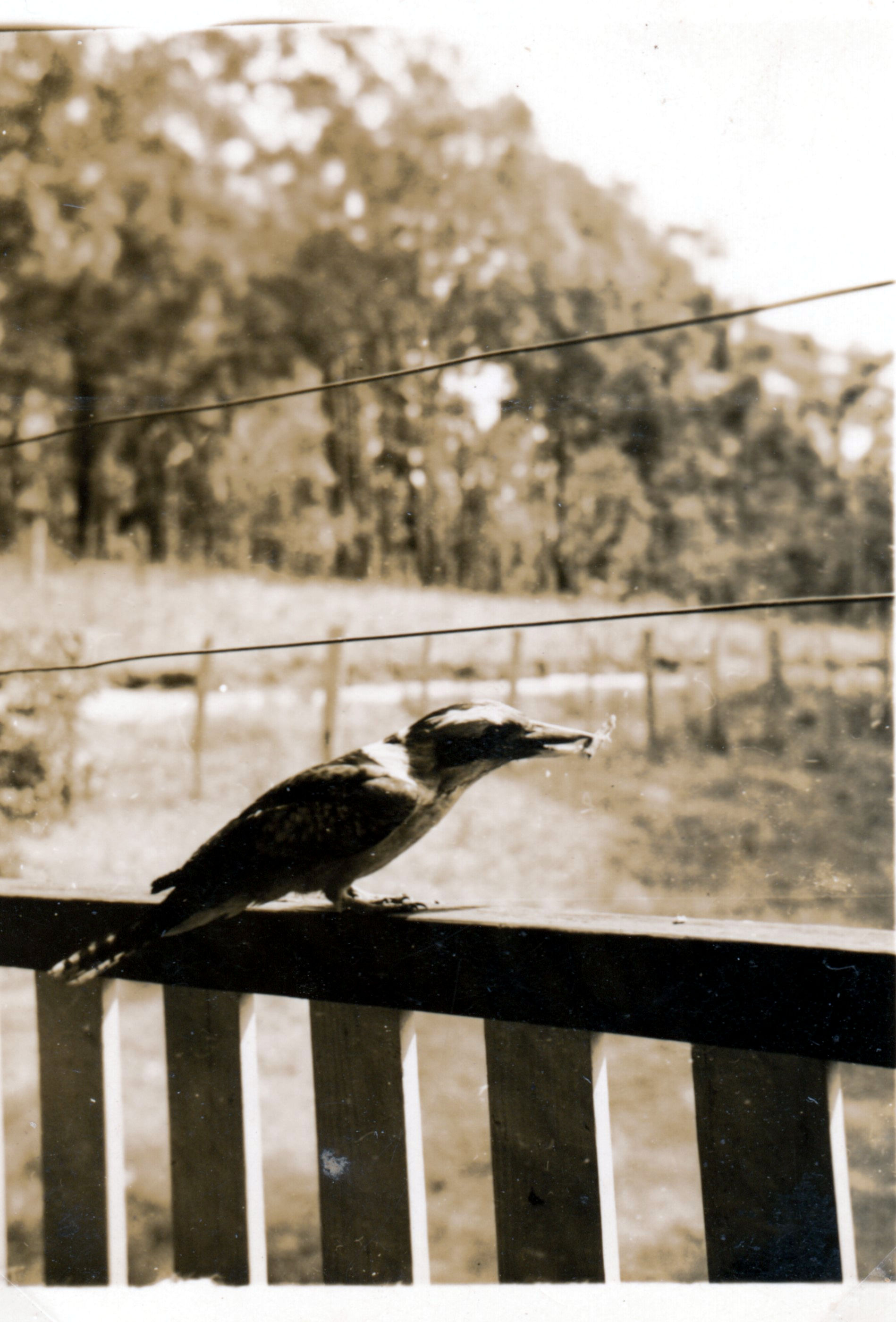
Gunjulla: kookaburra on the verandah
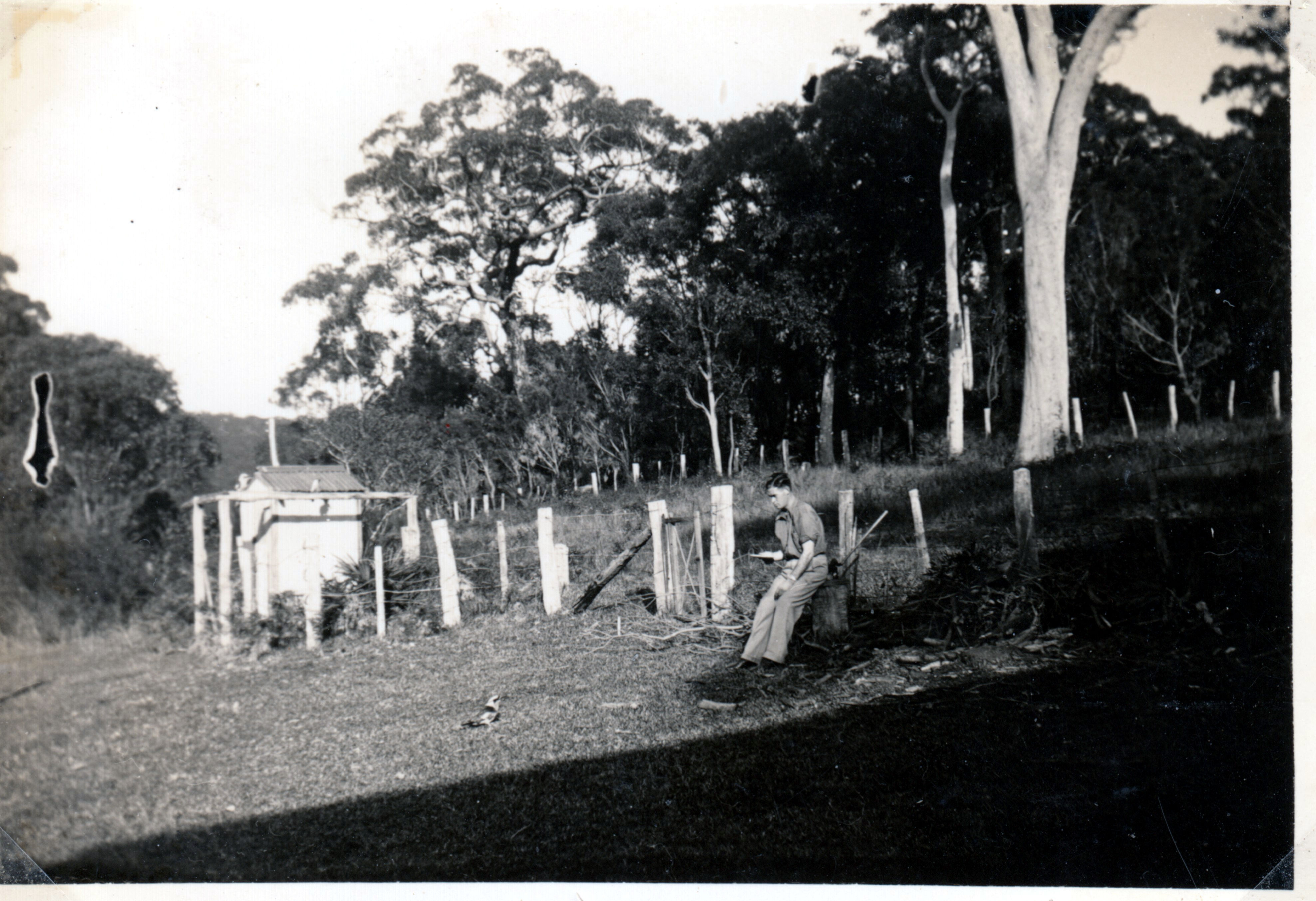
At Gunjulla: Geoffrey feeding the kookaburra 1940
Grandfather Henry would light a “billy” fire outside. Mum said her father had a passion for the smoke that burning gum leaves made. Each tree had its own fragrance. A cup of tea made on a smoking fire outside tasted better than one made inside. I can vouch for this as the utensils my grandfather made came to our house in Caringbah and my mother encouraged us to do the same. All these were hand-made by Henry from old kerosene and cam tins.
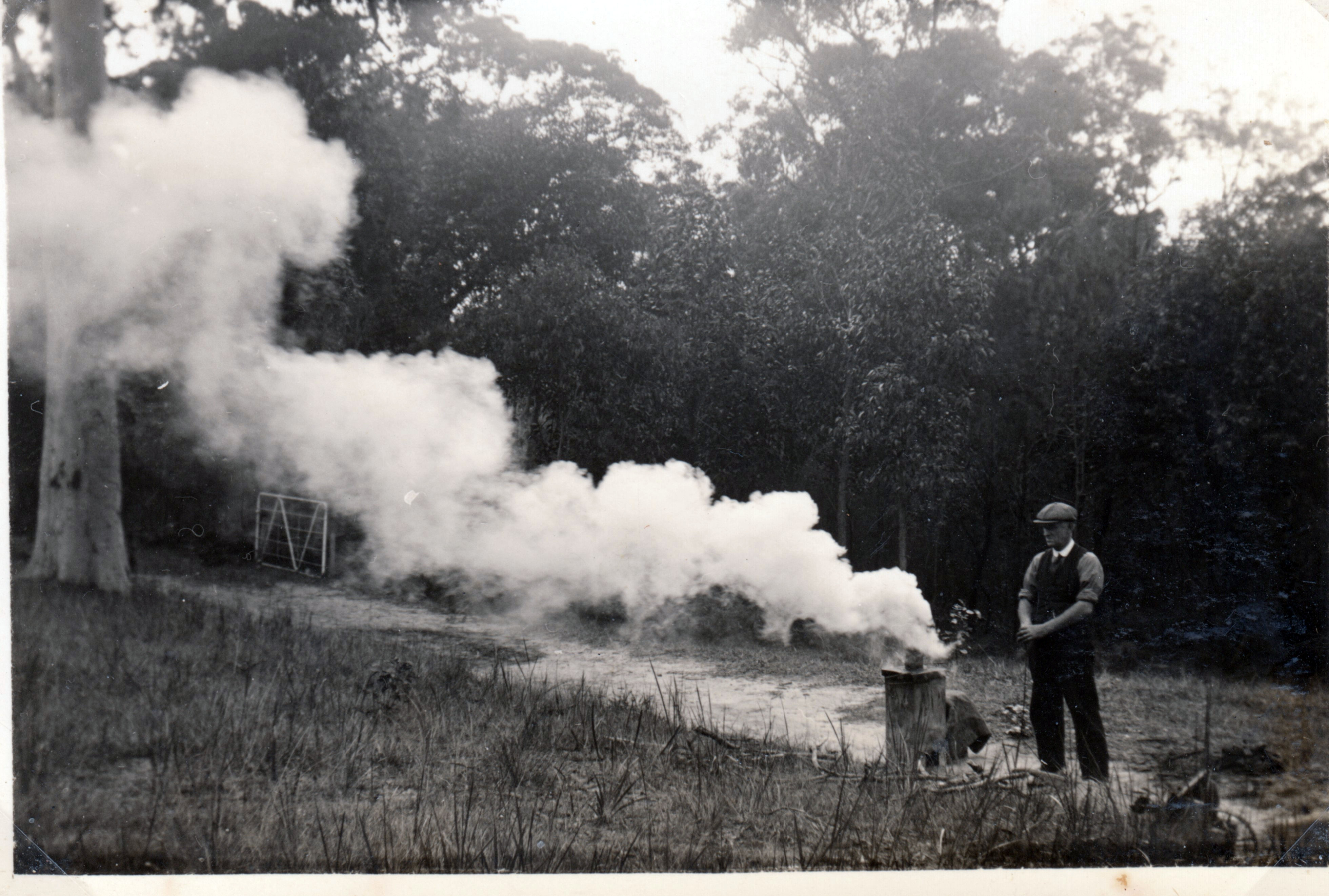
Gunjulla: Henry making smoke
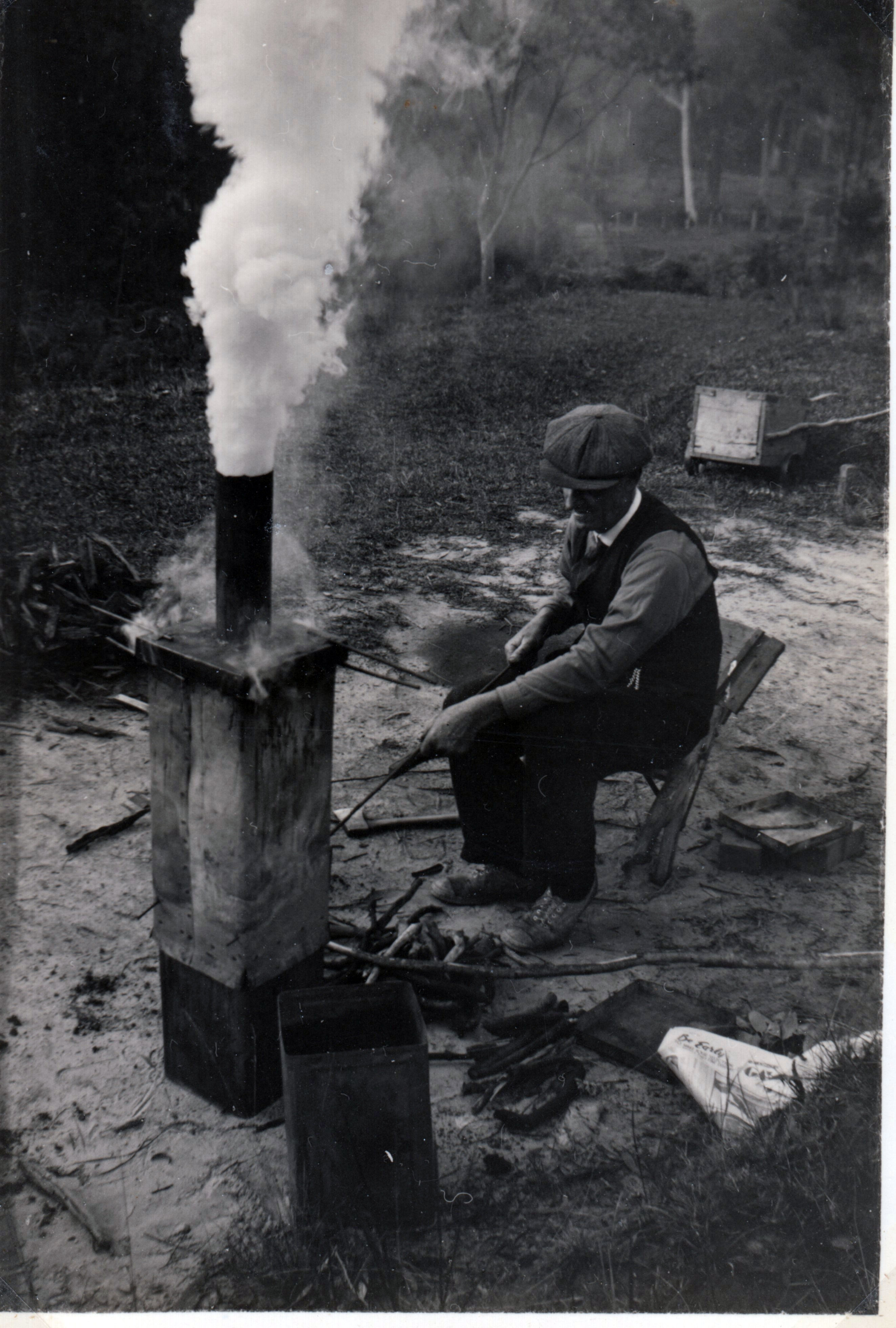
Gunjulla: Henry making smoke by the tree
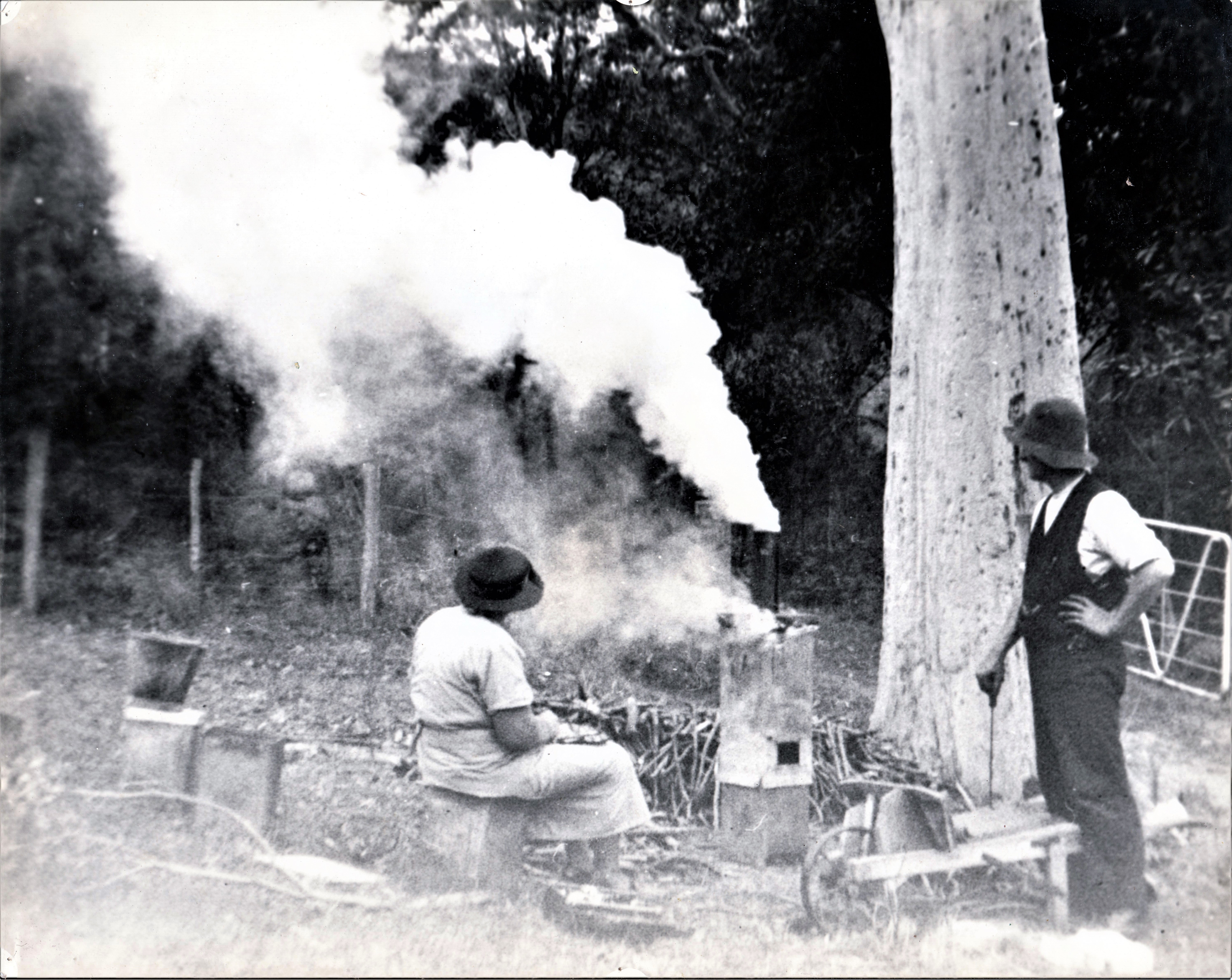
Gunjulla: making smoke by the tree
Mum said the property had koalas. She didn’t elaborate on it, she just said there was plenty of them.
My great-grandmother Catherine was a golf enthusiast. The “green” was basic, but all managed to have a go. It is unknown how many holes the green had or if it was taken seriously.
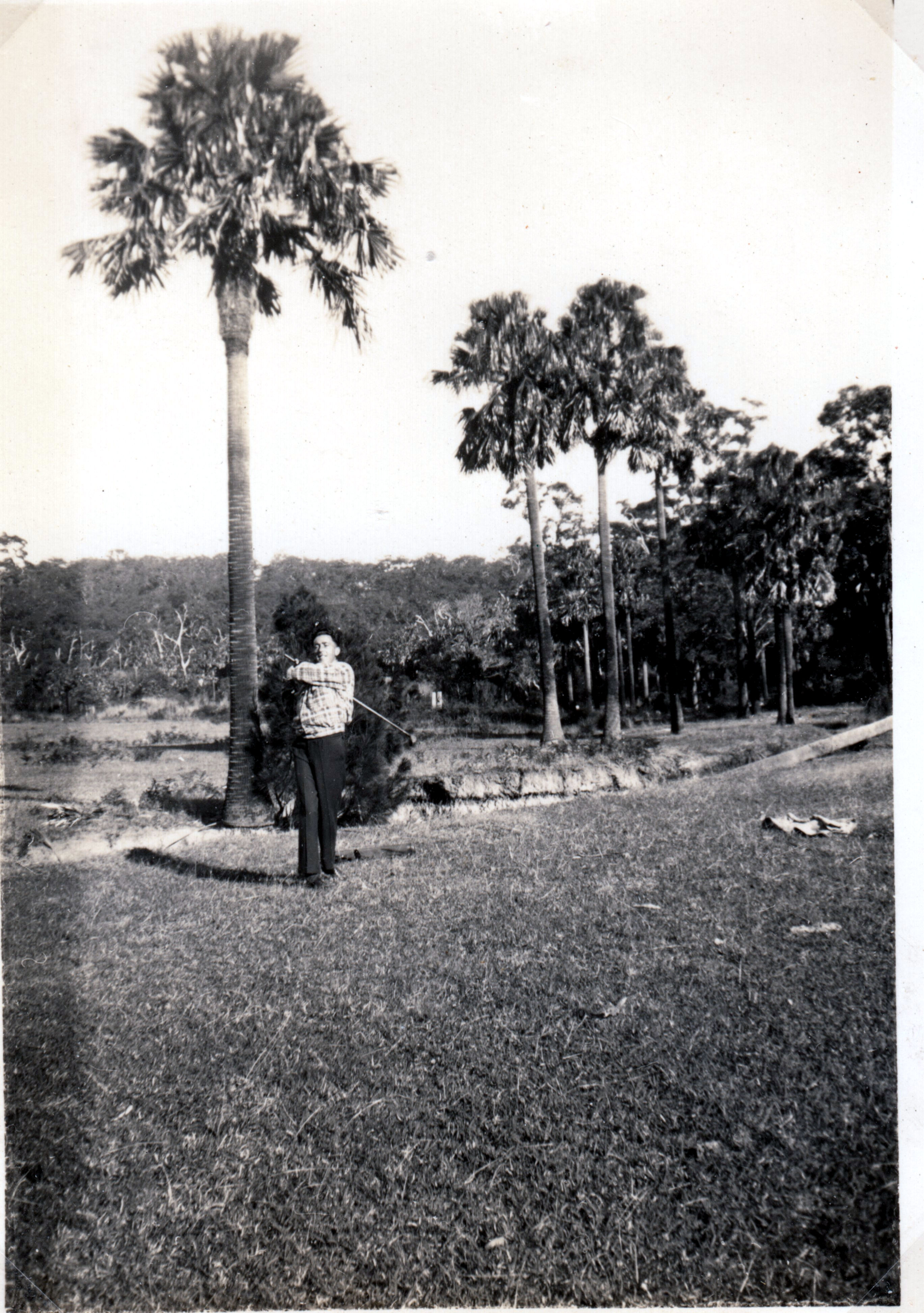
At Gunjulla: the Palms and creek and golf grounds
Bushwalking was the favourite pastime for everyone. Yes, they went to the beach, but mum seldom went swimming. Her father, Henry had a boat and he would take mum out to look at the rocks. She said she never saw any neighbours, it was all bush.
Her fondest memories of the place were of the family being together. Everyone loved the outdoors and a chance to escape their busy lives. This passion for the outdoor was enjoyed by all the families right up till their deaths.
On their walk to the property they all collected mushrooms. Catherine Grace fried them in butter for breakfast. There were mushrooms on the property and they ate them every morning. They bought meats and vegetables from the corner store at Avalon or they brought favourite foods with them. they had no fridge. Every night they ate well and mum remembered the stews were delicious.
After dinner they played parlour style games such was cards or Chinese checkers. Catherine was in charge of card games and Albert was keen on Chinese checkers and draughts. Albert always won. Half way through the game Albert took his teeth and secretly put them in his pocket.
During the day Catherine would instruct everyone in craft. It was during the war and Catherine got her grandchildren to knit socks for soldiers. Catherine would collect clay from the creek and make sculptures. We still have a sculpture she made. She was also keen on embroidery. My mum said she could look at clothing and make it without a pattern. She could see how things work. Millicent Grace inherited this skill.
During the day they would walk to the beach. No houses were there and flannel flowers grew everywhere. Mum remembered Ruskin Rowes’ house being " Cabbage Tree....something?" because of the property being covered in cabbage trees. He was a successful business man. This is all she knew.
On November 26th, 1926 Albert Henry Grace sold some of his land to Harry Ruskin Rowe - HRLV provides:
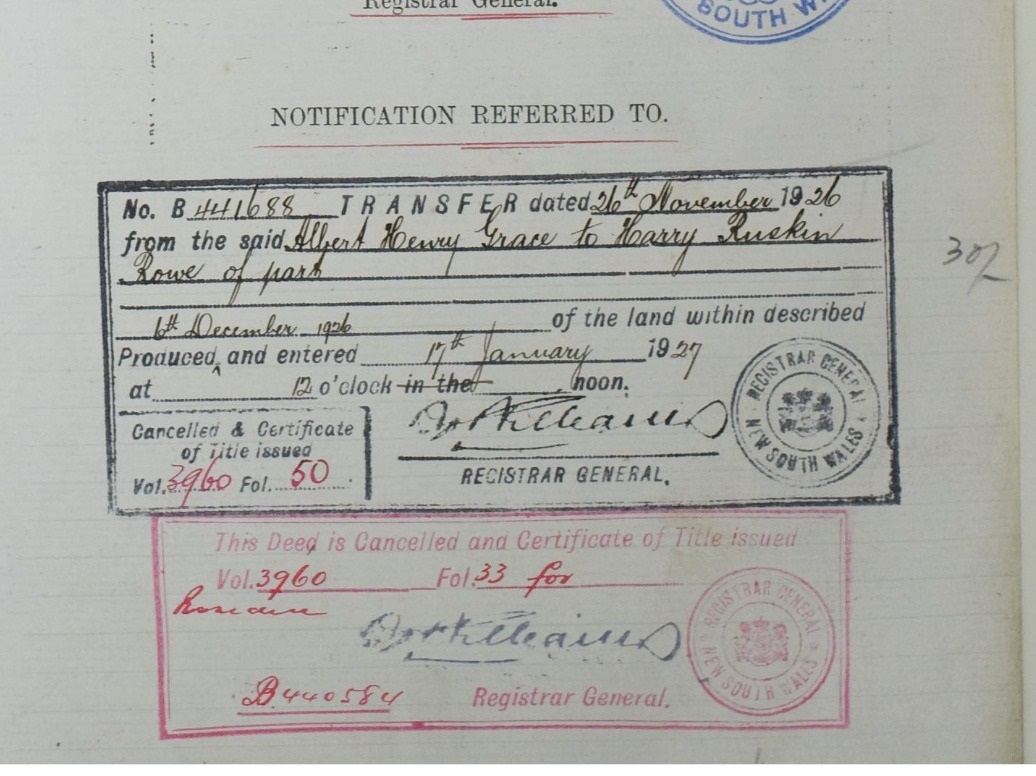
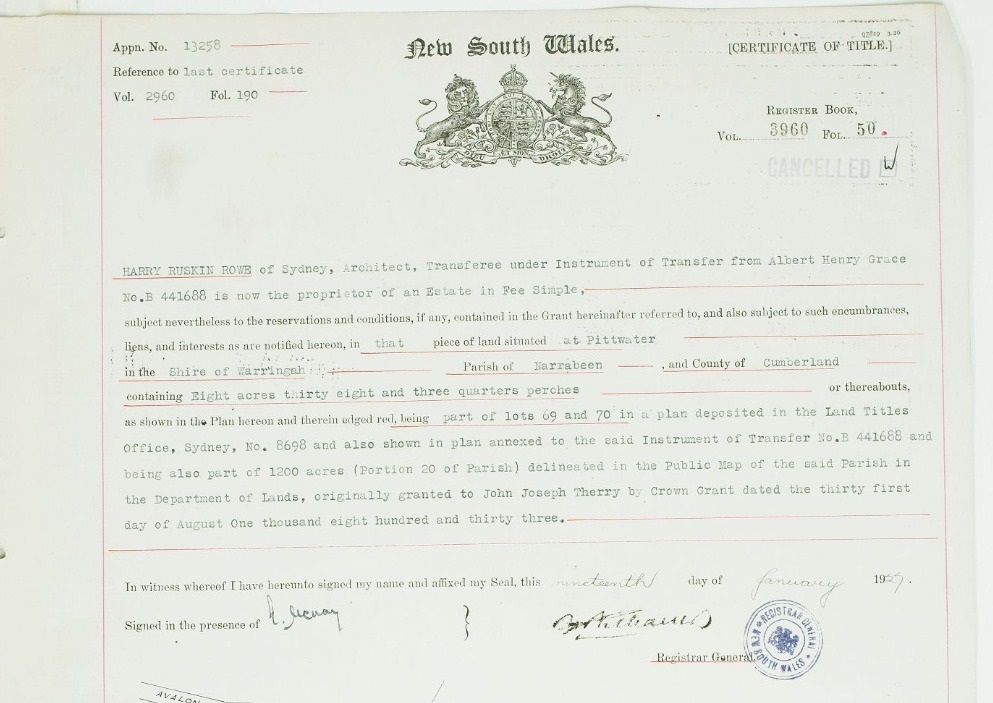
%20Harry%20Ruskin%20Rowe%20Grace%20lands%20base.jpg?timestamp=1637208231872)
With World War Two erupting, and much of the Barrenjoey end of Pittwater cut off by tank traps at the Mona Vale-Bungan hilltop, Helen's Great Grandfather sold the rest of his land in 1941 to Lillie Marion Searle of Waverton, on October 9th, 1941 who sold the 3 acres to Harry Ruskin Rowe on December 19th, 1941, later that year and who allowed training camps to be held there during this conflict.
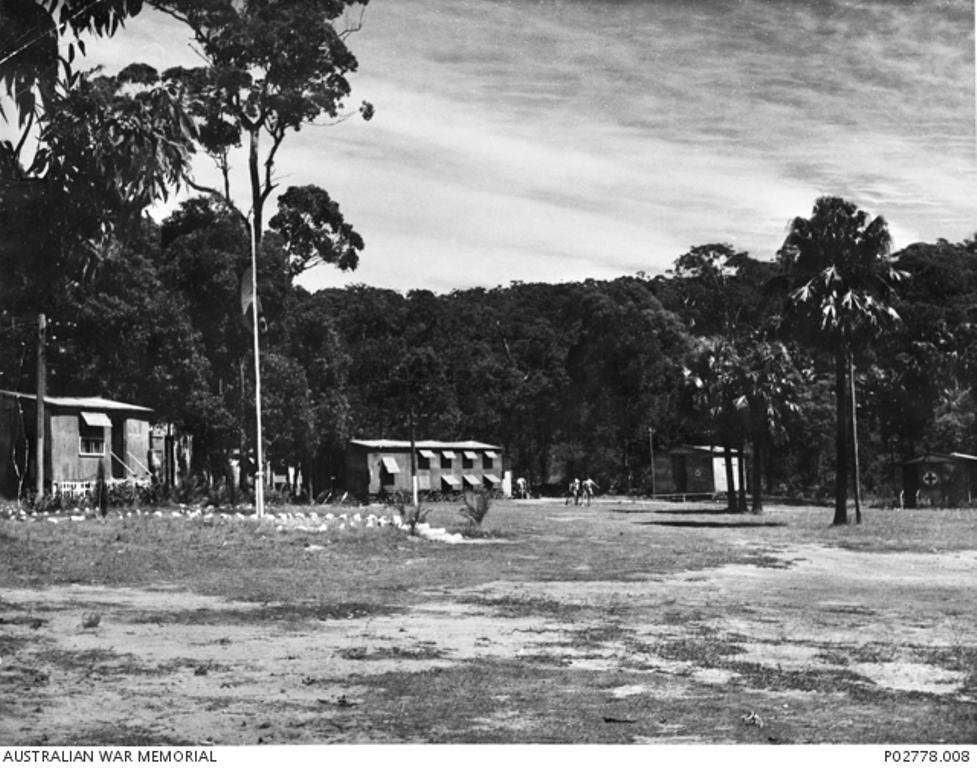
HRLV provides:
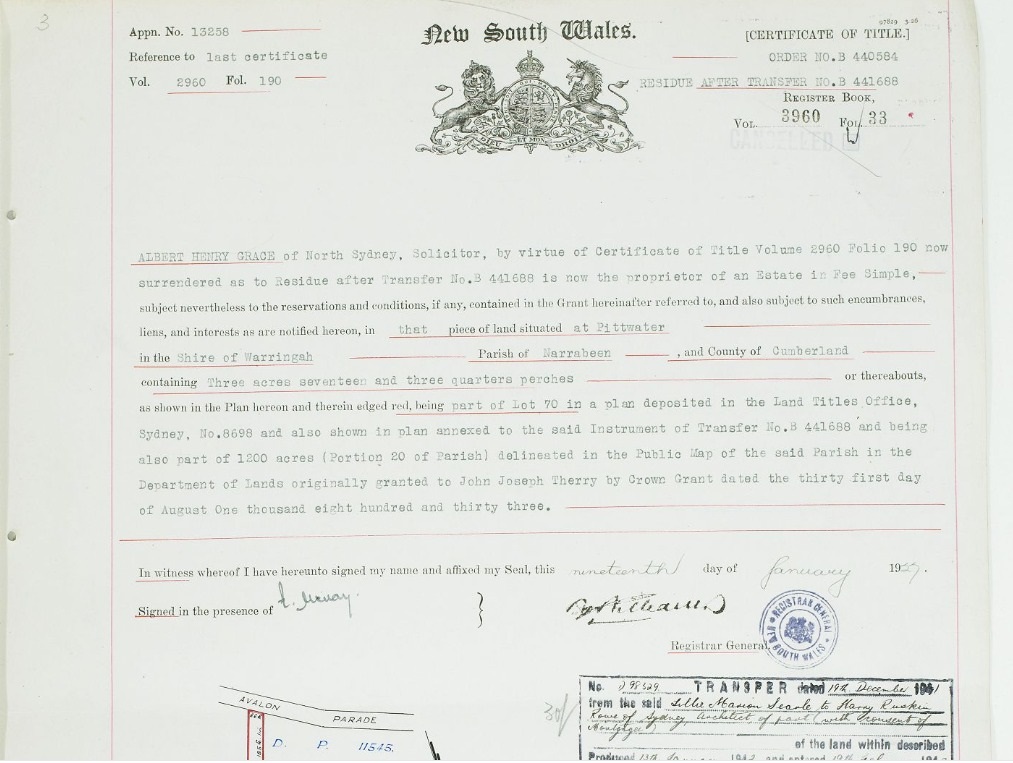
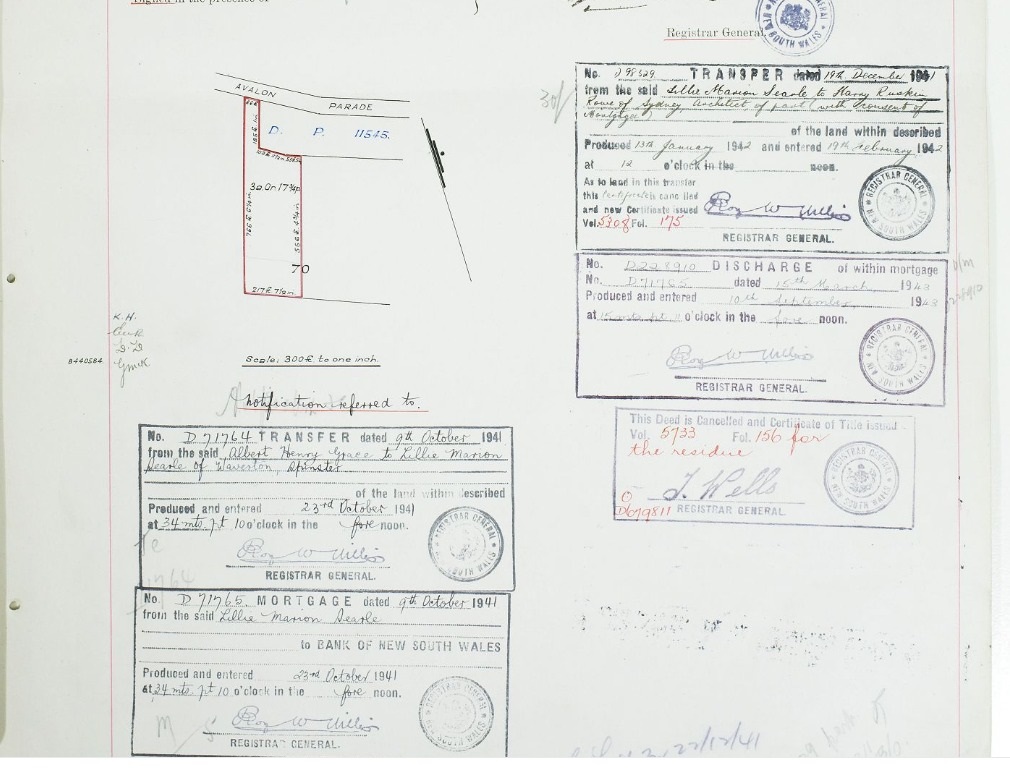
%20Albert%20Grace%20sells%20to%20Searle.jpg?timestamp=1637209081962)
%20Albert%20Grace%20sells%20to%20Searle.jpg?timestamp=1637209132231)
The home, Gunjulla, also featured in an advertisement for coffee in 1996.
Re: coffee commercial in 1996. I was there with our neighbours, Sally and Ross Wishart, who owned Gunjulla at the time. Nestle were filming. The photo shown is almost certainly an older photo as the eastern side of the wrap around verandah is not enclosed for the main bed and bath and also the neighbours house is not visible next door. My guess is the photo would be prior to the mid 70s. - Carina Meurer
Grace family photo:
Gunjulla, 1968
Henry Albert Grace is famous for being ‘’The Bird Man’’. Henry was an electrician and bird enthusiast. He was born on June 28th 1885 at Moree, New South Wales, eldest of five children of Albert Henry Grace, solicitor, and his wife Catherine Ruth, née Muirson.
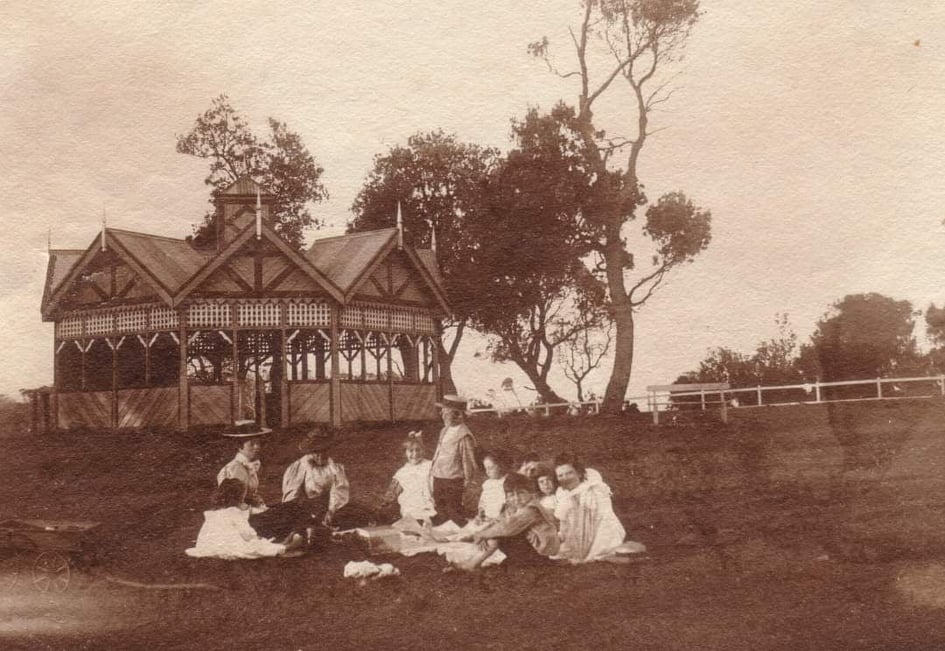
1890s - Henry Albert Grace as a boy reciting poetry in Stuart Park Wollongong
Henry worked as an electrician on shift work for the New South Wales Government Railways and Tramways for forty-five years.
In 1910 he was in England, as on August 2nd of that year in the parish church at Erdington, Warwickshire, he married Deborah Watling Carter, from Norfolk. Next year he worked as an electrical switchboard attendant at Wolverhampton.
Back in Sydney the family lived at Willoughby; after World War II they moved to Jannali.
Henry had first taken up his hobby of bird watching in 1917, although clearly he had a passion for birds prior to then. Taking an old police bicycle given to him by his father in 1896, he would take the steam train south from Sydney to the Royal National Park, where he was an honorary ranger for twenty-seven years.
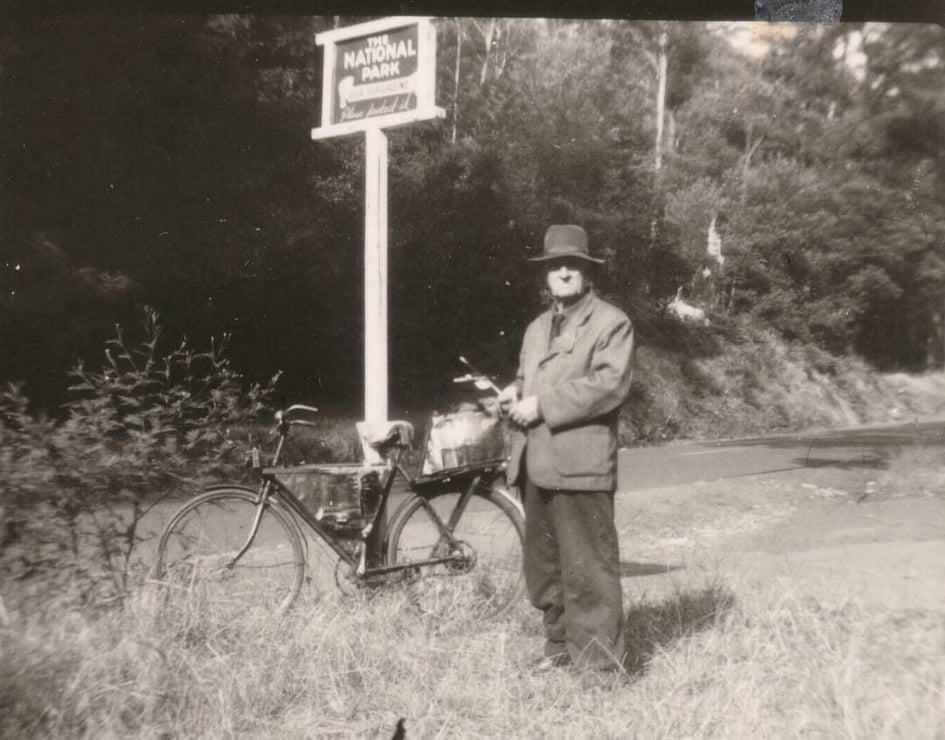
Henry with his bike
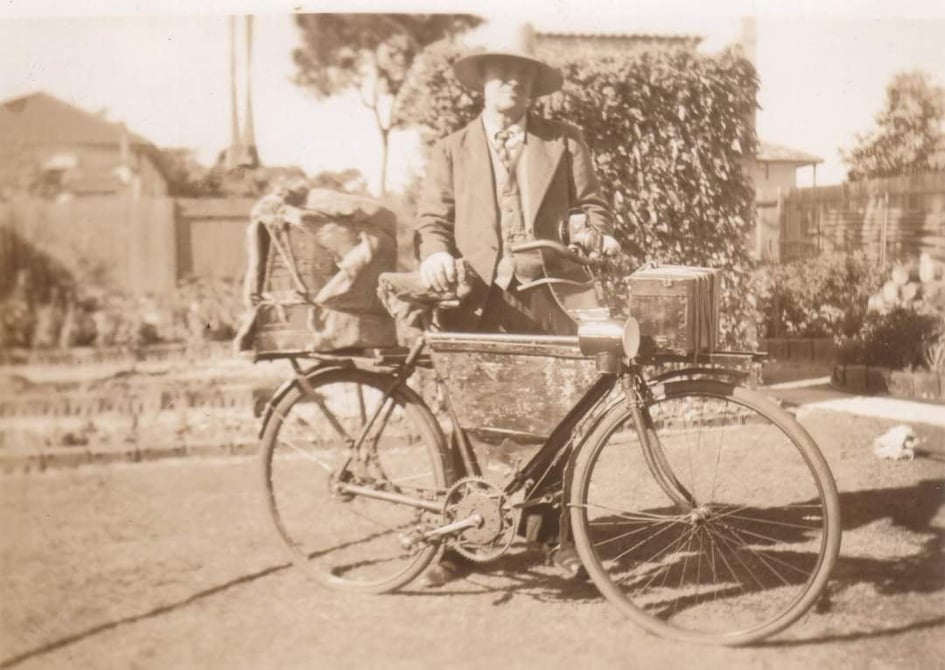
Henry with his bike
During his working life he maintained a love for the bush and nature. After retiring, he devoted himself to bird watching or more precisely bird listening, for which purpose he designed his own whistles so that he might 'talk with the birds'.
From his backyard workshop, Grace painstakingly constructed a series of extraordinary instruments, fashioned from old brass tubing, wire and rubber bands. In the National Park he would test the whistles in the wild, using his own birdcall notation (said to be a cross between Morse code and shorthand) to record the songs he heard in reply. He could imitate some sixty native species with his whistles, often with such perfection that he would fool the birds themselves—they would imitate each other.
At times he ranged further afield, catching the train to Otford or Thirroul loaded with bicycle, whistles, firewood and supplies and then riding into the bushland, often camping out overnight. His favourite sound was the dawn chorus:
'First the yellow robin, then the coachwhip, the currawongs, and the kookaburras. Finally the wonga-wonga and bronze-wing pigeons and orioles would join in . . . The chorus only lasts about 20 minutes, but it was worth camping out all night to hear', he said.
When his hearing became impaired, Henry built himself metal ear trumpets, which enabled him to hear the sounds he had cherished throughout his lifetime. As he aged and his memory became rusty, he would increasingly refer to his exercise books full of birdcall notations, to remind himself of the calls.
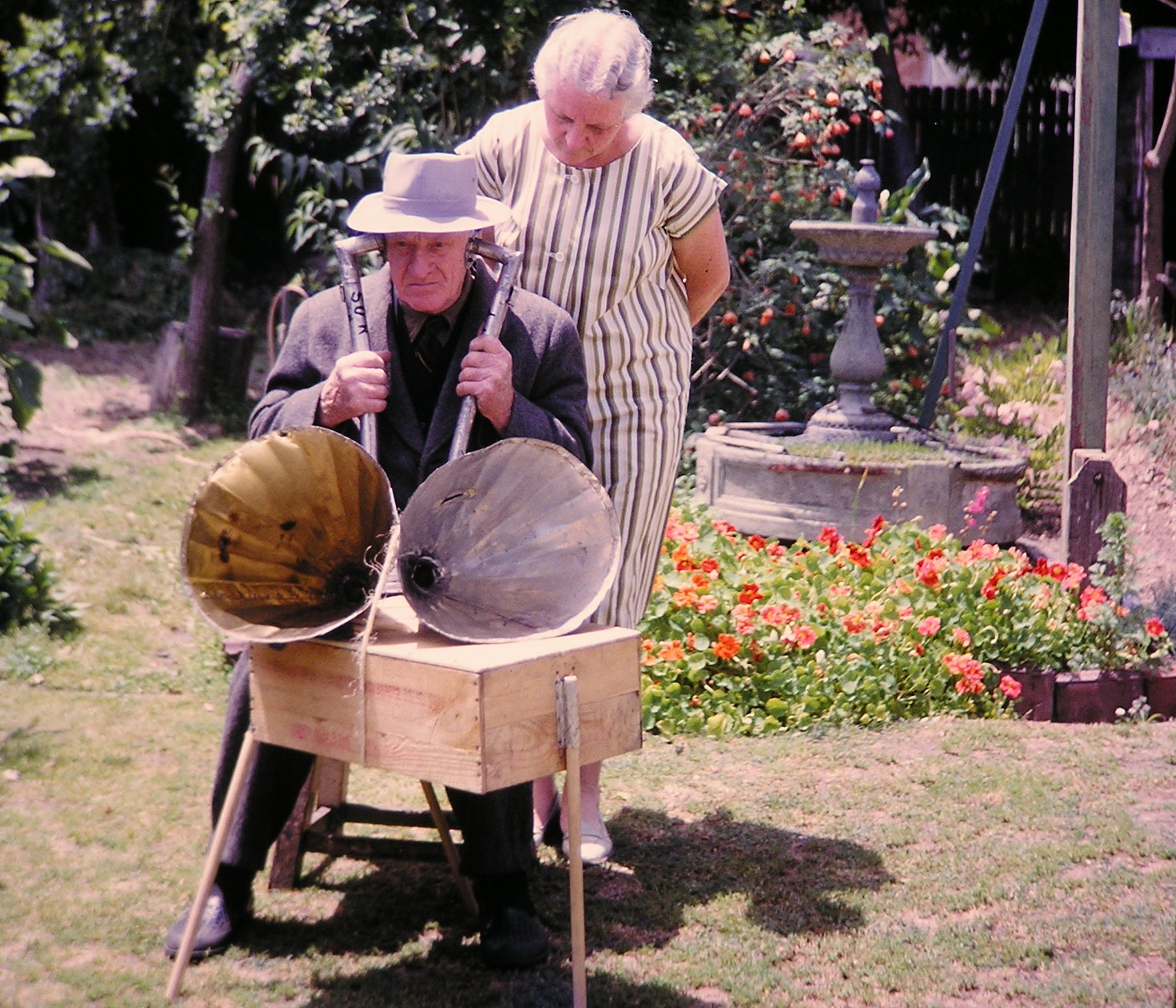
Henry Albert Grace with his hand made ear trumpets
Henry visited the Minimurra falls regularly until his eightieth year, travelling by train to Wollongong then pushing his bike thirty miles (48 km) to the reserve.
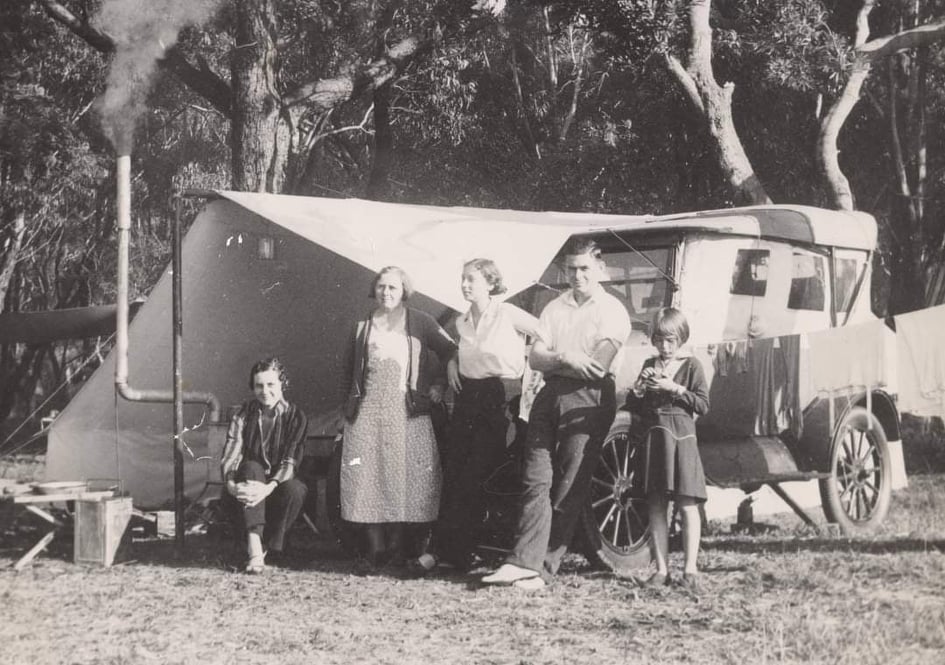
1937 The Grace family on Christmas vacation Stuart Park Wollongong
He passed away on July 4th 1966 in hospital at Caringbah and was cremated with Anglican rites. His wife, four daughters and son survived him and went on to have children of their own.
In 1999 Grace's whistles, notebooks, bicycle and a 16-mm film of him in the Royal National Park featured in an exhibition at the State Library of New South Wales, 'Sydney Eccentrics: A Celebration of Individuals in Society'.
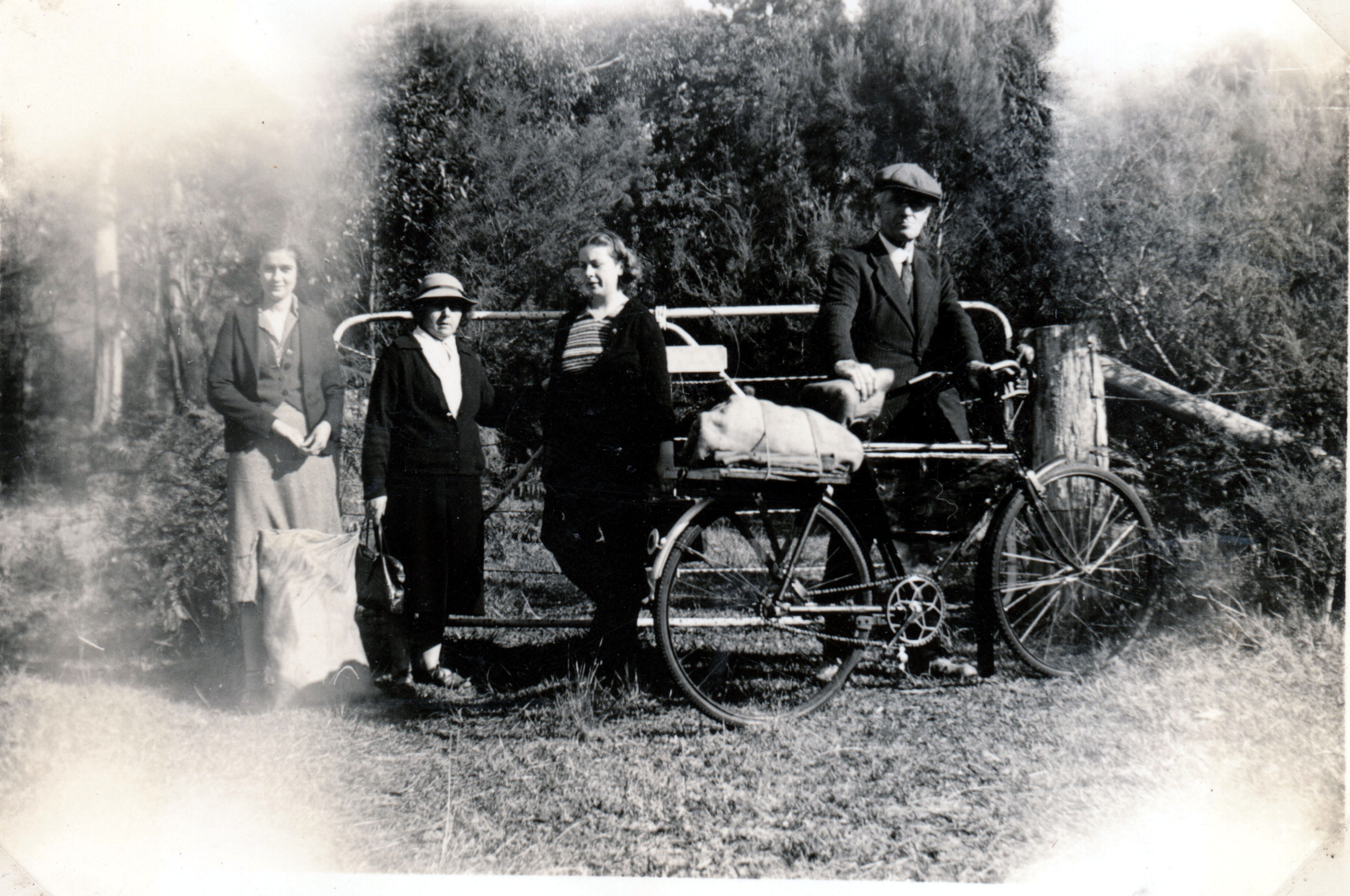
At Gunjulla front gate: Joyce, Deborah, Gwendolyn and Henry with his bike
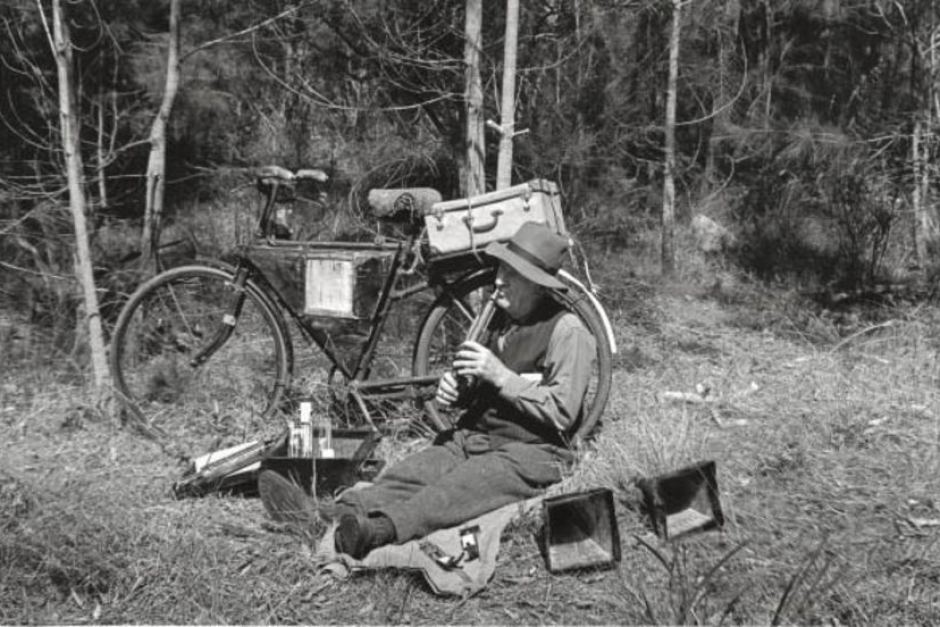
Henry with his bird whistles
Some extra Grace - Grant family photos - the community ios fortunate that Albert Henry Grace was a photographer and fortunate again in Helen and her mum Deborah have shared these images:
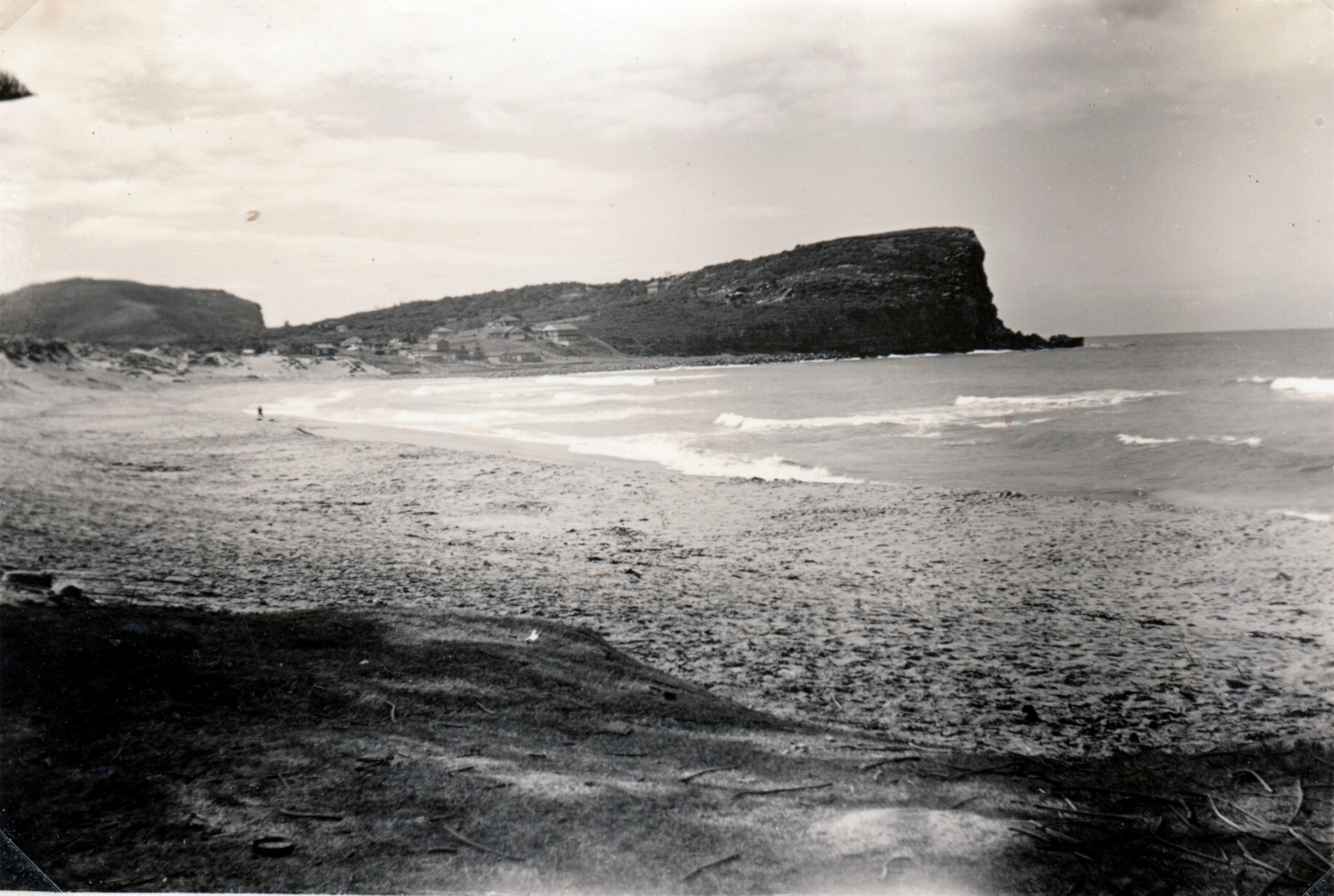
Avalon Beach 1920
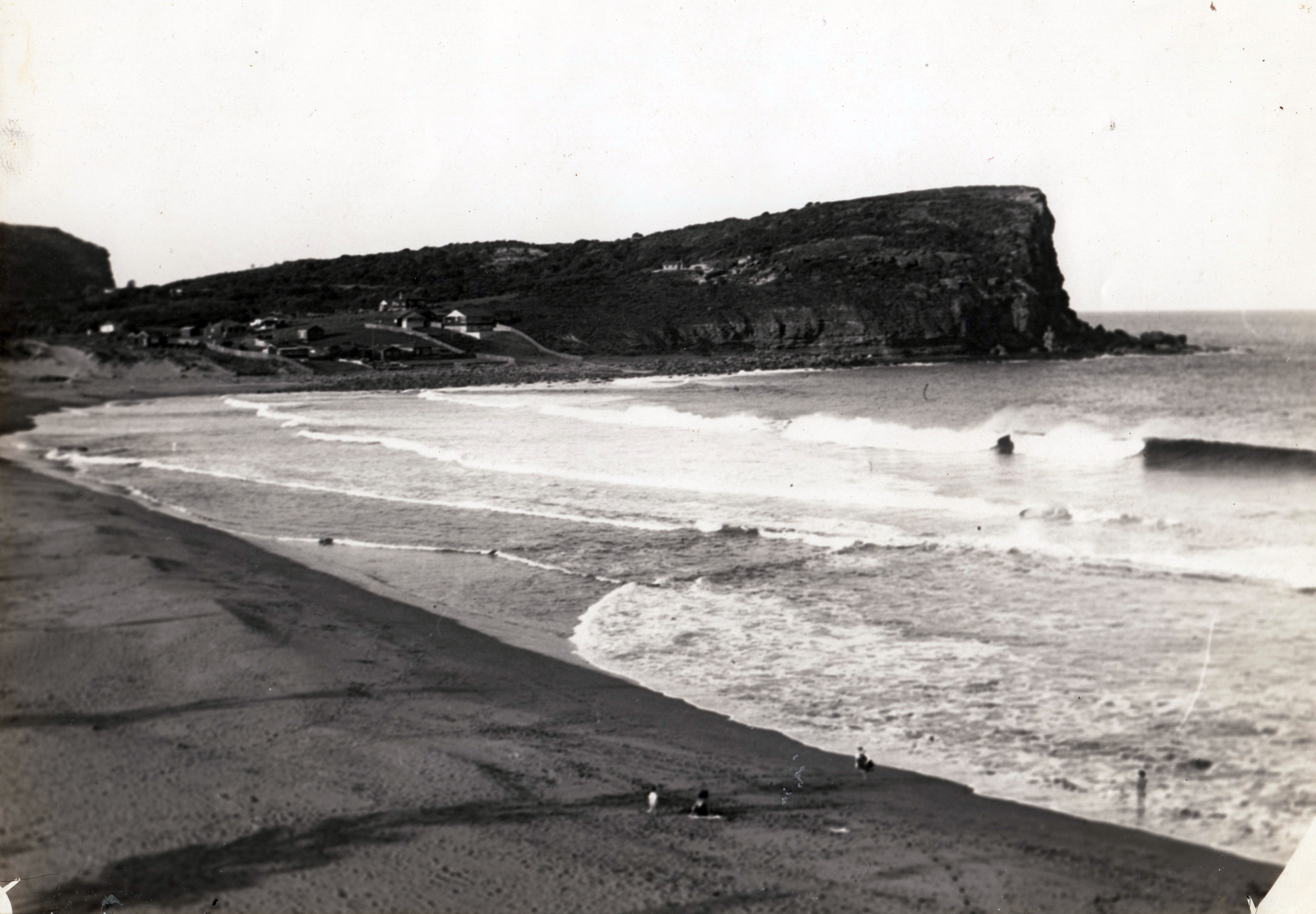
Avalon Beach circa 1920
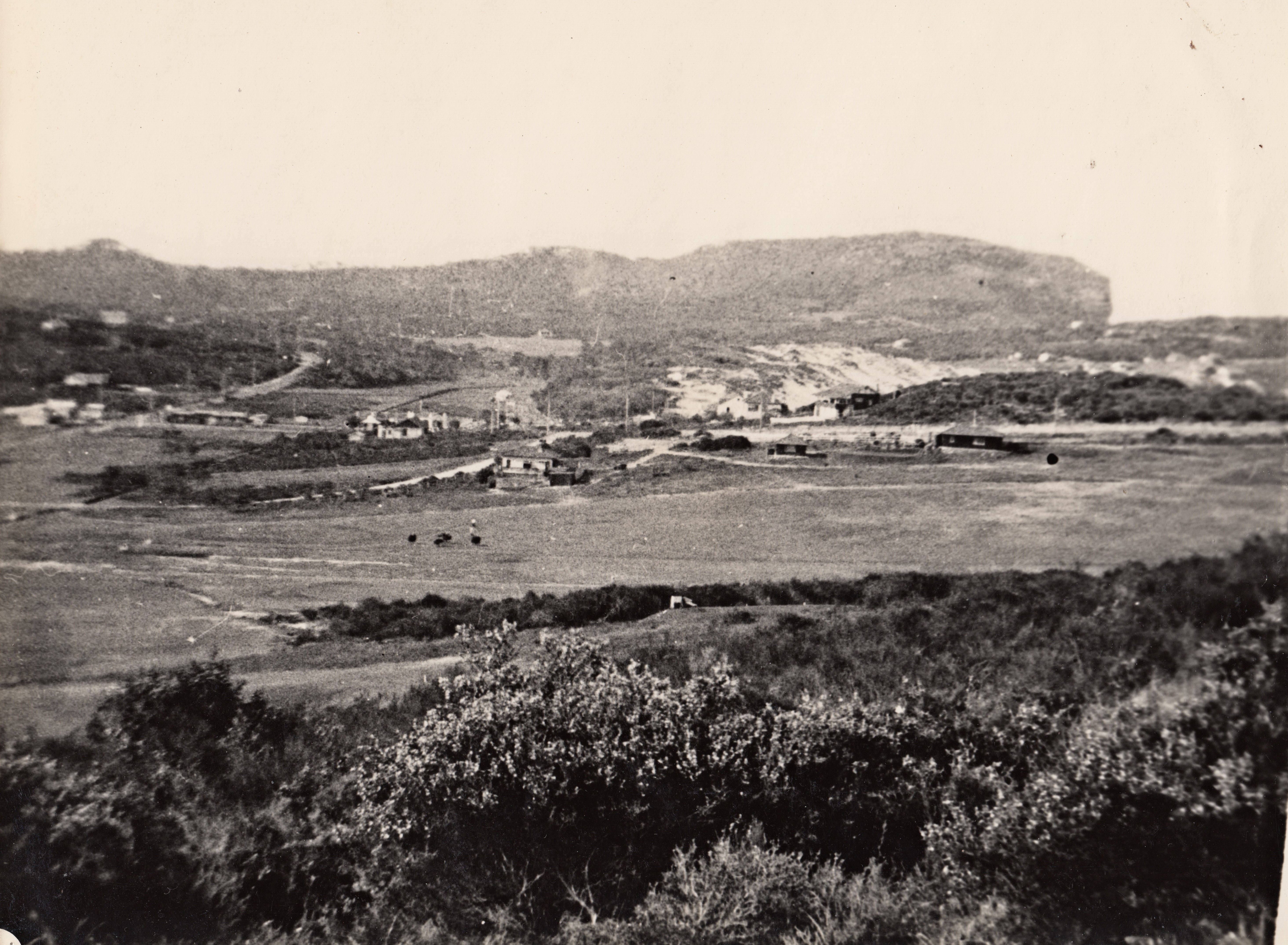
Avalon Beach circa 1930-35
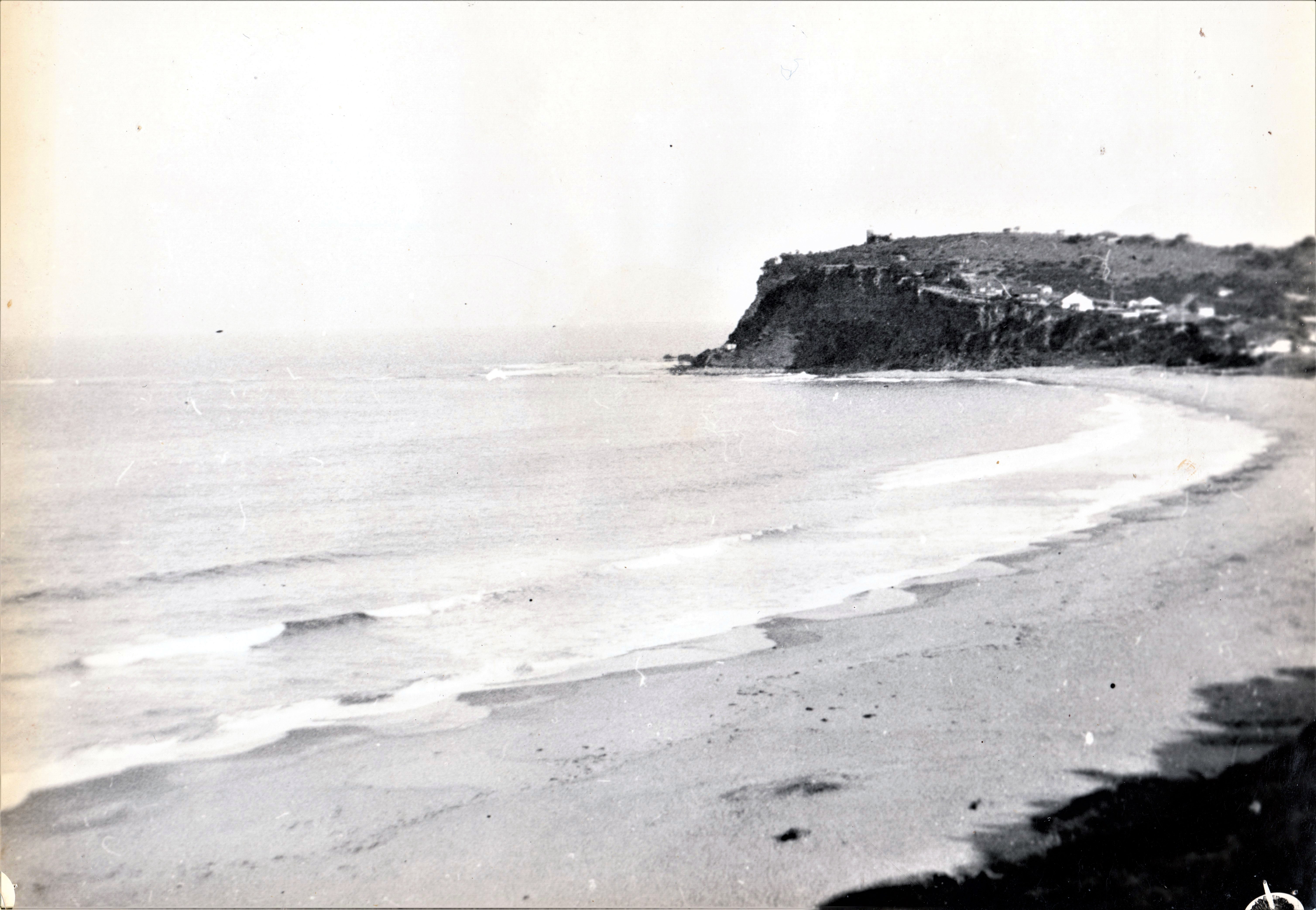
Newport Beach circa 1930-35
Gunjulla: The Grace family's The Tree, 1930-50
Gunjulla driveway 1930-40
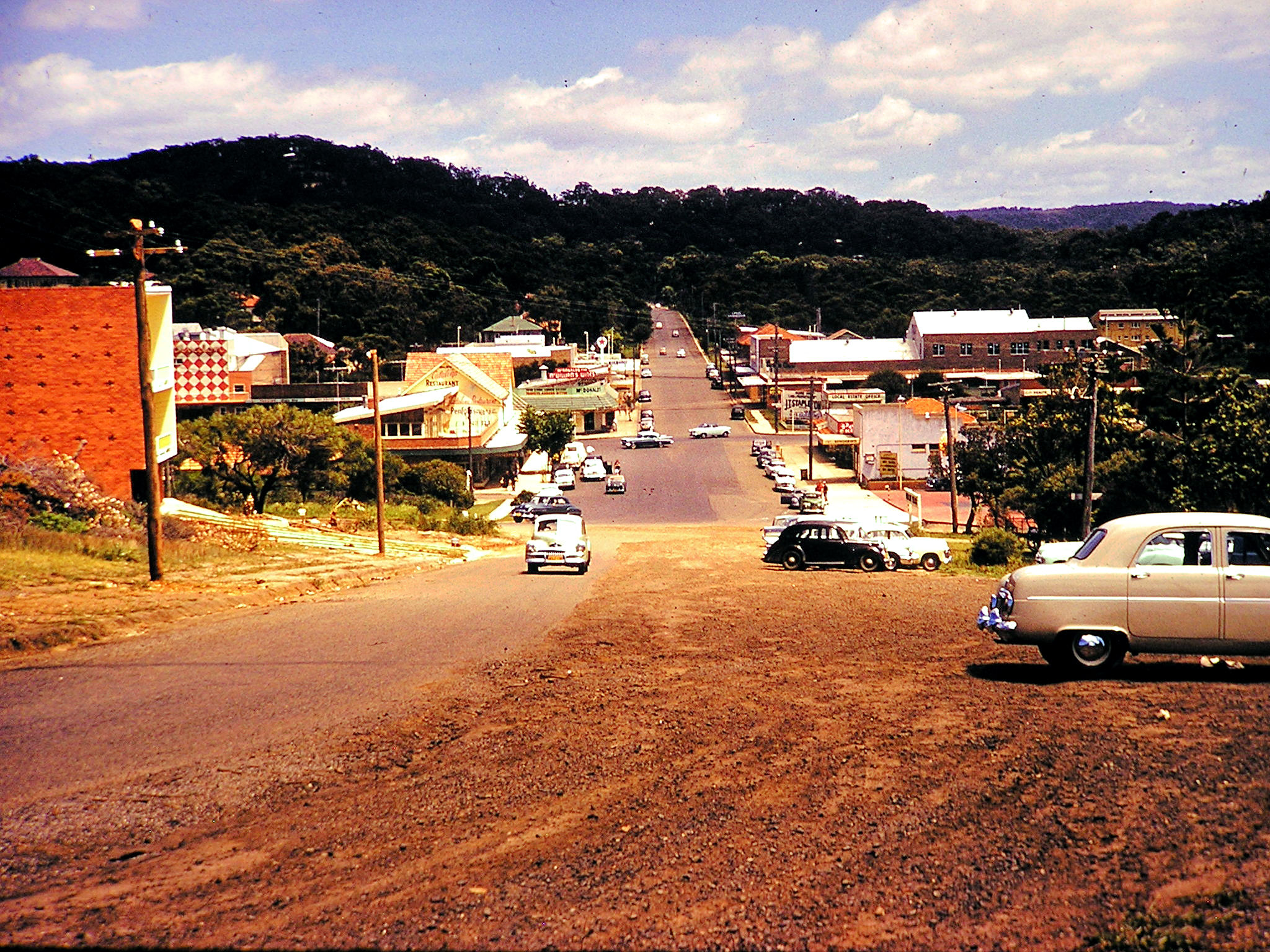
Avalon Beach - view down Avalon Parade, 1958
Ruskin Rowe - 1958-1960
Ruskin Rowe - 1958-1960
Ruskin Rowe - 1958-1960
Ruskin Rowe - 1958-1960
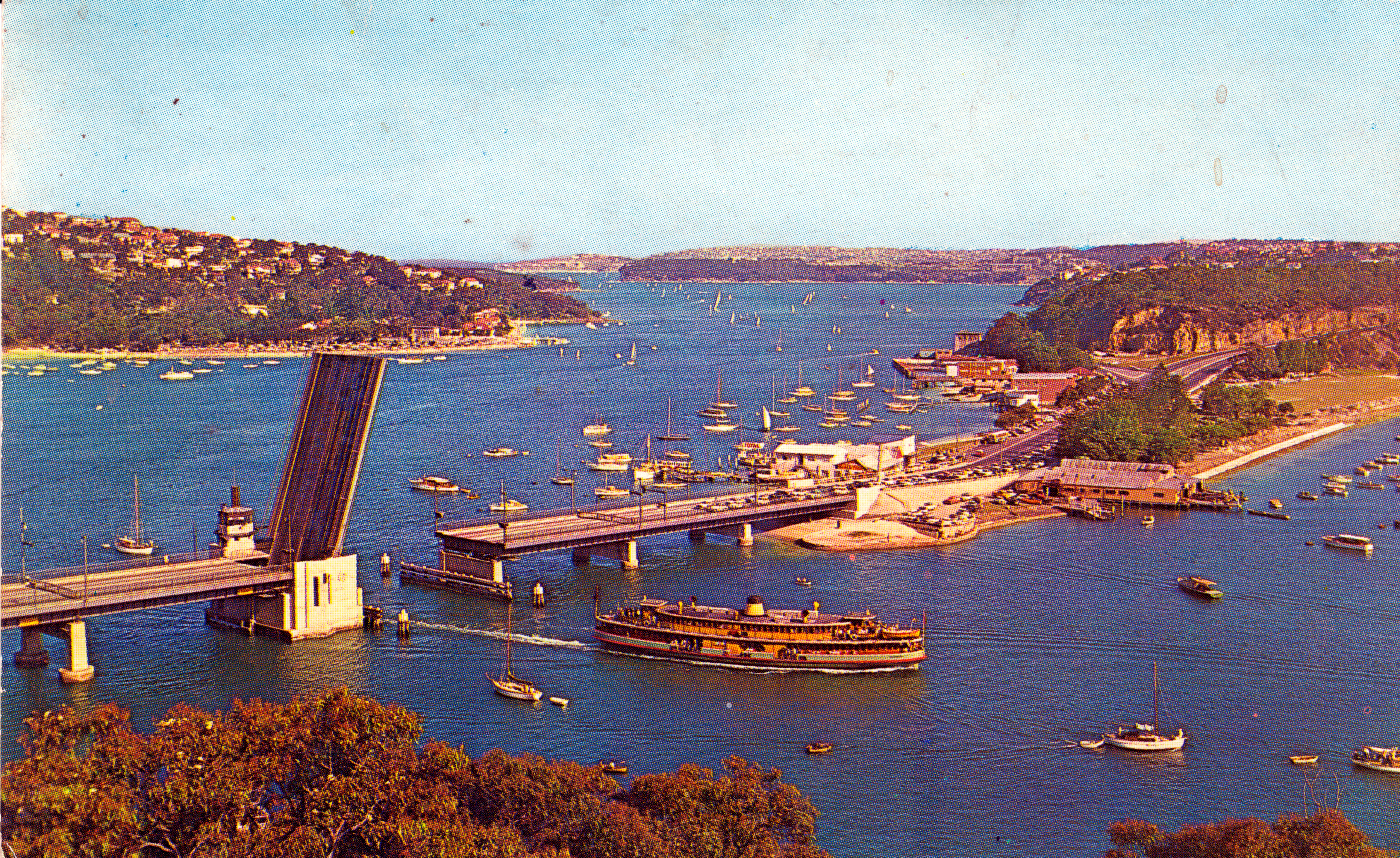
The Spit, 1960
Our HUGE thanks to Helen Grant and her mum Deborah for sharing these insights and family photos.
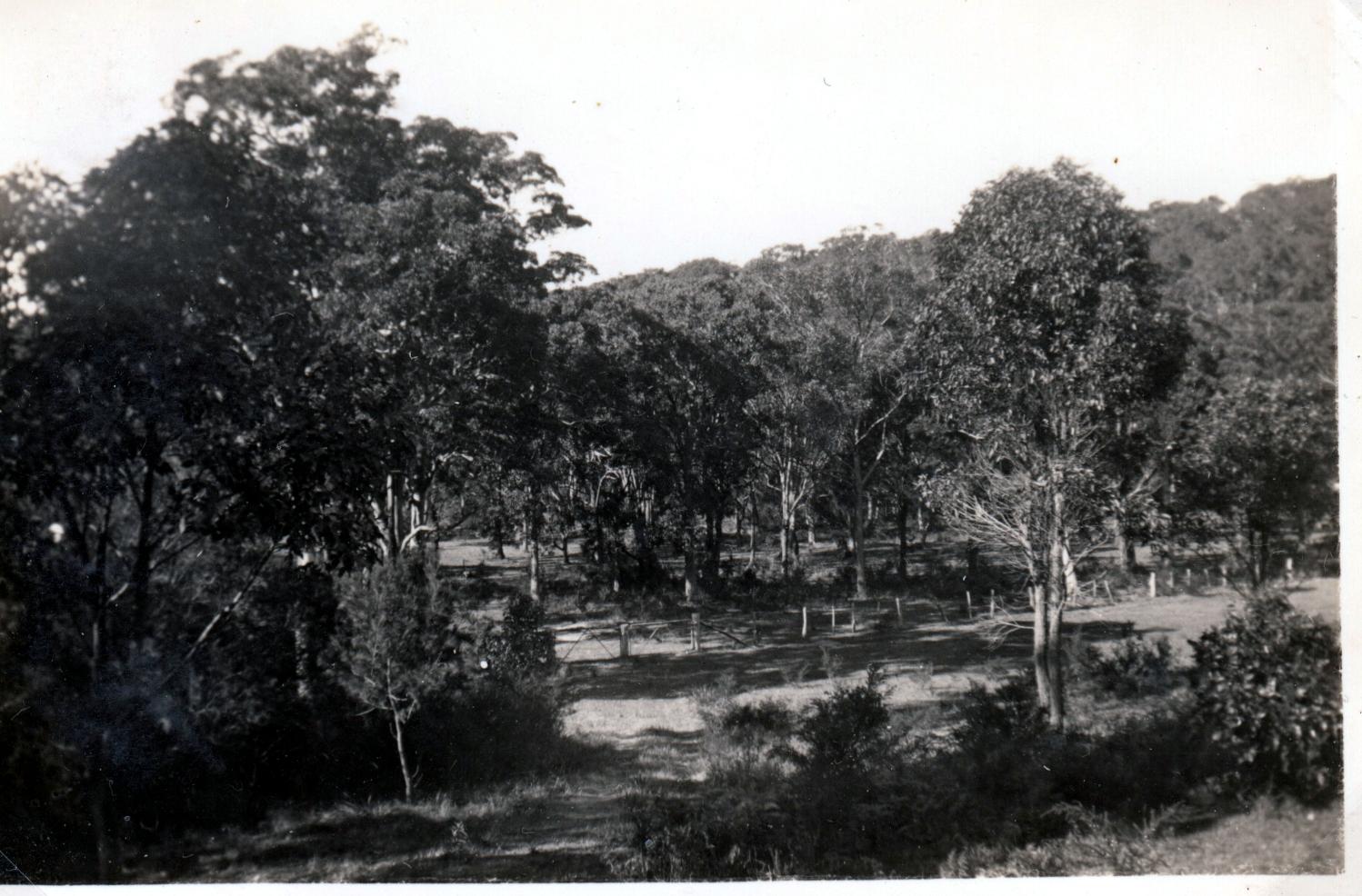
References + Extras
- Jennifer O'Callaghan, 'Grace, Henry Albert (1885–1966)', Australian Dictionary of Biography, National Centre of Biography, Australian National University, https://adb.anu.edu.au/biography/grace-henry-albert-12946/text23397
- Pittwater Roads II: Where The Streets Have Your Name - Avalon Beach
- Pittwater Roads II: Where the Streets Have Your name - Clareville
- Avalon Beach Surf Life Saving Club - The First Clubhouse
- Avalon's Village Green: Avalon Park Becomes Dunbar Park - Some History + Toongari Reserve and Catalpa Reserve
- The Clareville/Long Beach Reserve: some History - where name for Arnold Road came from
- Avalon Beach Golf Links: Pittwater Fields of Dreams II
- Avalon Beach Public School: Some History For A 70th Birthday
- Pittwater Aviatrixes On The Eve Of The RAAF's 100th: A NSW Women's Week - Women Of Aviation Week Celebration
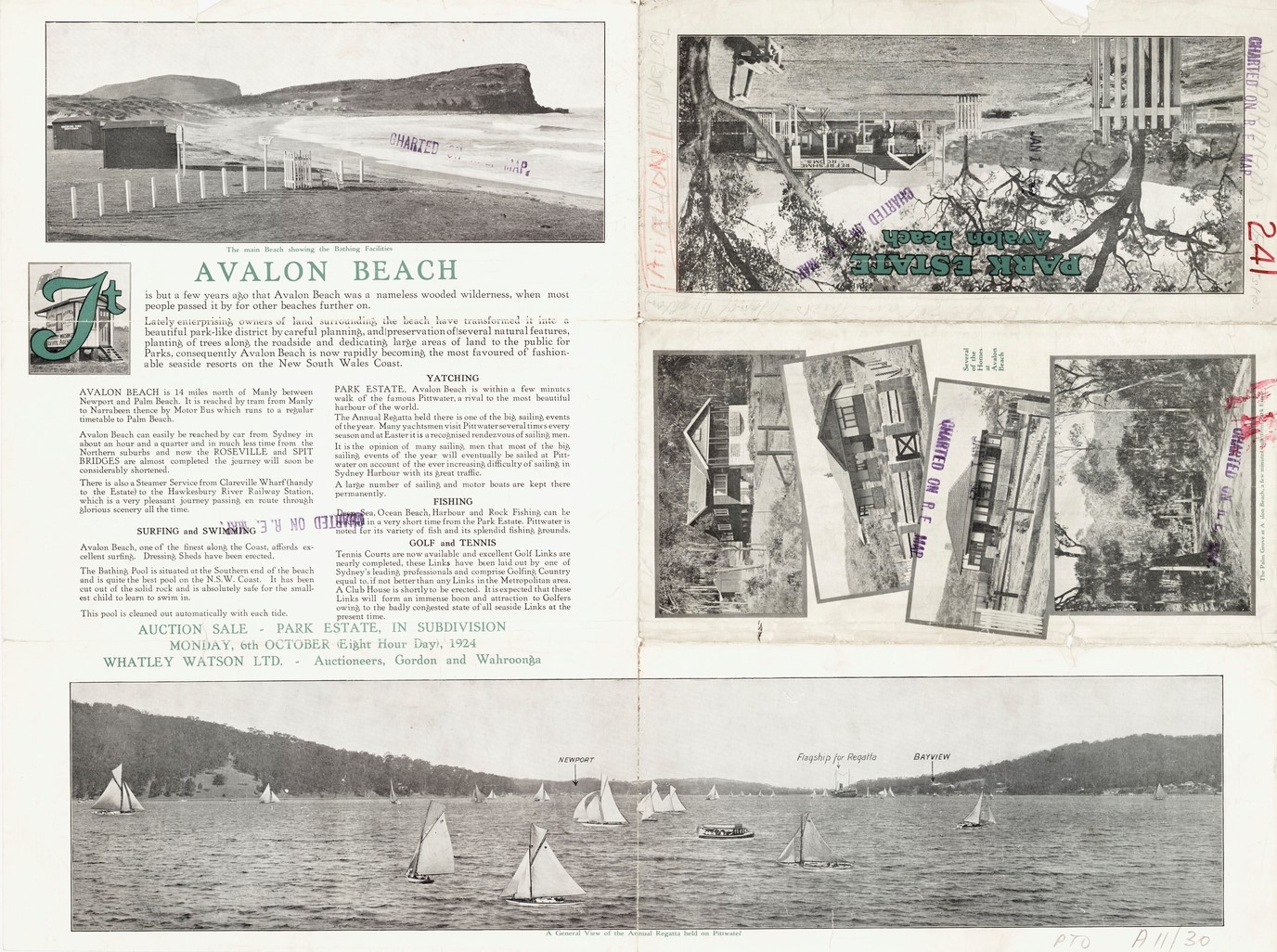
.jpg?timestamp=1554255202751)
.jpg?timestamp=1554255472759)
.jpg?timestamp=1554255917426)
.jpg?timestamp=1554255953992)
.jpg?timestamp=1554258029036)
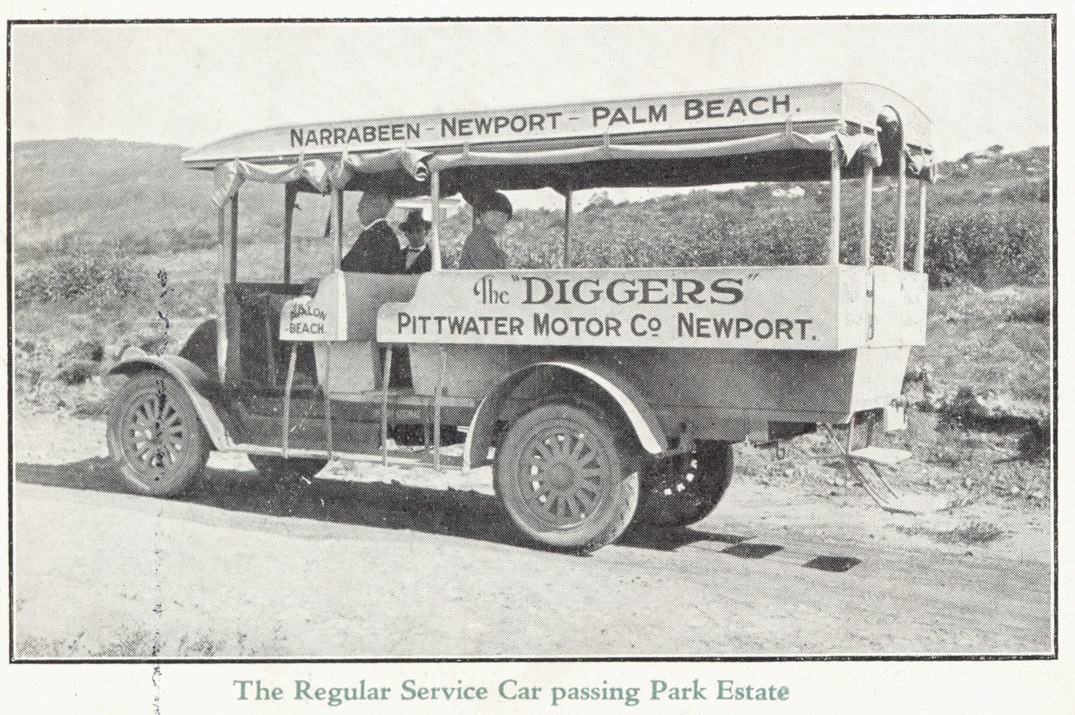
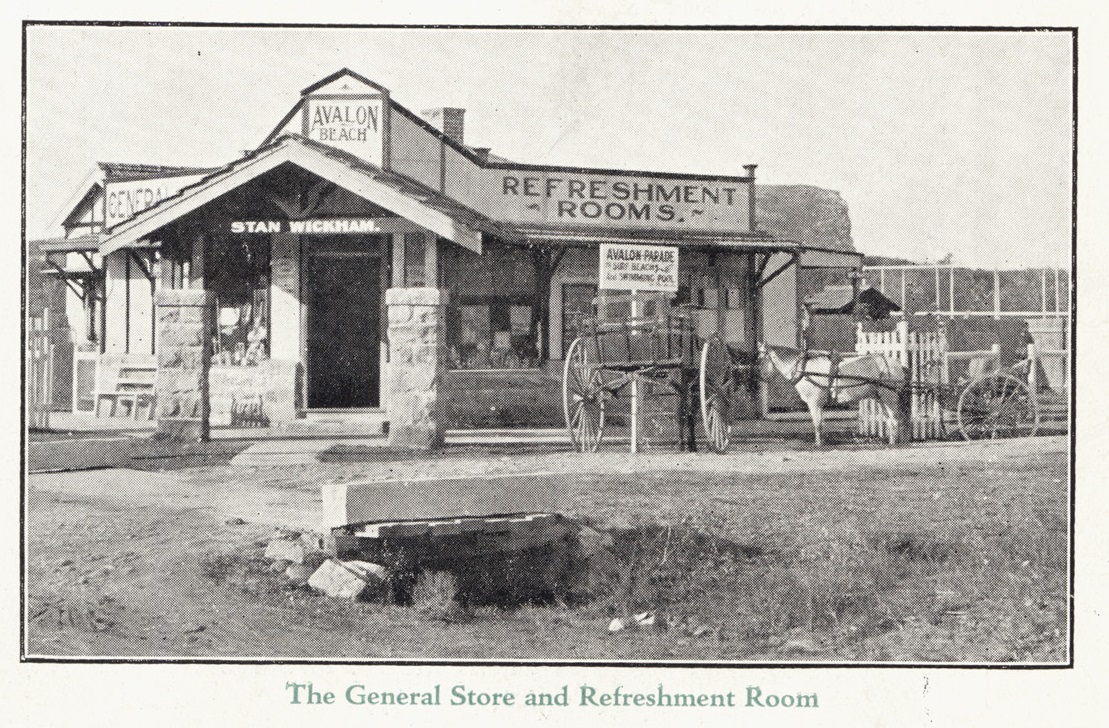
Albert Henry Grace Notes
Albert Henry Grace was born in 1861 in Sydney to Henry and Eliza Grace. His father was a builder.
Parents marriage:
720/1855 V1855720 43B GRACE HENRY WRIGHT ELIZA MF
Children of the union:
GRACE ELIZA J 1212/1856 HENRY ELIZA SYDNEY
GRACE ELIZABETH A 987/1859 HENRY ELIZA SYDNEY
GRACE ALBERT H 1148/1861 HENRY ELIZA SYDNEY
GRACE LILLA L 881/1863 HENRY ELIZA SYDNEY
GRACE JOSEPH E 1079/1865 HENRY ELIZA SYDNEY
GRACE WALTER G 645/1867 HENRY ELIZA SYDNEY
GRACE ERNEST H 875/1869 HENRY ELIZA SYDNEY
GRACE FREDERICK L 765/1871 HENRY ELIZA SYDNEY
GRACE ARTHUR F 1497/1873 HENRY ELIZA SYDNEY
GRACE HAROLD PERCY 2444/1876 HENRY ELIZA SYDNEY
His father passed away when he was still very young:
GRACE.— June 29, at his residence, 54, Botany-street, Surry Hills, Mr. Henry Grace, aged 48 years. Family Notices (1879, June 30). Evening News (Sydney, NSW : 1869 - 1931), p. 2. Retrieved from http://nla.gov.au/nla.news-article107153167
GRACE.—June 29, at his residence, 54, Botany-street, Surry Hills, Mr. Henry Grace, builder, aged 48 years, native of Hampshire, England. Family Notices (1879, June 30). The Sydney Morning Herald (NSW : 1842 - 1954), p. 1. Retrieved from http://nla.gov.au/nla.news-article13437487
THE FRIENDS of the late Mr. HENRY GRACE, Builder, are respectfully invited to attend his Funeral ; to move from his late residence, 54, Botany-street, Surry Hills, THIS (Monday) AFTERNOON, at 2 o'clock, and proceed to the Mortuary, per train to the Necropolis. C. KINSELA and SONS, 118, Oxford-street; and George-street.
LOYAL ROSE OF AUSTRALIA LODGE, No. 4024, I. O. O. F., M. U.-The Officers and Brothers of the above Lodge, together with the Officers and Brothers of the various Lodges, are requested to attend the Funeral of our late Brother, HENRY GRACE ; to move from No. 54, Botany-street, Surry Hills. Family Notices (1879, June 30). The Sydney Morning Herald (NSW : 1842 - 1954), p. 8. Retrieved from http://nla.gov.au/nla.news-article13437527
In the Supreme Court of New South Wales.
ECCLESIASTICAL JURISDICTION.
In the will of Henry Grace, late of 54, Botany-street, Surry Hills, in the city of Sydney, in the Colony of New South Wales, builder, deceased.
NOTICE is hereby given, that after the expiration of fourteen days from the publication hereof, application will be made to this Honorable Court, in its Ecclesiastical Jurisdiction, that probate of the last will and testament of the abovenamed Henry Grace, deceased, may be granted to Eliza Grace, Gilbert Hair, and Hugh McMaster, the executrix and executors therein mentioned.—Dated this 7th day of July, a.d. 1879.
RICHARD DRIVER, Proctor for the Executrix and Executors, 176, Pitt-street, Sydney. ECCLESIASTICAL JURISDICTION. (1879, July 8). New South Wales Government Gazette (Sydney, NSW : 1832 - 1900), p. 2995. Retrieved from http://nla.gov.au/nla.news-article223433391
Worth noting 'Goods sworn as under £1200.00’, although Albert Henry would later sell lands at Surry Hills, in 1910 and 1922. He also held land at St Leonards.
Mother’s death: GRACE ELIZA 12655/1920 parents: (WRIGHT) 87 YRS RANDWICK RANDWICK
GRACE.— August 24th, 1920, at her late residence, "Glanton," Dutruc Street, Randwick, Eliza Grace, widow of the late Henry Grace, Builder, aged 87 years. Family Notices (1920, August 25). The Daily Telegraph (Sydney, NSW : 1883 - 1930), p. 8. Retrieved from http://nla.gov.au/nla.news-article239697518
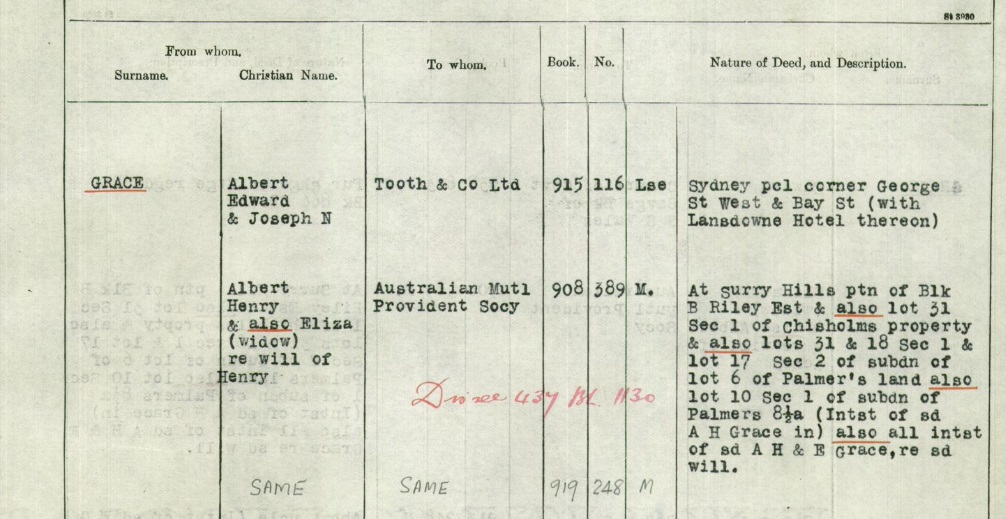
1910
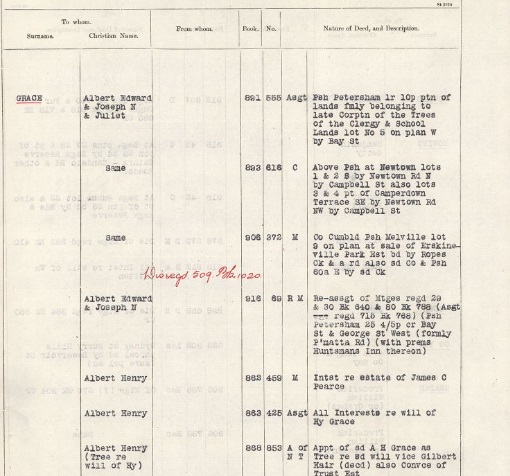
1910 - some of these he was acting in his capacity as a solicitor
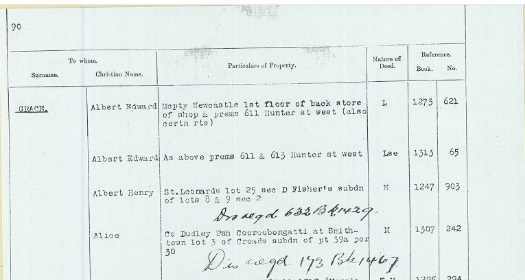
1920
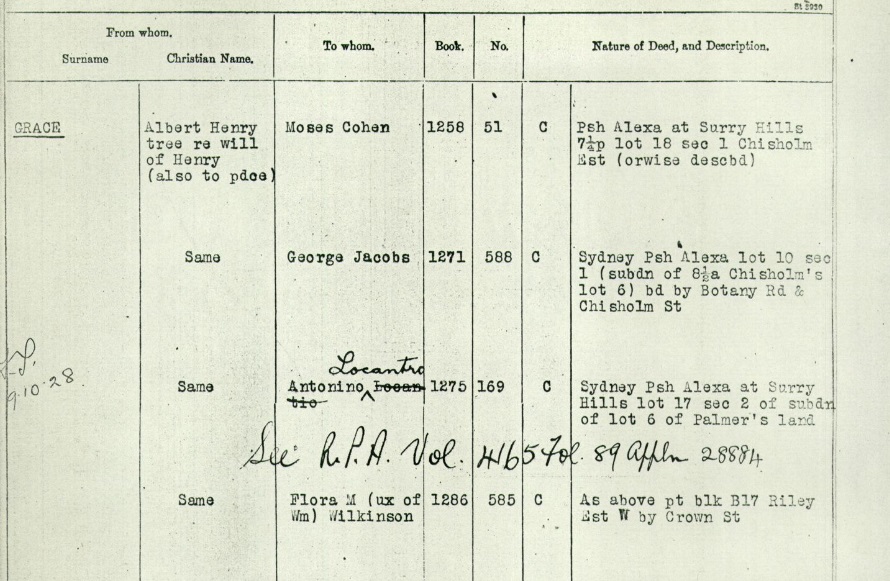
1922
Marriage of Albert and Catherine: 5105/1884 GRACE ALBERT H MUIRSEN CATHERINE R MOREE
GRACE-MUIRSON.-September 16th, at the residence of the bride's parents, Moree, by the Rev. T. M. Davies, Albert Henry Grace, of Moree, solicitor, eldest son of the late Henry Grace, of Sydney, to Catherine Ruth, youngest daughter of Kenneth Muirson, of Moree. Family Notices (1884, September 20). The Sydney Morning Herald (NSW : 1842 - 1954), p. 1. Retrieved from http://nla.gov.au/nla.news-article13562454
Children of the union:
GRACE RUBY M9089/1895 ALBERT HCATHERINE RWOLLONGONG
GRACE EDITH M23006/1887 ALBERT HCATHERINE RMOREE
GRACE ADA F22404/1889 ALBERT HCATHERINEMOREE
GRACE HAROLD A22558/1891 ALBERT HCATHERINE RMOREE
GRACE HENRY A999999/1885 D188500311ALBERT HCATHERINE R
Catherine Ruth Grace passed away in 1949. Albert Henry Grace passed away in 1955.
This is their daughter 'Ada' being referred to as Mrs. Keyworth, married in 1915 to Frank Keyworth:
OBITUARY
MRS. C. R. GRACE
The many friends of Mrs. F. L. Keyworth will regret to hear that her mother Mrs. Catherine Ruth Grace, died on Saturday aged 93 years. Mrs. Grace leaves a husband who is in his 96th year, two sons and three daughters, together with several grandchildren and great grand-children.
The remains were cremated at the Northern Suburbs Crematorium. Mrs. Keyworth, who has been with her parents for several weeks, is expected home shortly. OBITUARY (1949, August 23). The Dubbo Liberal and Macquarie Advocate (NSW : 1894 - 1954), p. 3. Retrieved from http://nla.gov.au/nla.news-article131359012
Deborah Sarah Grace married David Forrest Grant in 1952, the marriage was registered at Sutherland.
GRANT-GRACE. - The Engagement is announced of Deborah, youngest daughter of Mr. and Mrs. Henry Grace, of Jannali, to David, only son of Mrs. Barbara Grant and the late Mr. Adam Grant, of Bellevue Hill. Family Notices (1952, January 5). The Sydney Morning Herald (NSW : 1842 - 1954), p. 34. Retrieved from http://nla.gov.au/nla.news-article18261049
Harry Ruskin Rowe: Purchase Of Grace Holdings
Harry Ruskin Rowe - lands at Avalon Beach, which he commenced selling off in March 1950. Visit, VP Day 2019: Anthony Thomas Ruskin Rowe, Spitfire Pilot (1919 To 1943) - Who Defended Darwin And His Mate: An Avalon Beach And Pittwater Hero
From HRLV:
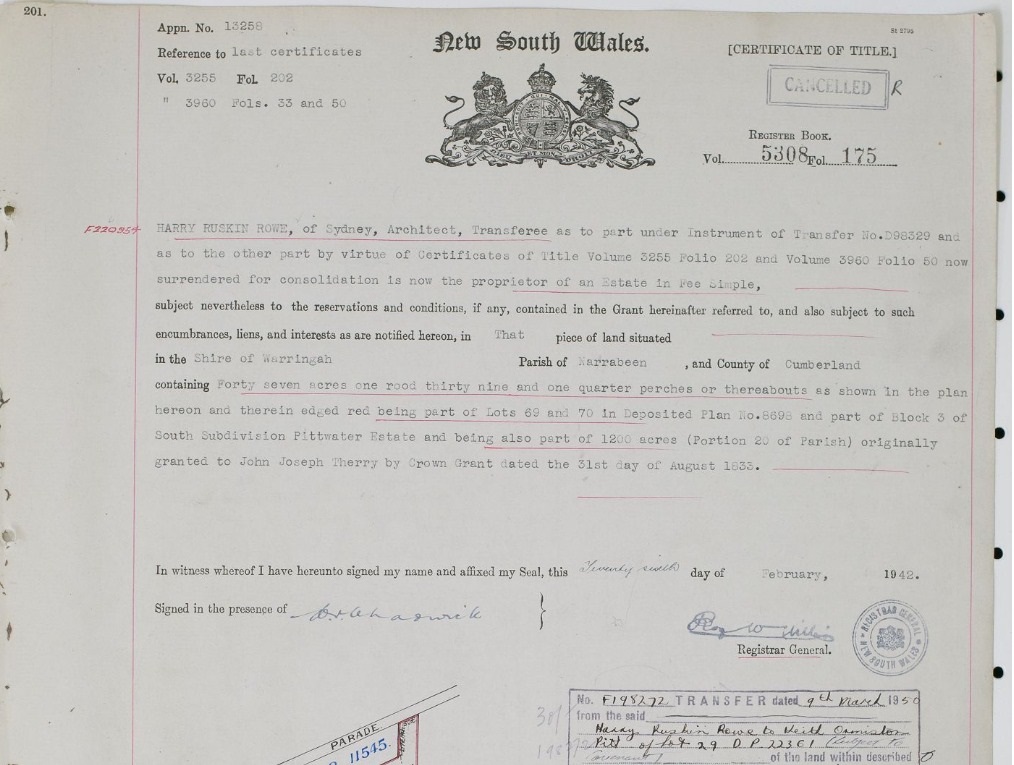
%20Harry%20Ruskin%20Rowe%20land%20at%20Avalon%201st.jpg?timestamp=1637209850242)
%20Harry%20Ruskin%20Rowe%20land%20at%20Avalon%201st.jpg?timestamp=1637209887208)
%20Harry%20Ruskin%20Rowe%20land%20at%20Avalon%201st.jpg?timestamp=1637209919859)
Lillie Marion Searle (1883 - 1979) - residue of holding and Gunjulla home and tenants Laurence Minot Quillan and Margaret Louise Smith:
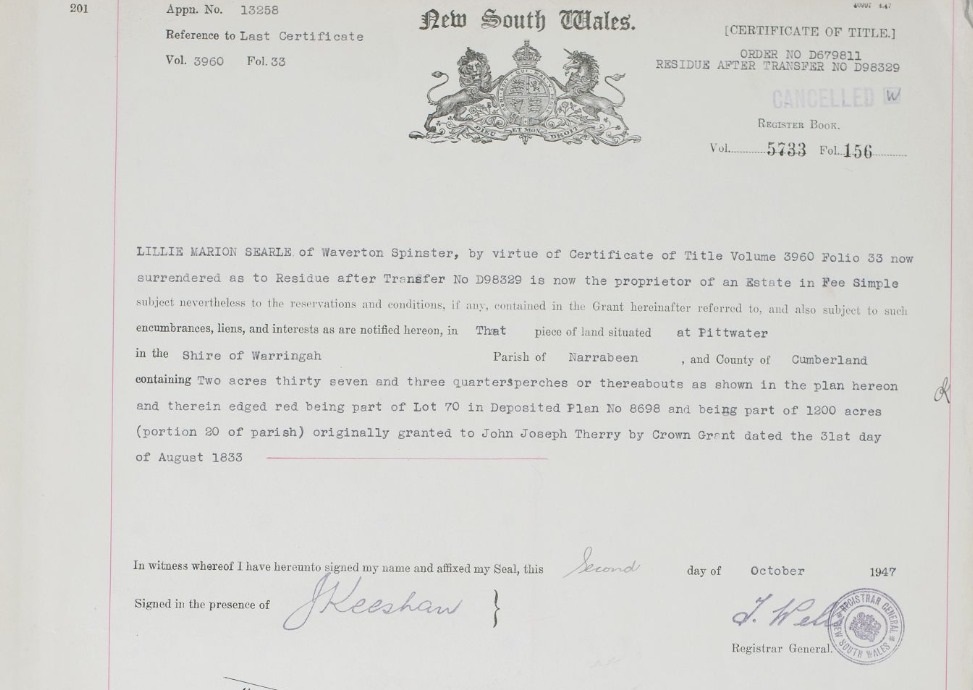
%20Lillie%20Marion%20Searle.jpg?timestamp=1637210484718)
In 1962 the estate changed hands again, Laurence Minot Quillan becoming owner:
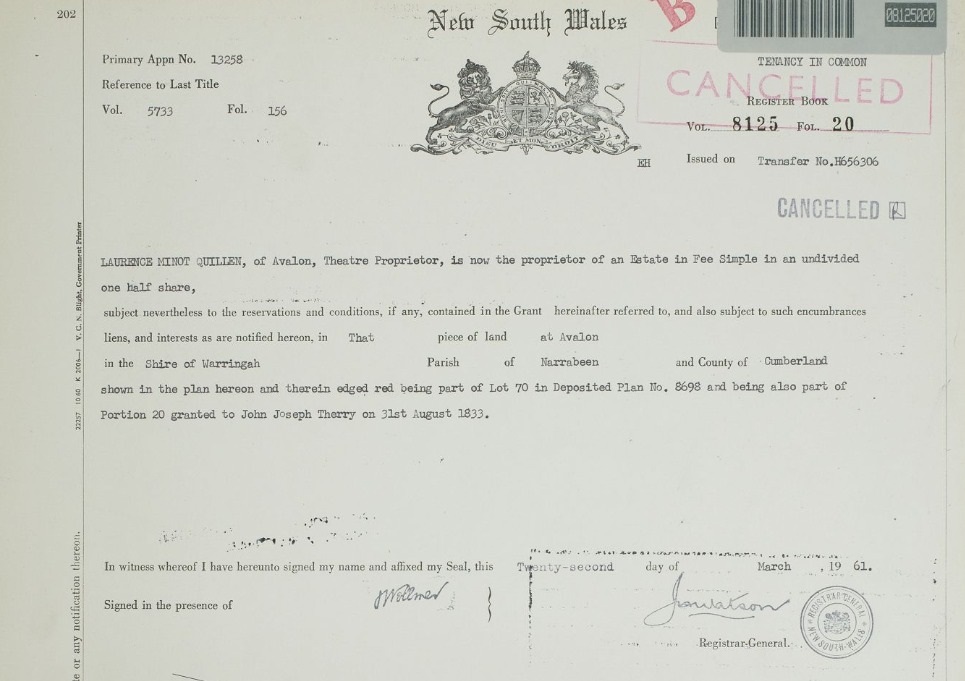
%20Laurence%20Minot%20Quillan.jpg?timestamp=1637210868483)
Mr Quillan was involved in the construction and running of Avalon Picture Theatre:
(3) Mr. Arnold Gladstone Spry, 184 Wyndora-avenue, Harbord, in respect of a proposed picture theatre to be situated in Old Barrenjoey road, Avalon Beach. Proposed seating accommodation, 750. THEATRES AND PUBLIC HALLS ACT, 1908-1946. (1953, May 1). Government Gazette of the State of New South Wales (Sydney, NSW : 1901 - 2001), p. 1436. Retrieved from http://nla.gov.au/nla.news-article220014243
Name and Address of Applicant.
(1) Mr. Arnold Gladstone Spry, 184 Wyndora Avenue, Harbord. - Proposed picture theatre, Old Barrenjoey road, Avalon Beach. Granted. THEATRES AND PUBLIC HALLS ACT, 1908-1946. (1953, August 14). Government Gazette of the State of New South Wales (Sydney, NSW : 1901 - 2001), p. 2601. Retrieved from http://nla.gov.au/nla.news-article220067726
(2) Application under paragraph (c) for the approval of alterations designed to provide additional seating accommodation made by Mr. Arnold Gladstone Spry, 184 Wyndora-avenue,Harbord, in respect of a proposed picture theatre to be situated in Old Barrenjoey road, Avalon Beach. Approved seating accommodation, 740. Additional seating applied for, 84. THEATRES AND PUBLIC HALLS ACT, 1908-1946. (1954, January 29). Government Gazette of the State of New South Wales (Sydney, NSW : 1901 - 2001), p. 287. Retrieved from http://nla.gov.au/nla.news-article220289167
2) Mr. Arnold Gladstone Spry, 184 Wyndora avenue, Harbord. Proposed picture theatre, Old Barrenjoey-road, Avalon Beach. The approval of alterations designed to provide additional seating accommodation. Granted. THEATRES AND PUBLIC HALLS ACT, 1908-1946. (1954, March 26). Government Gazette of the State of New South Wales (Sydney, NSW : 1901 - 2001), p. 975. Retrieved from http://nla.gov.au/nla.news-article220290887
Avalon Beach Cinema; Opening of Avalon Cinema Theatre – Adele Spry's father Arnold Spry built this with partner Larry Quillen. Photos courtesy Geoff Searl, Avalon Beach Historical Society.
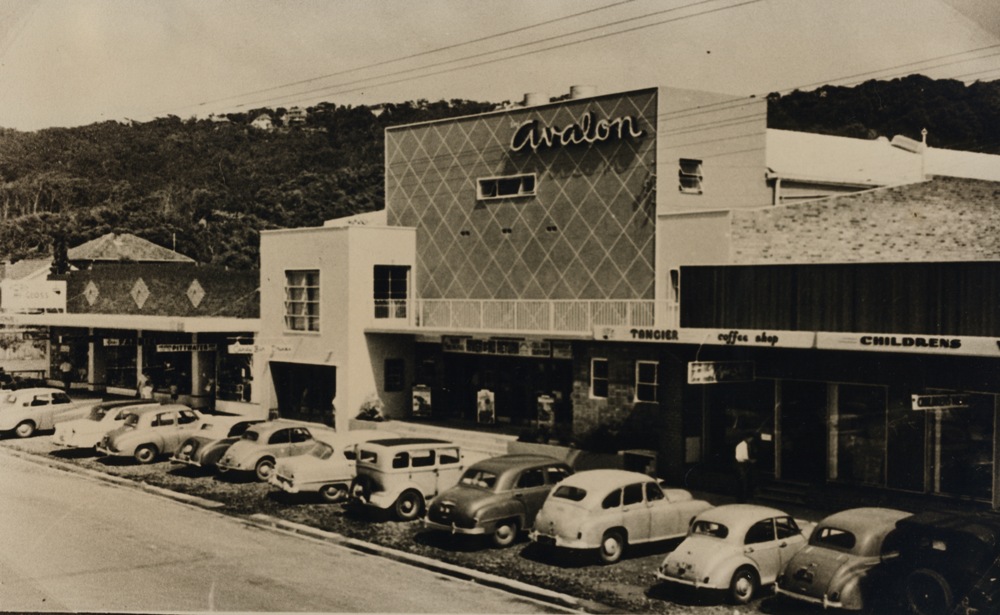
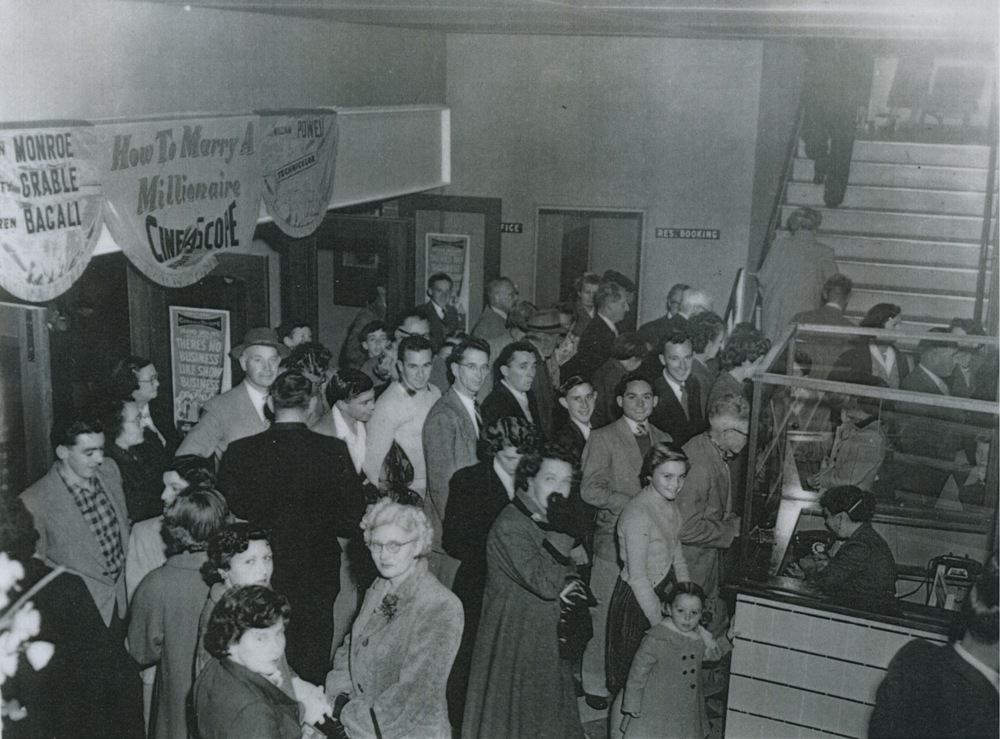
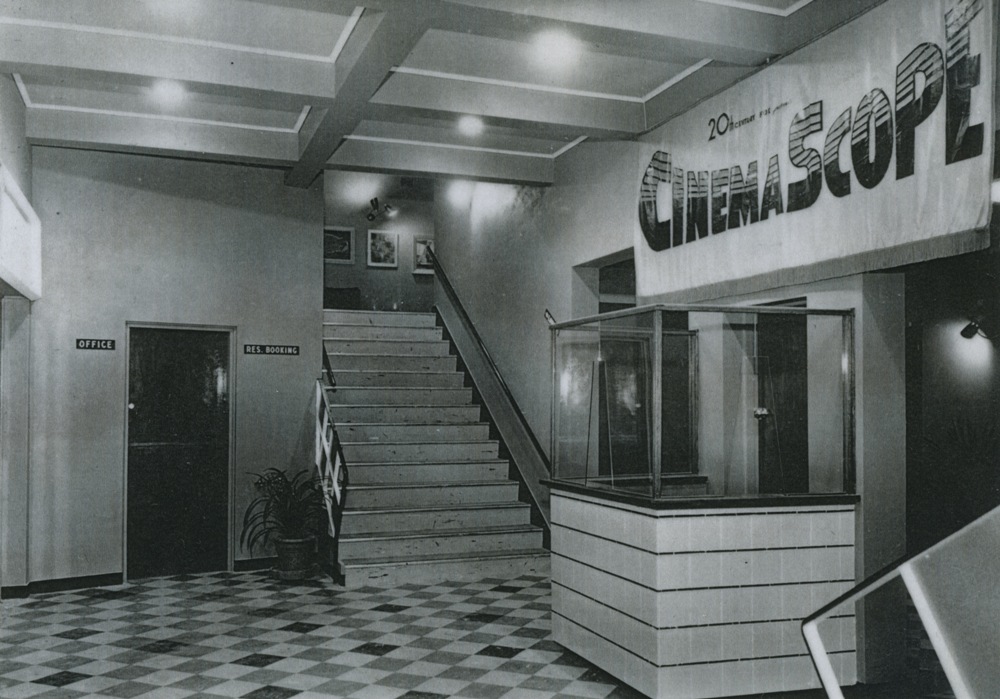
Gunjulla Place, 2021
A J Guesdon photos